 Dr. Jeff Harper | Comments Off |
Dr. Jeff Harper | Comments Off | My most current blog entry:
Entries by Dr. Jeff Harper (343)
Chinese New Year in Bangkok's Chinatown
 Wednesday, February 1, 2023 at 10:36AM
Wednesday, February 1, 2023 at 10:36AM 
I saw this in my feed online and thought it might be interesting to go to the Bangkok Chinatown for Chinese New Year. I had never been to Chinatown on Chinese New Years in all my years in Bangkok . . . plus, the Bangkok Chinatown is the largest Chinatown outside of China. I took the Bangkok underground and popped out . . .
[This trip was also an opportunity to test my new camera, the Fuji X-T5, in a variety of challenging lighting conditions: bright sunlight, deep shadow, and night street photography. The X-T5 takes 40mp photos, but are posted here in only 850px on the long edge. You be the judge . . . but I am very happy with the results!]
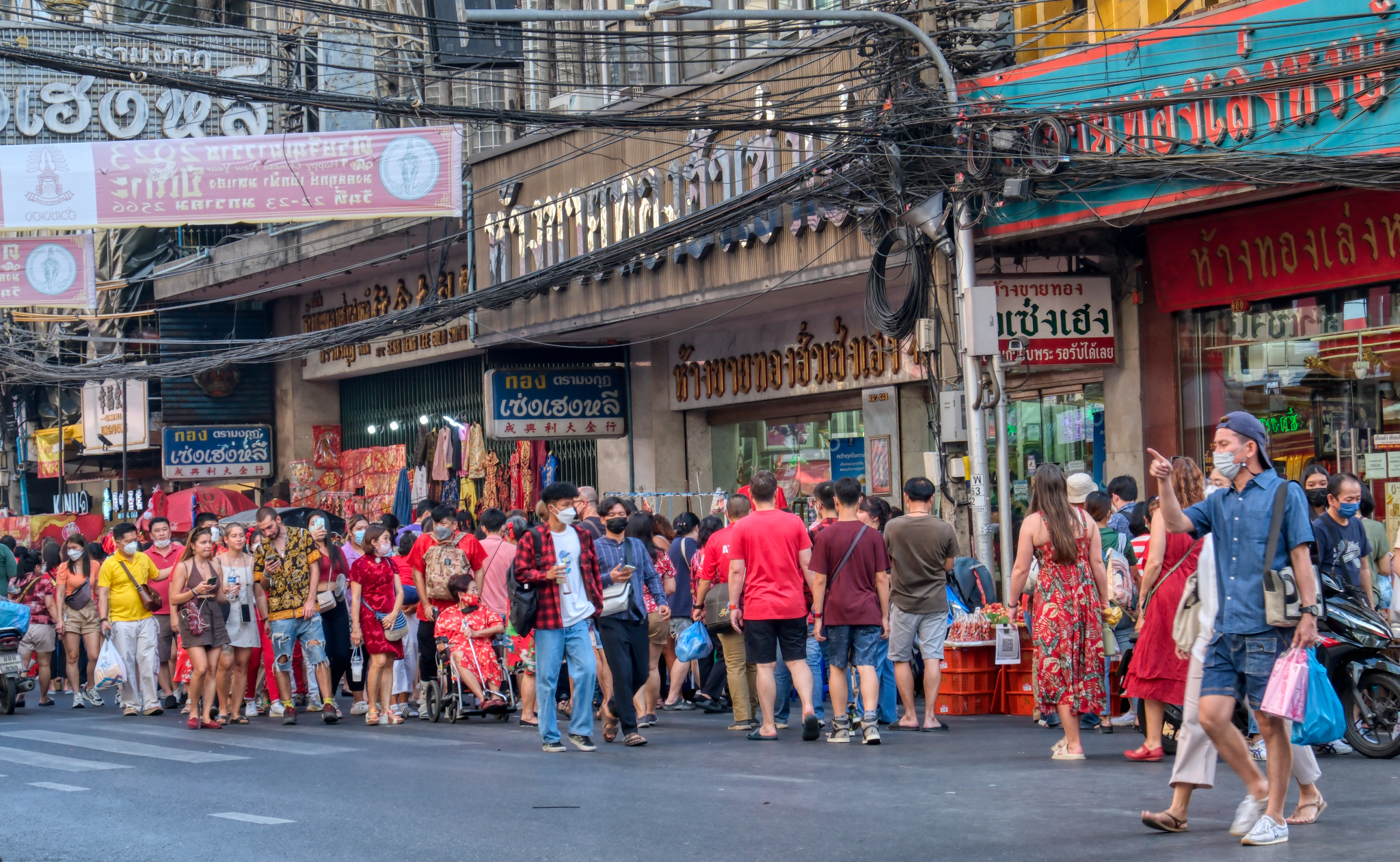 . . . I popped out a few blocks from the center of Chinatown . . . in the middle of a huge crowd. It seems that I was not the only one with the idea.
. . . I popped out a few blocks from the center of Chinatown . . . in the middle of a huge crowd. It seems that I was not the only one with the idea.
 Part of the crowd was congregating around this Chinese Temple. We found out that one of the Thai Royal Family was due to arrive there soon to pay respects. It was a big day in the Bangkok Chinatown.
Part of the crowd was congregating around this Chinese Temple. We found out that one of the Thai Royal Family was due to arrive there soon to pay respects. It was a big day in the Bangkok Chinatown.
 I was hot and thirsty so I bought a pomegranate juice and was happy.
I was hot and thirsty so I bought a pomegranate juice and was happy.
 We cut through an alley to get to the center of the action. The whole highly decorated area was a crush of people, many of whom were foreign tourists.
We cut through an alley to get to the center of the action. The whole highly decorated area was a crush of people, many of whom were foreign tourists.
 The many small Chinese temples were busy with devotees leaving alms and donations and being blessed by the monks.
The many small Chinese temples were busy with devotees leaving alms and donations and being blessed by the monks.
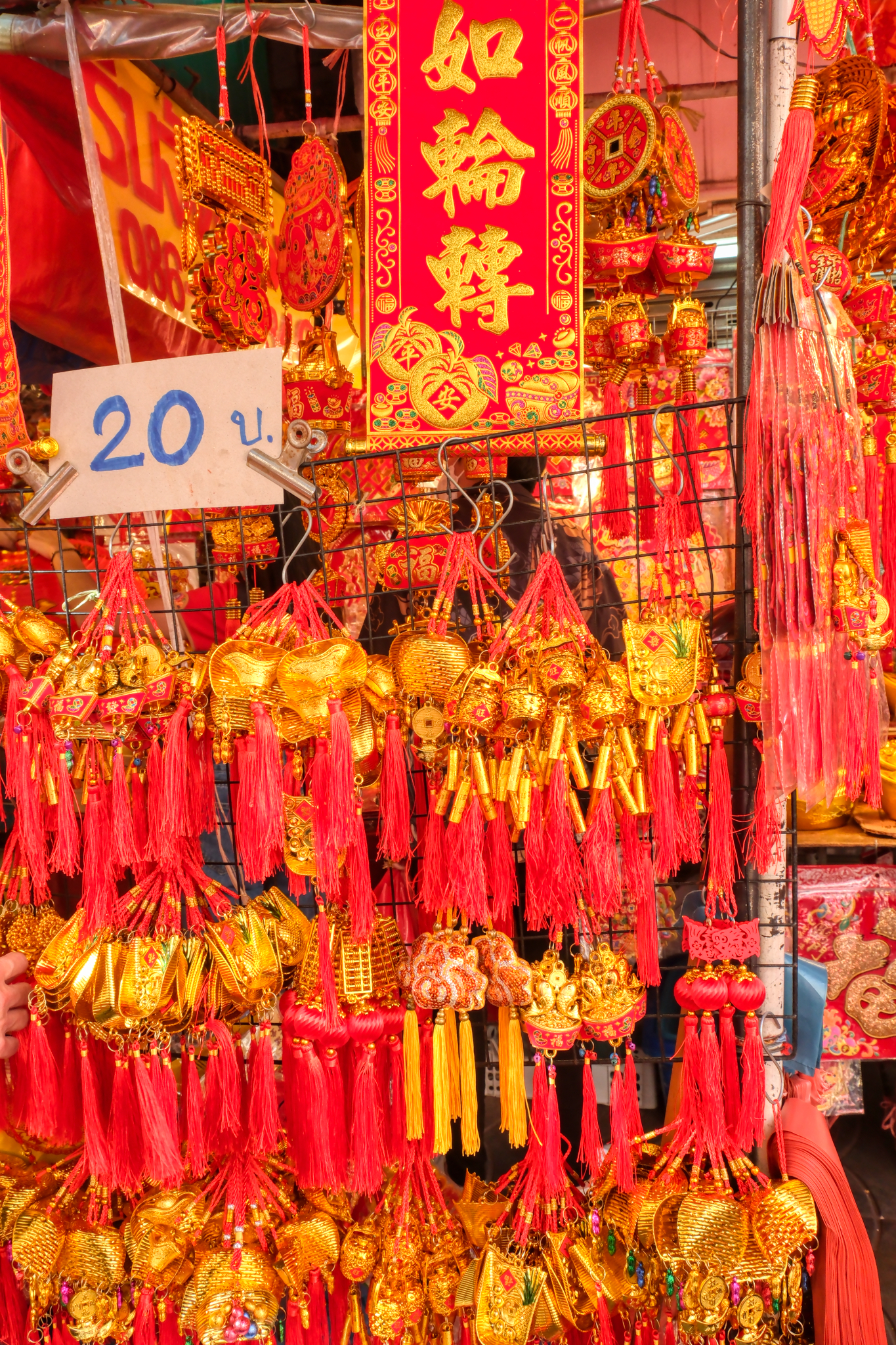 Every imaginable kind of 'altar toy' was for sale in gold and red. Fantastic!
Every imaginable kind of 'altar toy' was for sale in gold and red. Fantastic!
 This good natured monk seemed to enjoy giving water blessings to whomever stopped and donated.
This good natured monk seemed to enjoy giving water blessings to whomever stopped and donated.
 We explpored deep down the beautifully decorated side streets of Bangkok's Chinatown.
We explpored deep down the beautifully decorated side streets of Bangkok's Chinatown.
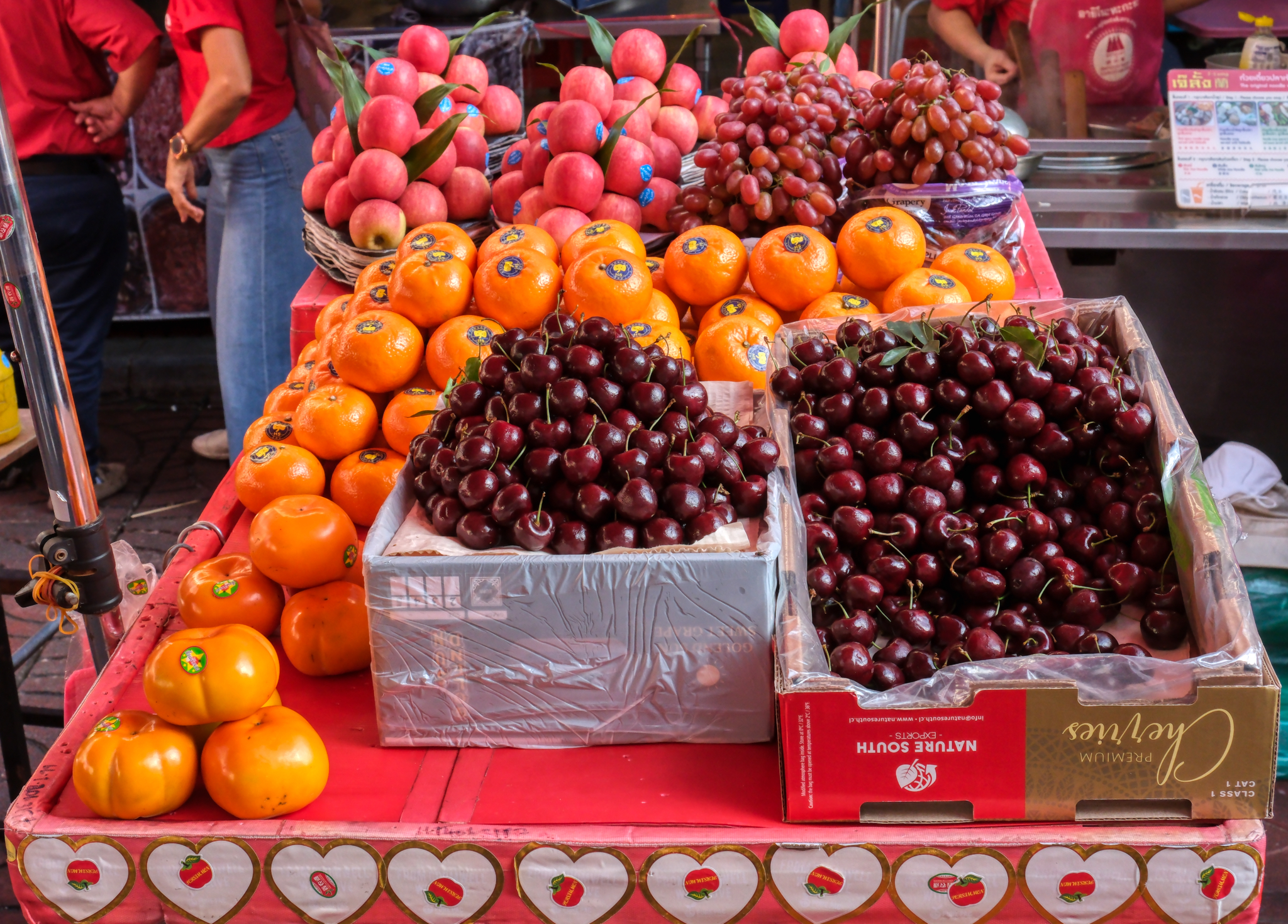 Chinese New Year is a traditional time for fruit purchasing, apparently.
Chinese New Year is a traditional time for fruit purchasing, apparently.
 These ice blocks sitting in an alley looked inviting . . . as a shortcut over to the next street . . . and as a way of avoiding the crushing crowds.
These ice blocks sitting in an alley looked inviting . . . as a shortcut over to the next street . . . and as a way of avoiding the crushing crowds.
 Chinatown alleys always offer up surprise images, like this very old small industry.
Chinatown alleys always offer up surprise images, like this very old small industry.
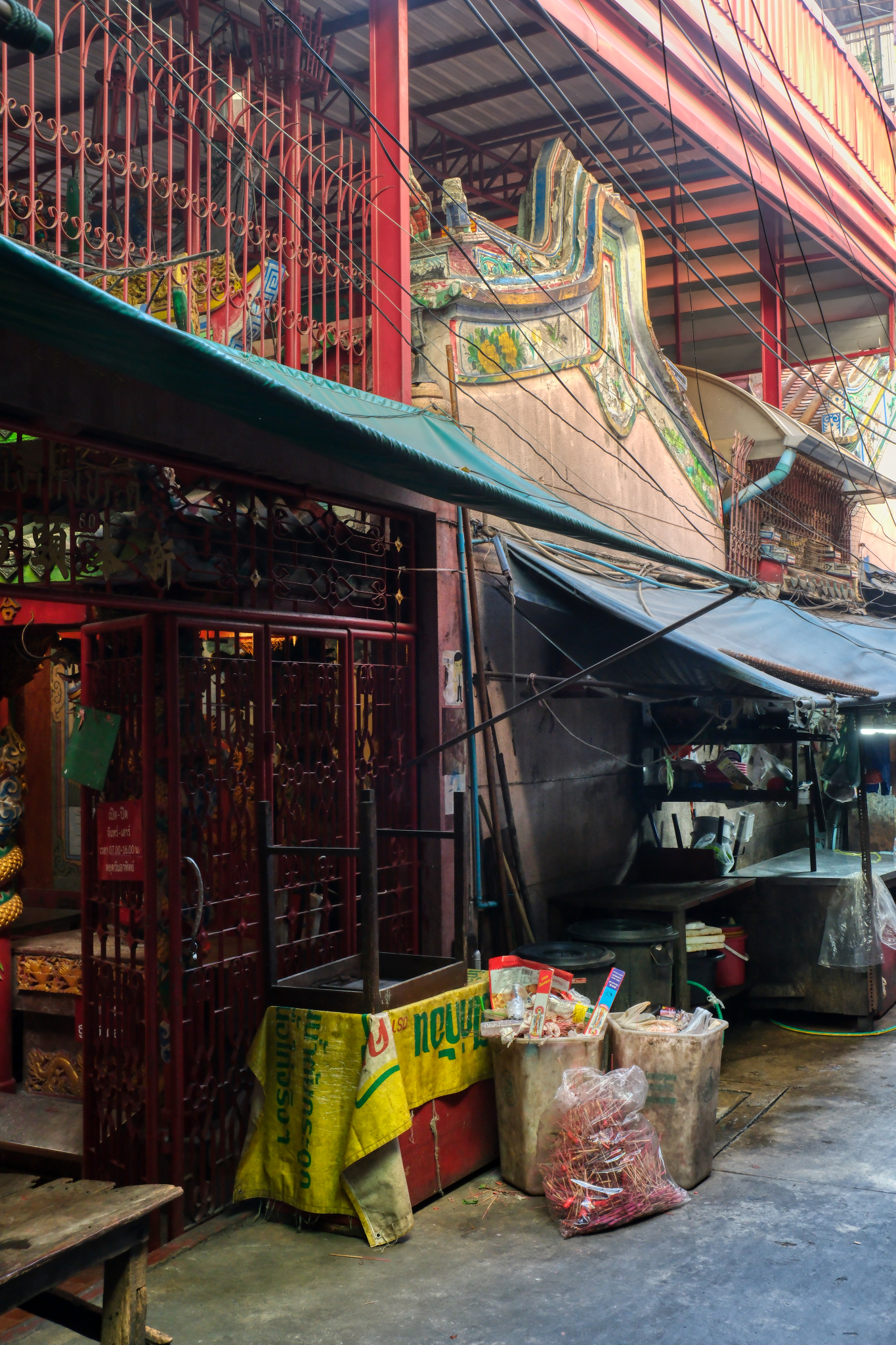 Spotted amid the complex patterns of the alley was some kind of temple . . . let's explore . . .
Spotted amid the complex patterns of the alley was some kind of temple . . . let's explore . . .
 Looking inside, we found this marvelous Chinese Buddhist Temple. Serendipity!
Looking inside, we found this marvelous Chinese Buddhist Temple. Serendipity!
 The temple inner altar was fantastically decorated.
The temple inner altar was fantastically decorated.
 The inner temple altar in all its phantasmagoria!
The inner temple altar in all its phantasmagoria!
 Incense pot . . .
Incense pot . . .
 The main altar displayed the pantheon of Chinese spiritual deities and revered monks behind glass.
The main altar displayed the pantheon of Chinese spiritual deities and revered monks behind glass.
 The opportunities for amazing photos were endless here . . . I took many more excellent photos in there than I have posted here . . . perhaps I need an entry just for this marvelous place.
The opportunities for amazing photos were endless here . . . I took many more excellent photos in there than I have posted here . . . perhaps I need an entry just for this marvelous place.
 These were very low light (and smoky) conditions for photography . . . such beauty everywhere!
These were very low light (and smoky) conditions for photography . . . such beauty everywhere!
 There were several small "side altars" around the inner chamber.
There were several small "side altars" around the inner chamber.
 We spent quite a abit of time inside the Chinese Temple . . . and could have spent a whole day documenting this old, photogenic, spiritual space . . . but we left for the alley again and onward to the New Year celebrations about to happen.
We spent quite a abit of time inside the Chinese Temple . . . and could have spent a whole day documenting this old, photogenic, spiritual space . . . but we left for the alley again and onward to the New Year celebrations about to happen.
 Back out in the small alley . . . it is fun to explore for images here.
Back out in the small alley . . . it is fun to explore for images here.
 Many visual wonders to see along the alley walls . . .
Many visual wonders to see along the alley walls . . .
 We popped out on the very crowded main street leading to the performance stage . . .
We popped out on the very crowded main street leading to the performance stage . . .
 Moments before the street was finally closed to auto traffic . . . and vendors and 'selfie' takers took over.
Moments before the street was finally closed to auto traffic . . . and vendors and 'selfie' takers took over.
 Four local ladies all dressed up for a night of celebration.
Four local ladies all dressed up for a night of celebration.
 Plenty of goodies to eat . . . healthy and otherwise!
Plenty of goodies to eat . . . healthy and otherwise!
 As evening approached the crowd migrated toward a "main stage" for the nighttime events.
As evening approached the crowd migrated toward a "main stage" for the nighttime events.
 It became almost impossible to get to the intersection where the stage was set . . . but we somehow pushed our way through.
It became almost impossible to get to the intersection where the stage was set . . . but we somehow pushed our way through.
 Revellers found time to pose with traditionally dressed street photo hawkers.
Revellers found time to pose with traditionally dressed street photo hawkers.
 We finally made it to an area behind the stage where the handlers of the dragon were waiting to do their dragon dance down the crowded avenue.
We finally made it to an area behind the stage where the handlers of the dragon were waiting to do their dragon dance down the crowded avenue.

The dragon head . . . staged and ready.
 We roamed the side streets looking for interesting images to capture with our cameras. We are never disappointed in Bangkok Chinatown for photogenic scenes.
We roamed the side streets looking for interesting images to capture with our cameras. We are never disappointed in Bangkok Chinatown for photogenic scenes.
 A beautiful Chinatown scene . . .
A beautiful Chinatown scene . . .
 These small side street restaurants would become full after the street celebrations later in the evening.
These small side street restaurants would become full after the street celebrations later in the evening.
 The crows were becoming a crush on the main avenue . . .
The crows were becoming a crush on the main avenue . . .
 The anticipation was just killing him!!!!
The anticipation was just killing him!!!!
---------------------------------------------------------------------------
Night Arrives!
 Night arrived at last . . . and we wriggled our way through this crowd to an area behind the stage where the performers were getting ready for the show.
Night arrived at last . . . and we wriggled our way through this crowd to an area behind the stage where the performers were getting ready for the show.
 Fantastic costumes everywhere back stage. . . .
Fantastic costumes everywhere back stage. . . .
 A photographer's dream!
A photographer's dream!
 A wonderful array of traditional costumes.
A wonderful array of traditional costumes.
 The backstage area almost warranted its own blog entry.
The backstage area almost warranted its own blog entry.
 New Years' revellers taking a load off their tired feet . . . and checking their phones for vital communication.
New Years' revellers taking a load off their tired feet . . . and checking their phones for vital communication.
 The backstage entrance light tunnel was popular.
The backstage entrance light tunnel was popular.
 There was no way to get close to the Dragon when it made its way out into the crowd . . . too many iPhone photographers!!!
There was no way to get close to the Dragon when it made its way out into the crowd . . . too many iPhone photographers!!!
 I did manage this shot of the departing Dragon by holding my camera over my head. Amazing.
I did manage this shot of the departing Dragon by holding my camera over my head. Amazing.
 After the dragon departed we decided it was time to beat the crowds back to the underground station, and headed out . . . but still with camera in hand for the fantastic night images.
After the dragon departed we decided it was time to beat the crowds back to the underground station, and headed out . . . but still with camera in hand for the fantastic night images.
 Yes, we "fought" our way back through this crowd . . . but people were good and generous with our passage.
Yes, we "fought" our way back through this crowd . . . but people were good and generous with our passage.
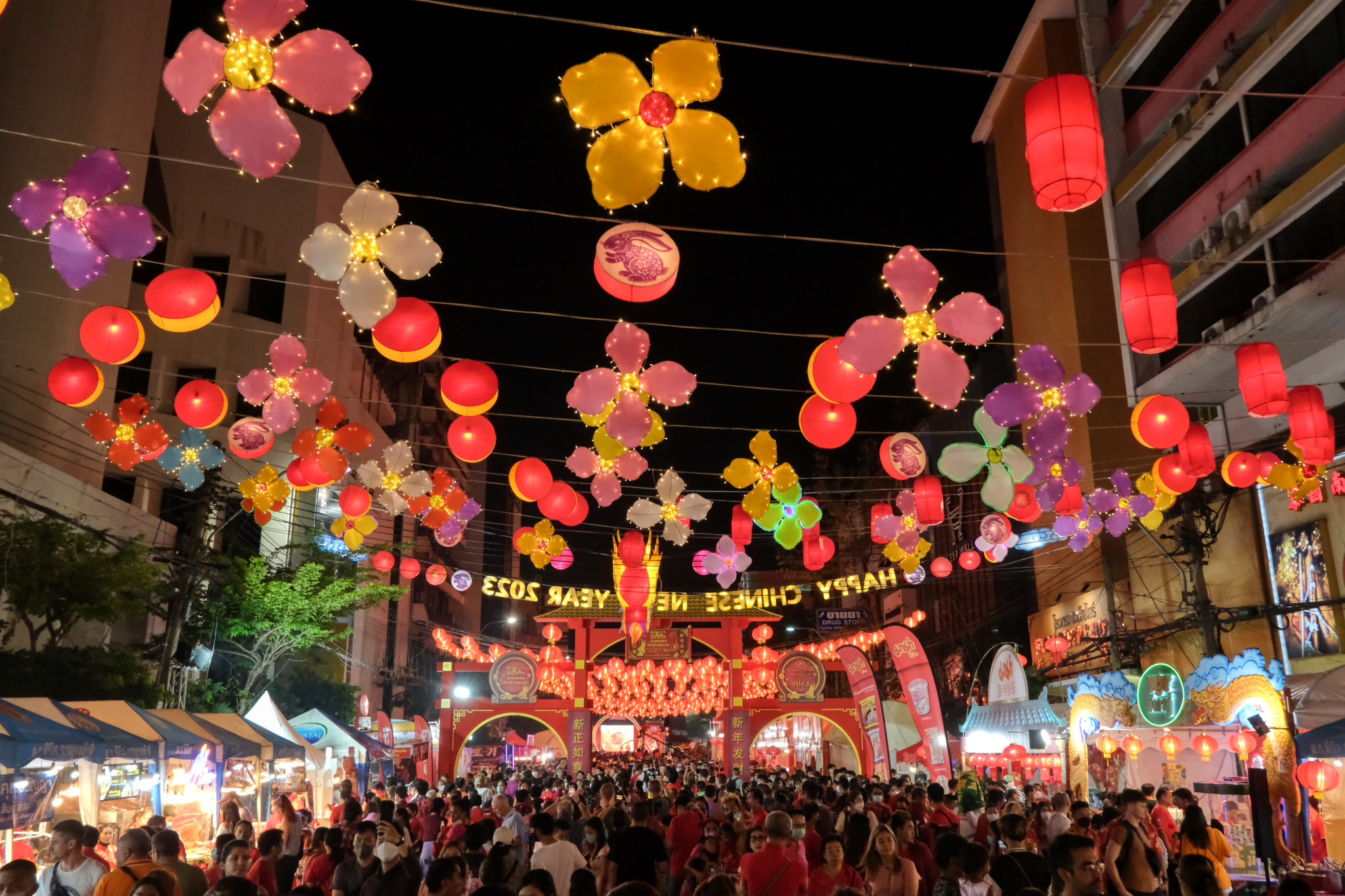 A beautiful array of lighting above . . .
A beautiful array of lighting above . . .
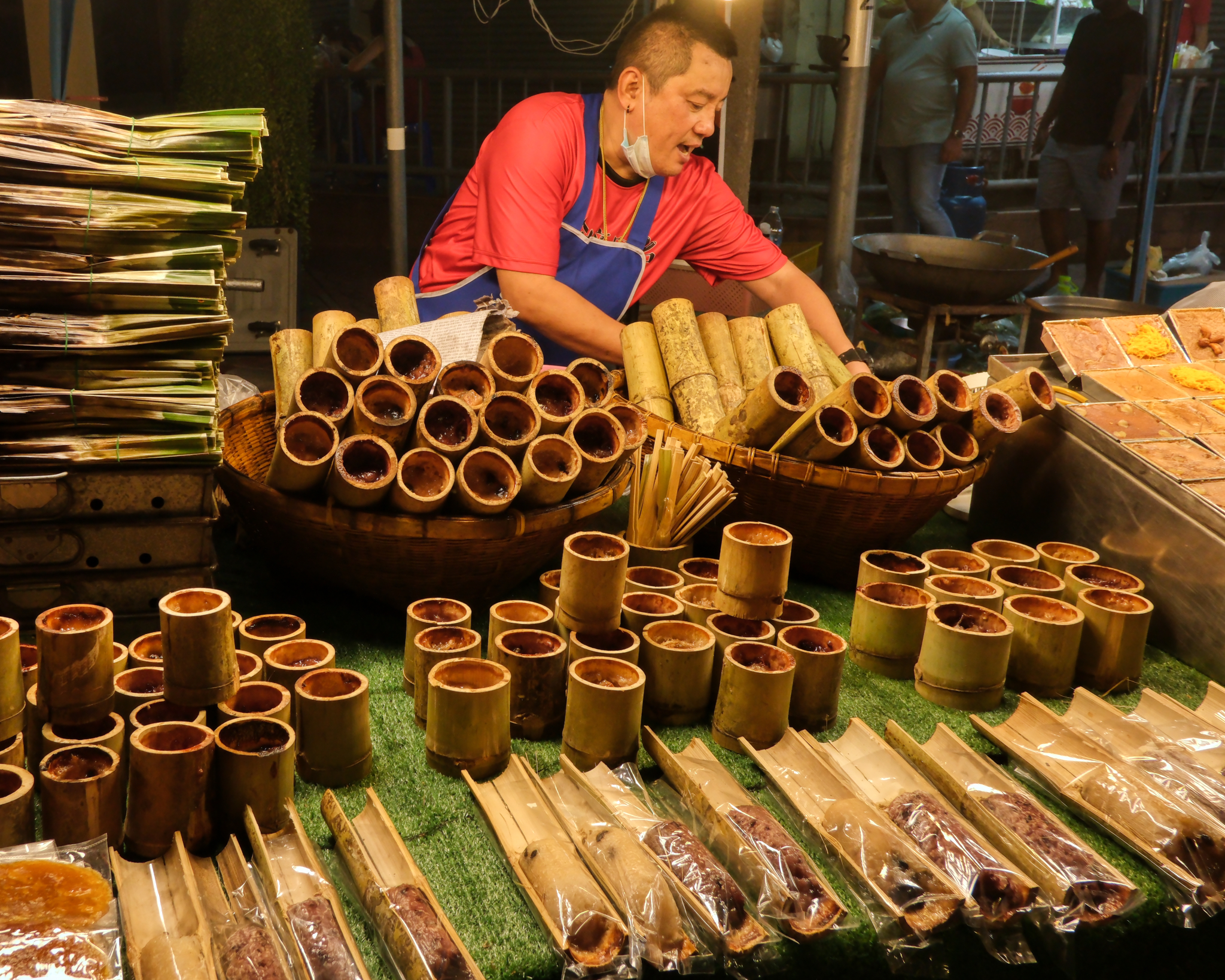 The street food vendors were doing a brisk business after dark. Here rice-cooked-in-bamboo . . . delicious!
The street food vendors were doing a brisk business after dark. Here rice-cooked-in-bamboo . . . delicious!
 People were out for a nice meal on the Chinatown streets tonight.
People were out for a nice meal on the Chinatown streets tonight.
 Long lines at this stall . . . it must have been good and tasty.
Long lines at this stall . . . it must have been good and tasty.
 Preparing Northern Thailand spicy sausage . . . yum-yum!
Preparing Northern Thailand spicy sausage . . . yum-yum!
 We left the crowded main celebration avenue and walked along a parallel street . . . there was no shortage of photographically interesting things along this route.
We left the crowded main celebration avenue and walked along a parallel street . . . there was no shortage of photographically interesting things along this route.
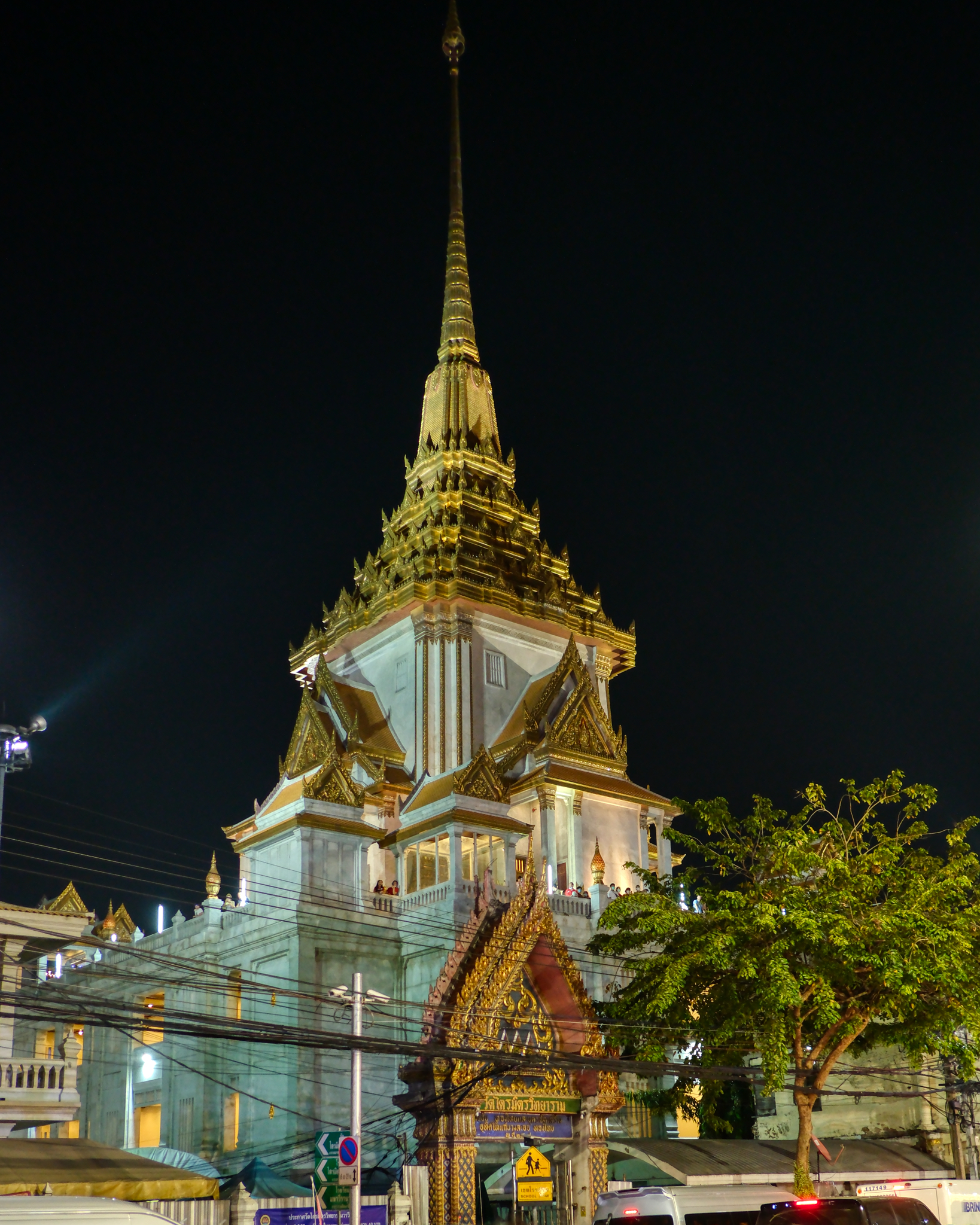 A Thai Buddhist temple (Wat) lit up.
A Thai Buddhist temple (Wat) lit up.
 "Why not keep the shop open a little later tonight . . . maybe make some extra sales, what with the big crowds and all."
"Why not keep the shop open a little later tonight . . . maybe make some extra sales, what with the big crowds and all."
 Why not set up a couple of card tables for those treasures you have for sale?
Why not set up a couple of card tables for those treasures you have for sale?
 A real jumble sale. This one was very sad to see . . . someone was very poor. I looked for the seller, but could find nobody. I left 100 baht (US$3.oo) on the table as a donation.
A real jumble sale. This one was very sad to see . . . someone was very poor. I looked for the seller, but could find nobody. I left 100 baht (US$3.oo) on the table as a donation.
 This night busker had it all . . . even his own light show!
This night busker had it all . . . even his own light show!
 This Buddhist votive statuary shopkeeper had a brilliant way of lureing customers into their shop . . . and it worked:
This Buddhist votive statuary shopkeeper had a brilliant way of lureing customers into their shop . . . and it worked:
 I bought the Ji Gong effigy (far right, top, third from right) for my collection.
I bought the Ji Gong effigy (far right, top, third from right) for my collection.
 At last, a shortcut back to the MRT underground station.
At last, a shortcut back to the MRT underground station.
 Then onto a crowded MRT underground train home. [This is the ONLY person on the train NOT wearing a mask . . . an American, of course!]
Then onto a crowded MRT underground train home. [This is the ONLY person on the train NOT wearing a mask . . . an American, of course!]
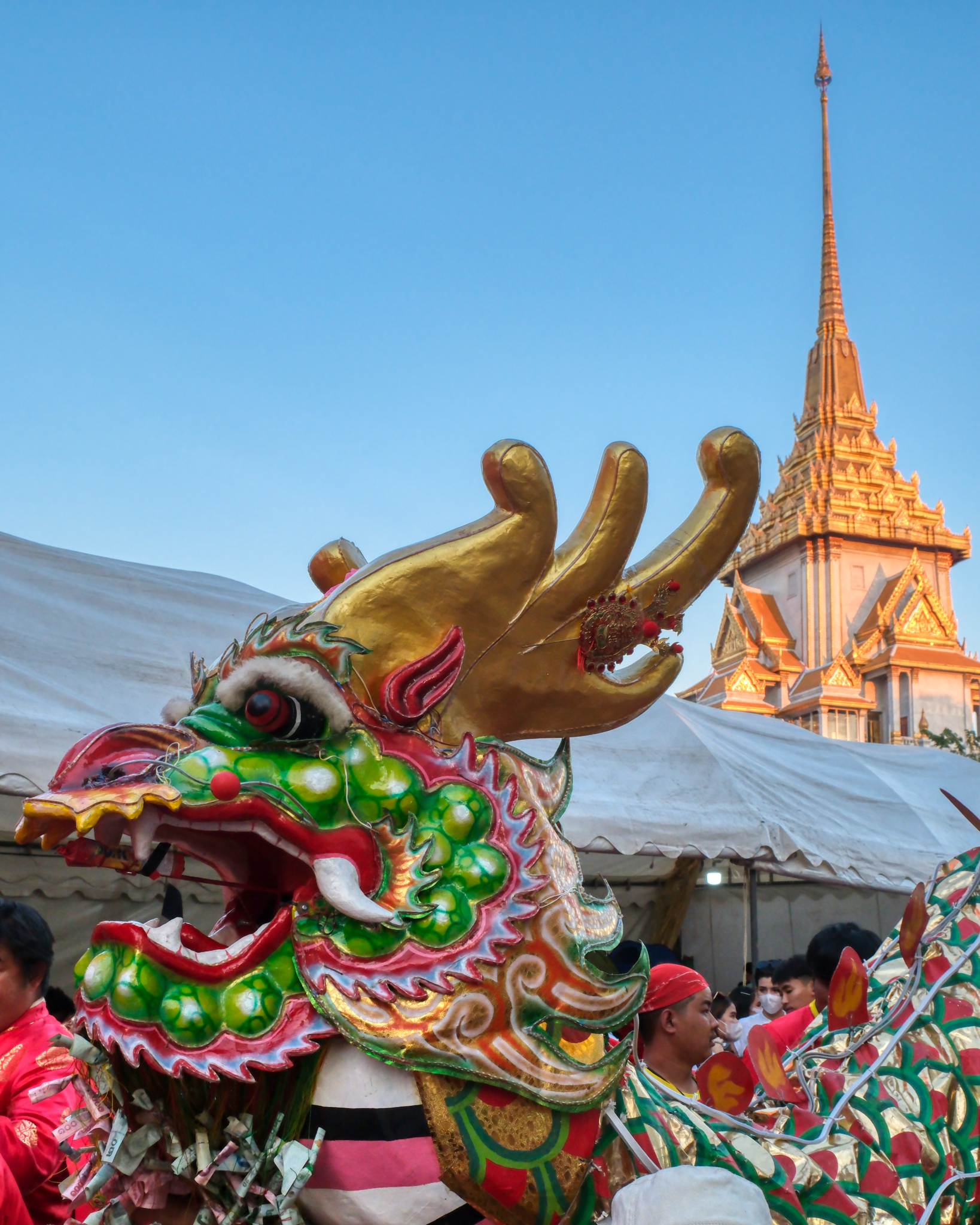 I have so many wonderful memories from that evening spent among the thousands celebrating Chinese New Year in Bangkok's Chinatown. It was a visual extravaganza . . . and a photographers dream!
I have so many wonderful memories from that evening spent among the thousands celebrating Chinese New Year in Bangkok's Chinatown. It was a visual extravaganza . . . and a photographers dream!

Loei, Chiang Khan, and the Mekong River
 Wednesday, October 26, 2022 at 12:57PM
Wednesday, October 26, 2022 at 12:57PM 
Back in December 2020, just as COVID 19 was bursting on the international scene and choking Thailand's tourist industry, the Thai government came up with a brilliant scheme to give vouchers to Thai residents for discounts at Thai resorts and restaurants in 'tourist areas' to spur more 'in country' tourism by Thais. It worked . . . we took a road trip north to Loei, Chiang Khan, and the Mekong River.
 Our route had us drive straight through to Loei from our home in a northern suburb of Bangkok.
Our route had us drive straight through to Loei from our home in a northern suburb of Bangkok.
 The majority of the drive north to Loei was on modern, divided expressway. However, as we neared Loei the road reverted to a 2-lane country road. We were lured into this strawberry stand with the promise of delicious fruit.
The majority of the drive north to Loei was on modern, divided expressway. However, as we neared Loei the road reverted to a 2-lane country road. We were lured into this strawberry stand with the promise of delicious fruit.
 They were growing their own strawberries here . . . but they were asking a very high price for them. We declined to purchase any strawberries here.
They were growing their own strawberries here . . . but they were asking a very high price for them. We declined to purchase any strawberries here.
________________________________
LOEI
 This is the old Loei I came to see . . .
This is the old Loei I came to see . . .
 Loei is a provincial market town in the north of Thailand. It is still "old Thailand" in Loei. I last visited here about 20 years ago . . . and yes, it has changed a great deal.
Loei is a provincial market town in the north of Thailand. It is still "old Thailand" in Loei. I last visited here about 20 years ago . . . and yes, it has changed a great deal.
 But there is still a lot of the old Thailand I know and love in Loei.
But there is still a lot of the old Thailand I know and love in Loei.
 The street food in Loei is excellent . . . and the people friendly.
The street food in Loei is excellent . . . and the people friendly.
 The old downtown of Loei still has locally-owned department stores and "supermarkets" like this one.
The old downtown of Loei still has locally-owned department stores and "supermarkets" like this one.
 A street corner in downtown Loei. I love snooping around in these old Thai market towns.
A street corner in downtown Loei. I love snooping around in these old Thai market towns.
 We stopped in this hole-in-the-wall restaurant for delicious noodle soup.
We stopped in this hole-in-the-wall restaurant for delicious noodle soup.
 A busy market town serving a large agricultural community.
A busy market town serving a large agricultural community.
 The things you see in Thailand! Yes, it was Christmas season even in Loei, Thailand. They celebrate everything here!
The things you see in Thailand! Yes, it was Christmas season even in Loei, Thailand. They celebrate everything here!
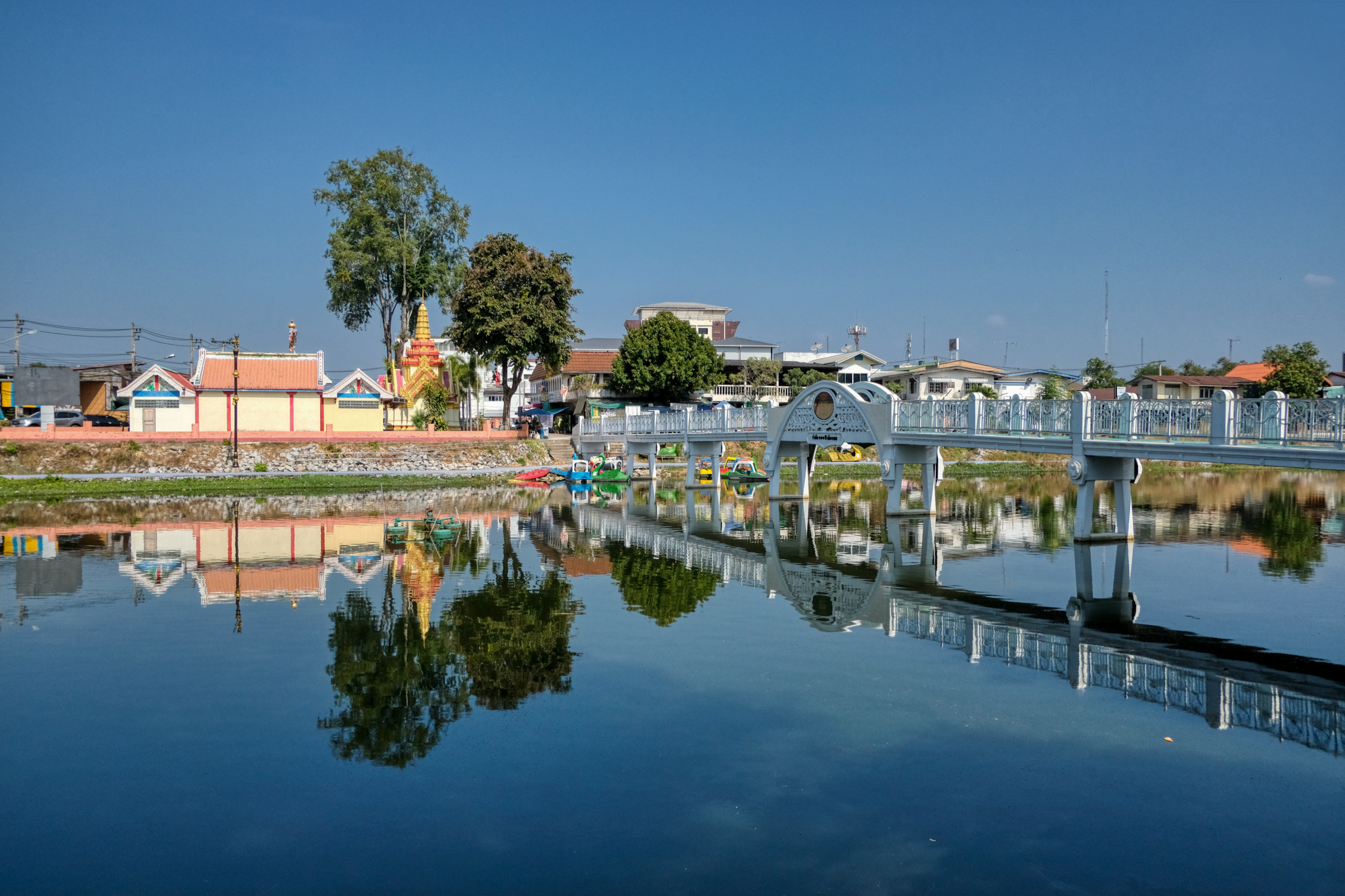 We walked through the downtown and found the banks of the Loei River. The bridge led to a beautiful city park.
We walked through the downtown and found the banks of the Loei River. The bridge led to a beautiful city park.
 There was fun to be had in Loei.
There was fun to be had in Loei.
 I sat across the street in a hipster coffee shop while my wife shopped in a fine traditional Thai textile shop across the street.
I sat across the street in a hipster coffee shop while my wife shopped in a fine traditional Thai textile shop across the street.
 Yes, the hipster cool coffee shop can be found throughout the entire planet . . . even in the remote old market town of Loei.
Yes, the hipster cool coffee shop can be found throughout the entire planet . . . even in the remote old market town of Loei.
 Always interesting old stuff to be found in old Thai village stores.
Always interesting old stuff to be found in old Thai village stores.
 Our very good, and very cheap Au Place Hotel in Loei.
Our very good, and very cheap Au Place Hotel in Loei.
 Just a half block away from the hotel on a rural street we found this stylish Vietnamese restaurant.
Just a half block away from the hotel on a rural street we found this stylish Vietnamese restaurant.
 We spent a couple nights in Loei and would venture out into the countryside in search of interesting things to see. We found this amazing Buddhist Temple (Wat).
We spent a couple nights in Loei and would venture out into the countryside in search of interesting things to see. We found this amazing Buddhist Temple (Wat).
 There were caves with Buddhas to explore at this wat.
There were caves with Buddhas to explore at this wat.
 There was this very beautiful marble temple on the wat grounds.
There was this very beautiful marble temple on the wat grounds.
 The marble temple was very interesting inside.
The marble temple was very interesting inside.
 Marvelous light and reflection inside the marble wat.
Marvelous light and reflection inside the marble wat.
 We found this marvelous restaurant for our dinner on the second night in Loei.
We found this marvelous restaurant for our dinner on the second night in Loei.
 The "elephant restaurant' interior dining area.
The "elephant restaurant' interior dining area.
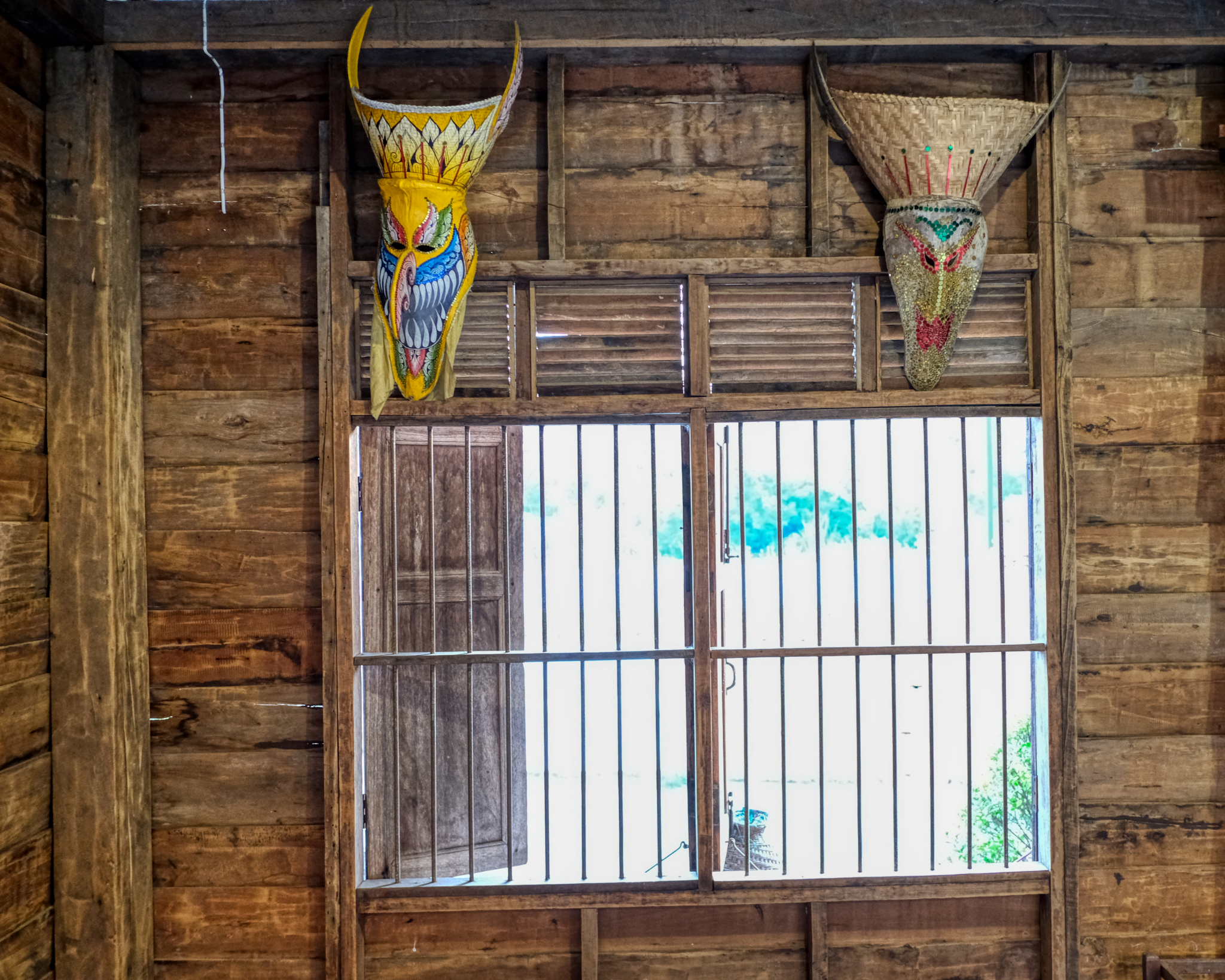 We had a fine meal in this old wooden room with traditional spirit masks hanging around.
We had a fine meal in this old wooden room with traditional spirit masks hanging around.
 Back at our hotel . . . they had the grounds lit up like a carnival!!!
Back at our hotel . . . they had the grounds lit up like a carnival!!!
 The next morning we said good-bye to Loei and hit the road for then short drive north to the town of Chiang Khan along the Mekong River.
The next morning we said good-bye to Loei and hit the road for then short drive north to the town of Chiang Khan along the Mekong River.
--------------------------------------------
CHIANG KHAN
 We stopped at a riverside resort as soon as we arrived at the river . . . and this was out first view of the mighty Mekong River.
We stopped at a riverside resort as soon as we arrived at the river . . . and this was out first view of the mighty Mekong River.
 We quickly found our charming old wooden guest house.
We quickly found our charming old wooden guest house.
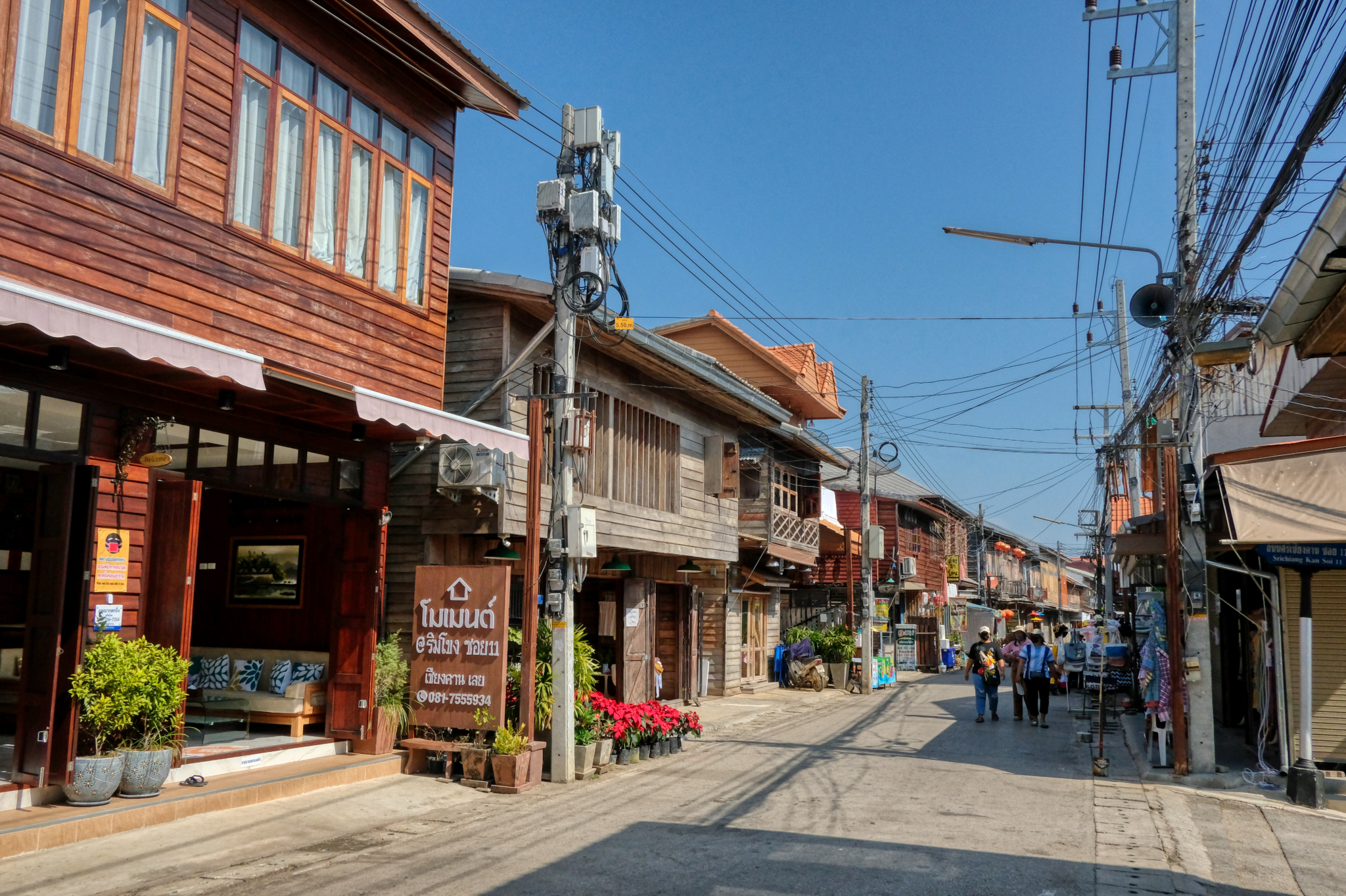 Our guest house was right on a kind of 'walking street' through the riverside village. The Mekong River is directly behind the row of houses and shops to the left.
Our guest house was right on a kind of 'walking street' through the riverside village. The Mekong River is directly behind the row of houses and shops to the left.
 Chiang Khan is a lovely and funky old Thai town with interesting shops and bike rentals.
Chiang Khan is a lovely and funky old Thai town with interesting shops and bike rentals.
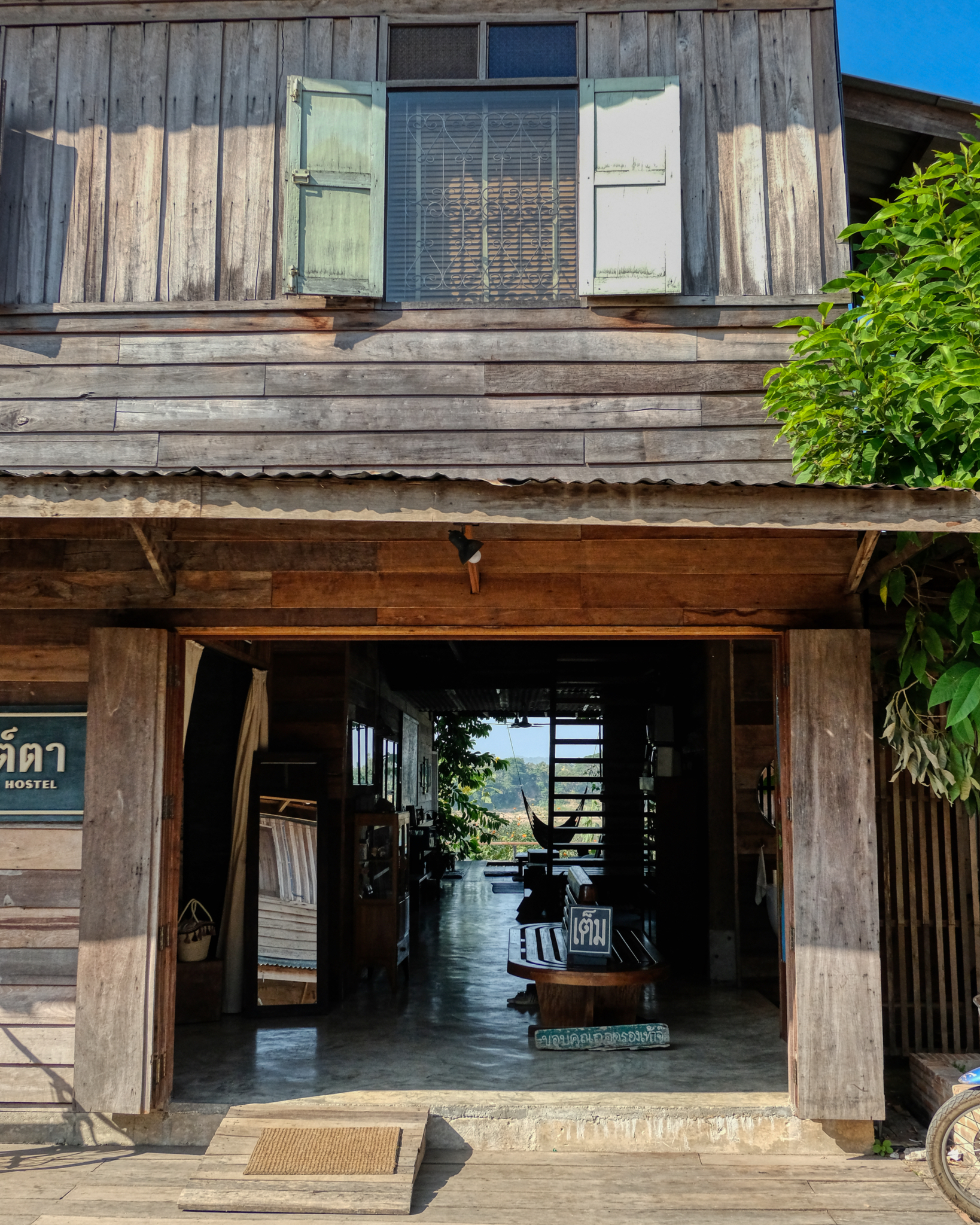 With both front and rear doors open, you can look right through this hostel to the river behind it.
With both front and rear doors open, you can look right through this hostel to the river behind it.
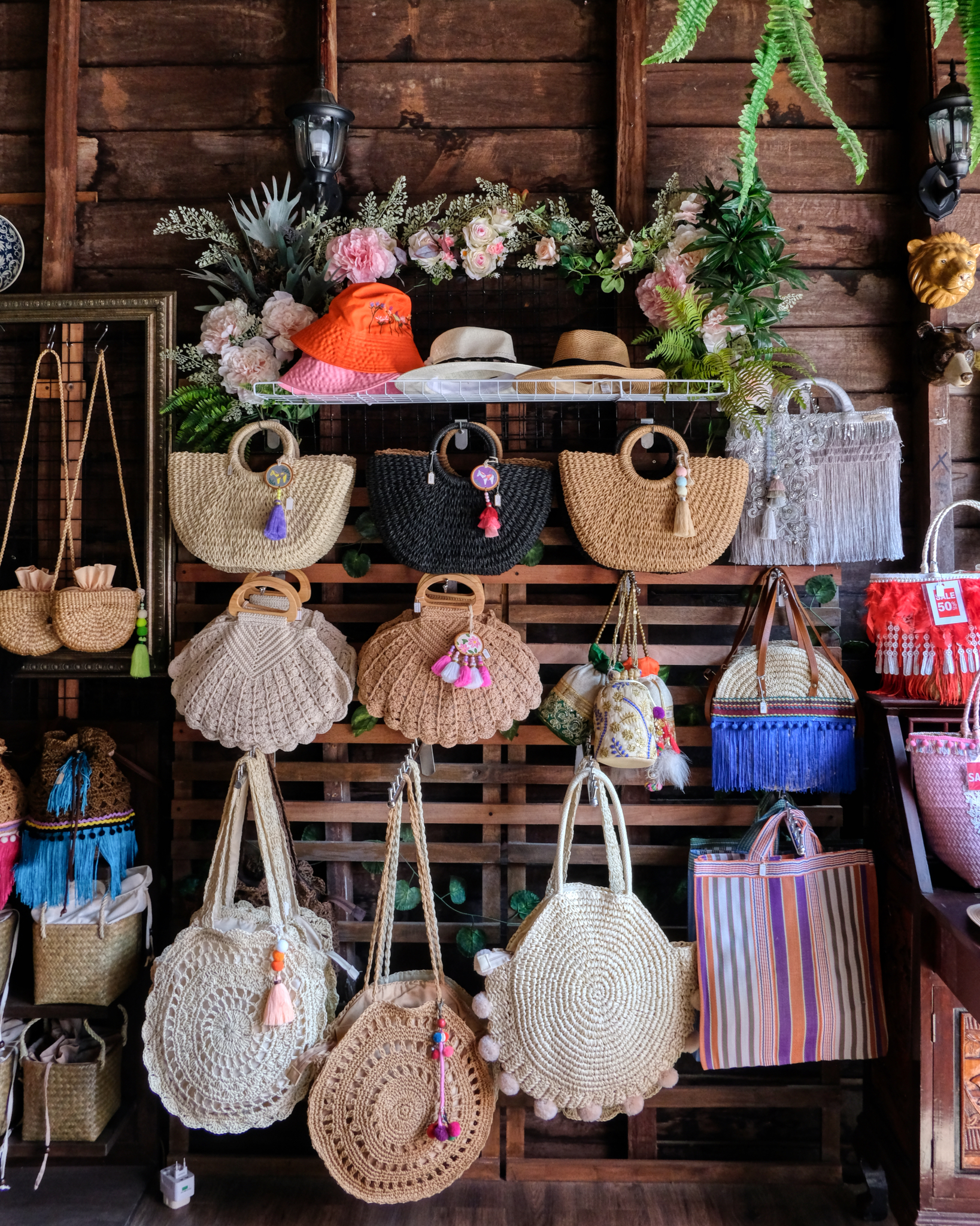 The many shops lining the walking street had ample supplies of local handicrafts to meet the tourist demand.
The many shops lining the walking street had ample supplies of local handicrafts to meet the tourist demand.
 A guest house with street side 'beer chairs' . . . perfect for people watching. I couldn't help but notice the Brew Dog Punk IPA bottle . . . from Aberdeen, Scotland, my former residence.
A guest house with street side 'beer chairs' . . . perfect for people watching. I couldn't help but notice the Brew Dog Punk IPA bottle . . . from Aberdeen, Scotland, my former residence.
 Such an interesting and photogenic little town.
Such an interesting and photogenic little town.
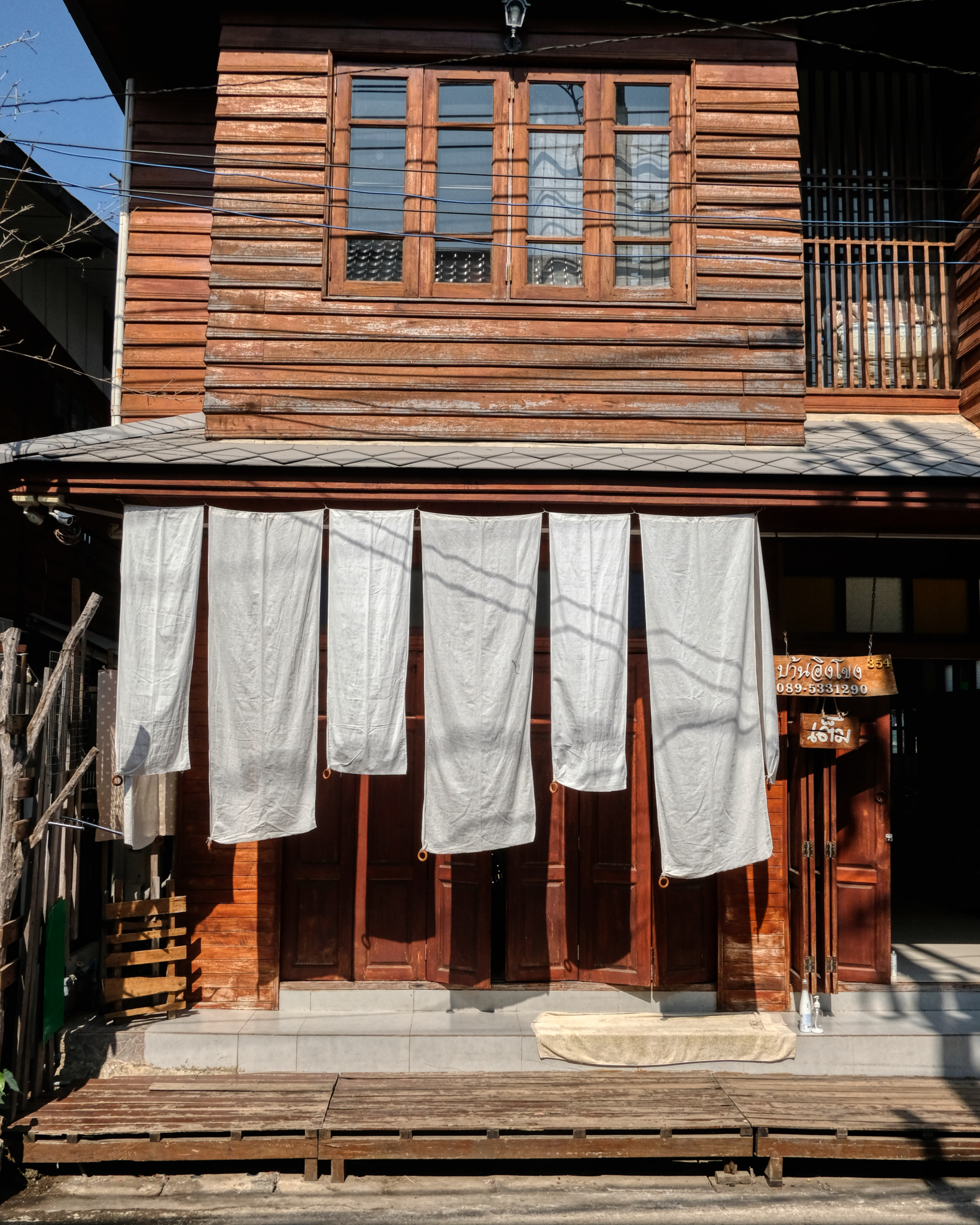 Some shops hung fabric against the harsh afternoon sun.
Some shops hung fabric against the harsh afternoon sun.
 Each shop-front seems to have its own personality, and the photographs are like portraits.
Each shop-front seems to have its own personality, and the photographs are like portraits.
 Beautiful local, high quality traditional textiles.
Beautiful local, high quality traditional textiles.
 There were also many shops selling the usual array of souvenir 'touristwear.'
There were also many shops selling the usual array of souvenir 'touristwear.'
 There is no shortage of restaurants and places to buy good, expensive coffee.
There is no shortage of restaurants and places to buy good, expensive coffee.
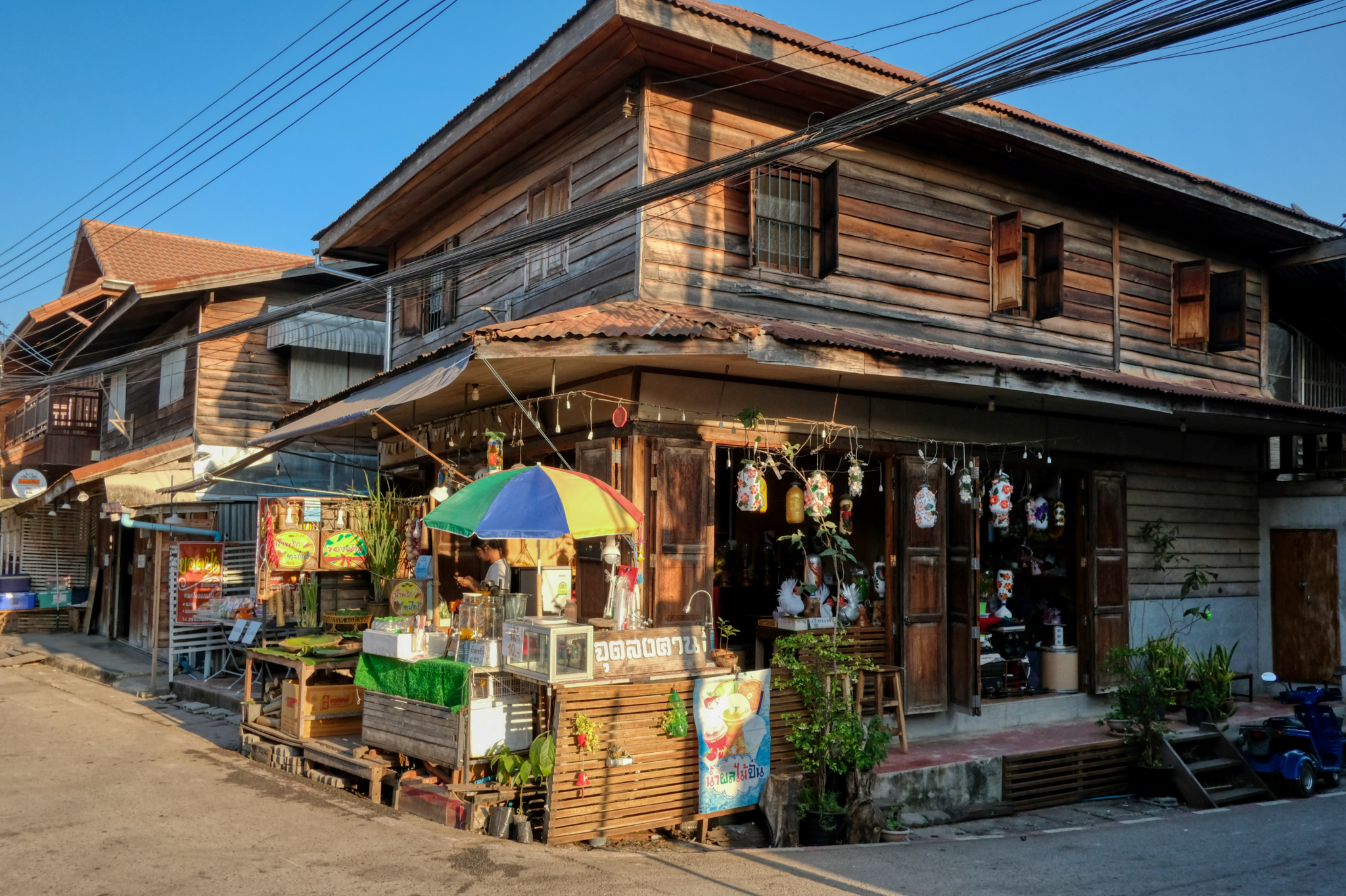 I love photographing these old wooden shops . . . anywhere in the world . . . but Chiang Khan had hundreds of them, and all with amazing shapes, features, colors, and textures.
I love photographing these old wooden shops . . . anywhere in the world . . . but Chiang Khan had hundreds of them, and all with amazing shapes, features, colors, and textures.
 A beautiful shop-front portrait. The harsh afternoon sunlight actually enhances this photo by accentuating the wood grain and colors.
A beautiful shop-front portrait. The harsh afternoon sunlight actually enhances this photo by accentuating the wood grain and colors.
 Another fabulous paneled storefront with Chinese lanterns. Lovely.
Another fabulous paneled storefront with Chinese lanterns. Lovely.
 Just so much to see, notice, and photograph in this sweet little riverside town.
Just so much to see, notice, and photograph in this sweet little riverside town.
 There was also some very nice chalk public art here and there.
There was also some very nice chalk public art here and there.
 Sweet chalk street art.
Sweet chalk street art.
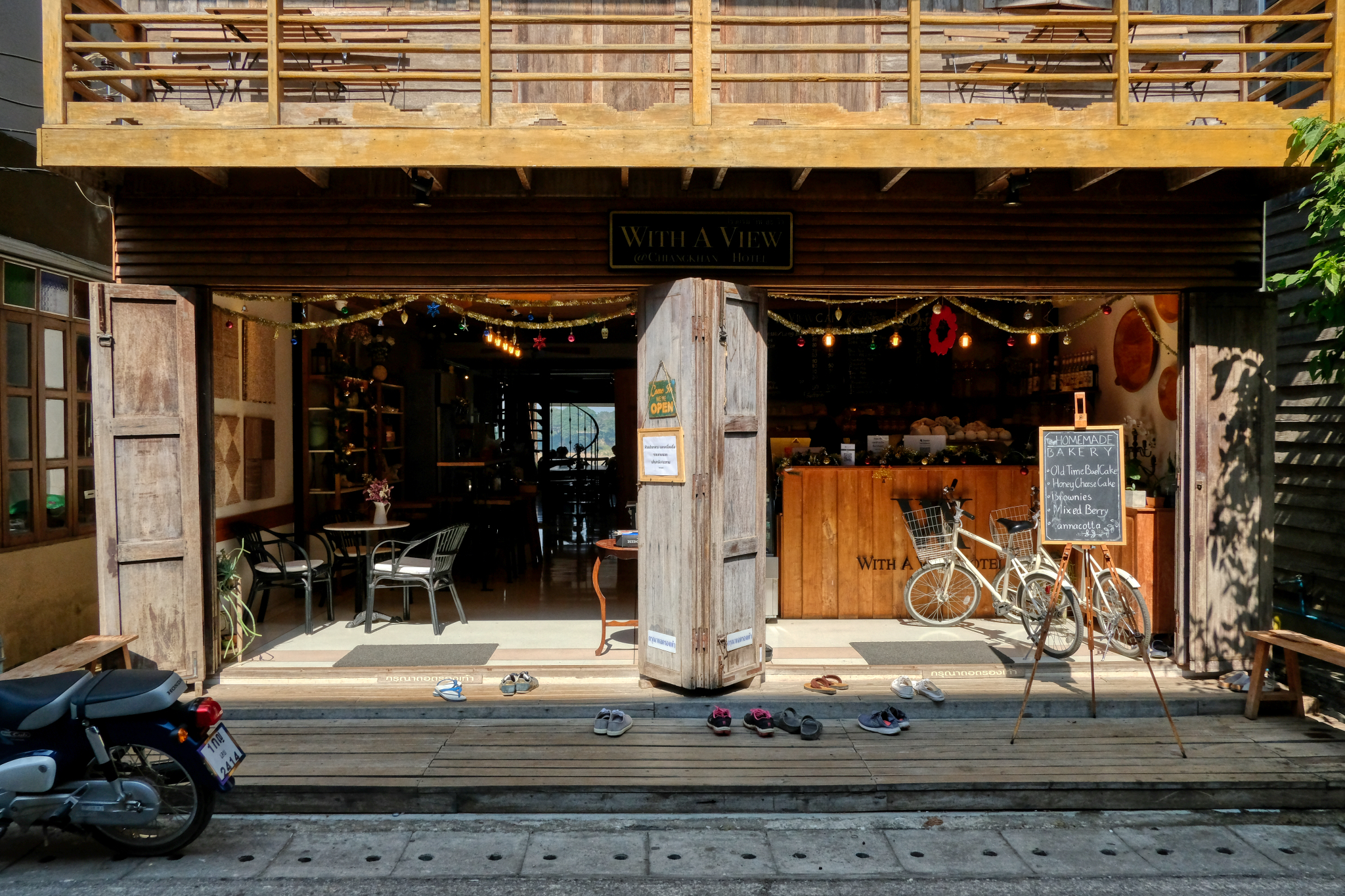 A very inviting bakery . . . delicious too!
A very inviting bakery . . . delicious too!
 Thai aesthetics are always fascinating and gorgeous. It's all in the details. Here, a detail of the interior of our guesthouse.
Thai aesthetics are always fascinating and gorgeous. It's all in the details. Here, a detail of the interior of our guesthouse.
 When walking around such these richly aesthetic places with a camera in hand, I am prone to take these kinds of "still life" photographs: pleasing arrangements of objects in fascinating light.
When walking around such these richly aesthetic places with a camera in hand, I am prone to take these kinds of "still life" photographs: pleasing arrangements of objects in fascinating light.
 Another "still life" of an old art gallery.
Another "still life" of an old art gallery.
 A very old wall revealing ancient building techniques.
A very old wall revealing ancient building techniques.
 Wooden wall with broom and ash tray.
Wooden wall with broom and ash tray.
 Chalk graffiti on old panel shop doors . . . there is a story here.
Chalk graffiti on old panel shop doors . . . there is a story here.
 Old panel shop doors reflected in a stainless steel table. Nice. These "still life" photo opportunities were endless in Chiang Khan.
Old panel shop doors reflected in a stainless steel table. Nice. These "still life" photo opportunities were endless in Chiang Khan.
 A very nice tuk-tuk, although I never saw anybody riding in one . . . everybody walked around the little town.
A very nice tuk-tuk, although I never saw anybody riding in one . . . everybody walked around the little town.
 We were getting tired and sore walking around the sweet town . . . deciding what to do next . . .
We were getting tired and sore walking around the sweet town . . . deciding what to do next . . .
 Massage! That's what's next!! The massage shop owner was very kind.
Massage! That's what's next!! The massage shop owner was very kind.
 a 2 1/2 hour Thai massage will cure whatever ails you, that's for sure! This street side massage room was so beautiful. Just breathtaking!
a 2 1/2 hour Thai massage will cure whatever ails you, that's for sure! This street side massage room was so beautiful. Just breathtaking!
 We spent part of our days walking along a path next to the Mekong River.
We spent part of our days walking along a path next to the Mekong River.
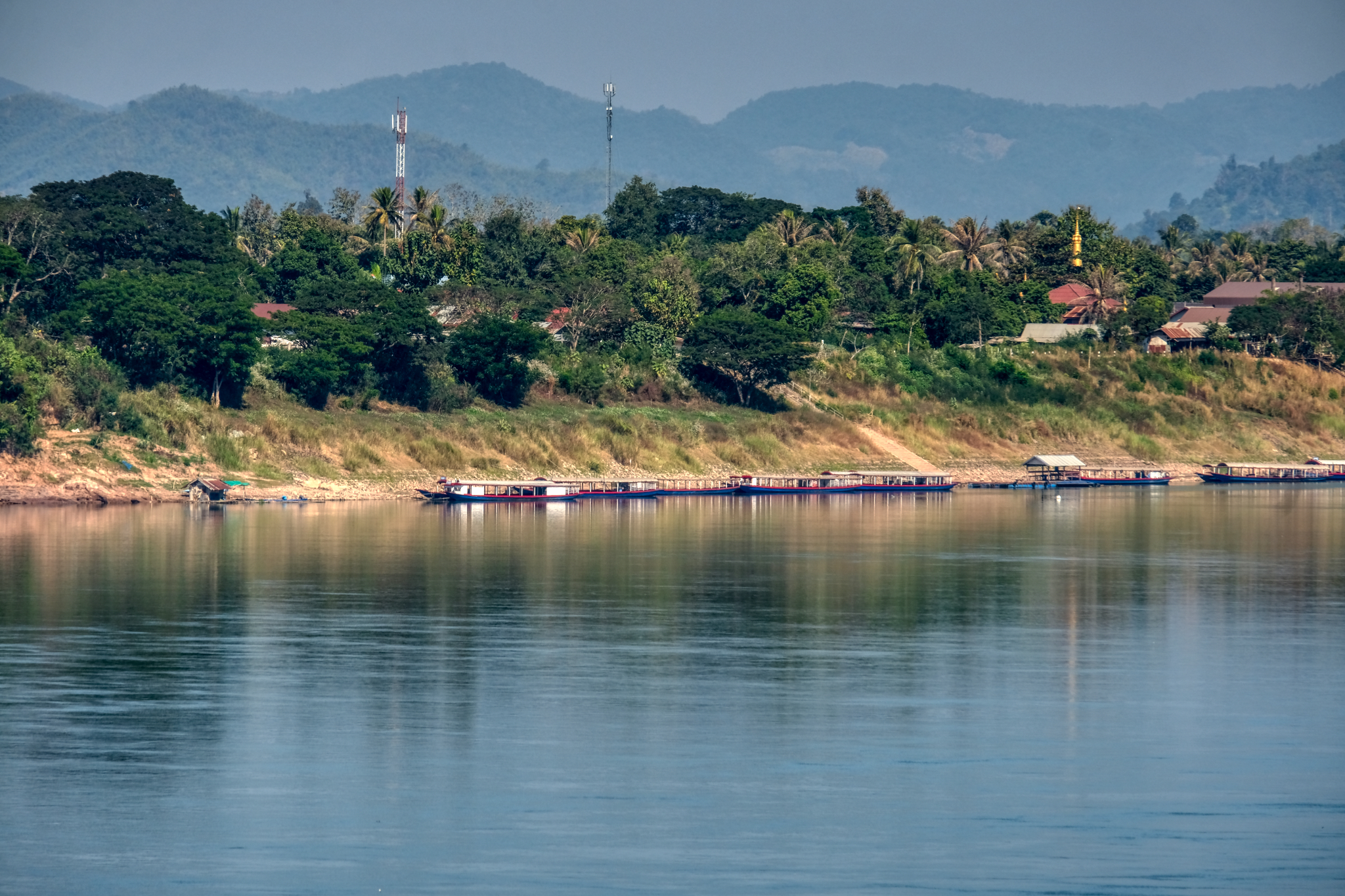 Looking across the Mekong toward the 'wild side' of Laos.
Looking across the Mekong toward the 'wild side' of Laos.
 Riverboat ferry both local people and tourists up and down the river.
Riverboat ferry both local people and tourists up and down the river.
 Mekong River boats at the ready.
Mekong River boats at the ready.
 A fisherman going home. Surprisingly, I did not see very many fishermen out on the river.
A fisherman going home. Surprisingly, I did not see very many fishermen out on the river.
 The fiew upriver toward the smoky Lao hills from Chiang Khan.
The fiew upriver toward the smoky Lao hills from Chiang Khan.
 When the sun set we headed to the night market street.
When the sun set we headed to the night market street.
CHIANG KHAN by NIGHT
 As the light faded, and the heat dissipated, it seemed that every Thai tourist in town left their guesthouse and headed to the main walking street.
As the light faded, and the heat dissipated, it seemed that every Thai tourist in town left their guesthouse and headed to the main walking street.
 The darker it got, the bigger the crowd under the colorful, and fading sky.
The darker it got, the bigger the crowd under the colorful, and fading sky.
 At last the sun had fully set.
At last the sun had fully set.
 Many of the shops, restaurants, and bars that were closed in the afternoon opened for the throngs that came out at night. This craft beer joint was a welcome stop for me.
Many of the shops, restaurants, and bars that were closed in the afternoon opened for the throngs that came out at night. This craft beer joint was a welcome stop for me.
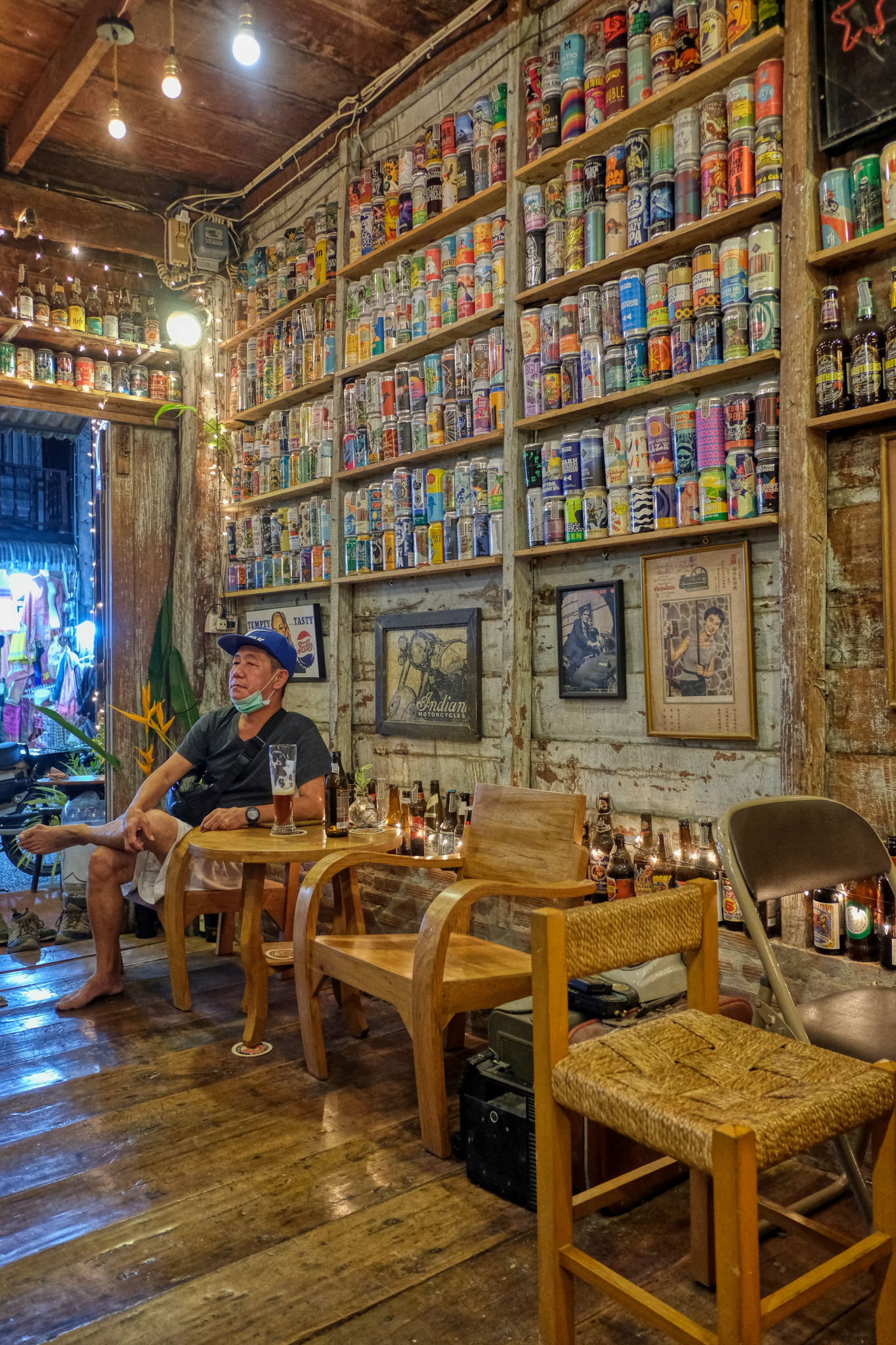 The interior of the craft beer hall.
The interior of the craft beer hall.
 The Thai hippies who ran the craft beer hall had a fantastic collection of beers and ales to choose from.
The Thai hippies who ran the craft beer hall had a fantastic collection of beers and ales to choose from.
 The town became even more photogenic at night. BBQ beef street hawkers.
The town became even more photogenic at night. BBQ beef street hawkers.
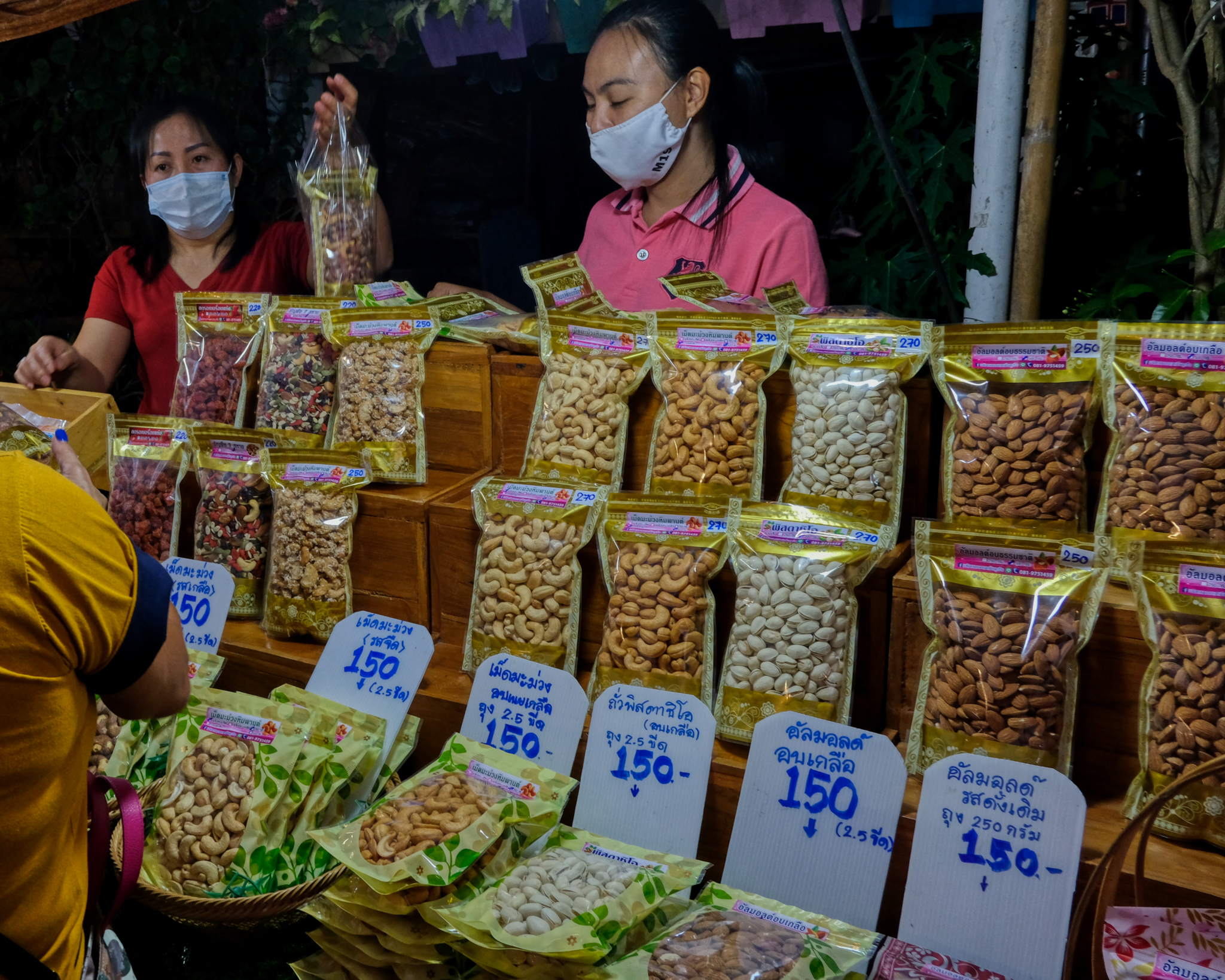 The many stalls set up along the night street became a 'night market' - a favorite of Thai people and visitors to Thailand. There was a wide variety of things for sale. Nuts! I love nuts!
The many stalls set up along the night street became a 'night market' - a favorite of Thai people and visitors to Thailand. There was a wide variety of things for sale. Nuts! I love nuts!
 All the night market visitors brought their appetites . . . and were rewarded with a wide variety of delicious Thai specialties to eat.
All the night market visitors brought their appetites . . . and were rewarded with a wide variety of delicious Thai specialties to eat.
 Street performers in their traditional 'hill tribe' costumes entertained the gathered crowds.
Street performers in their traditional 'hill tribe' costumes entertained the gathered crowds.
 My favorite street performer was this young busker playing electrified traditional old Thai music in a homemade outfit. Cool.
My favorite street performer was this young busker playing electrified traditional old Thai music in a homemade outfit. Cool.
 We enjoyed out nights walking along the Chiang Khan night market street.
We enjoyed out nights walking along the Chiang Khan night market street.
 After two nights in Chiang Khan we woke up early and said good-bye to the river and headed south.
After two nights in Chiang Khan we woke up early and said good-bye to the river and headed south.
Khon Kaen
 We were about 30 minutes out of Chiang Khan and decided to take a different route home to Bangkok. Neither of us had ever been to Khon Kaen . . . so why not?
We were about 30 minutes out of Chiang Khan and decided to take a different route home to Bangkok. Neither of us had ever been to Khon Kaen . . . so why not?
 We didn't do too much sightseeing . . . just drove around town . . . found a great restaurant on Google . . . and found this magnificent wat to go in . . .
We didn't do too much sightseeing . . . just drove around town . . . found a great restaurant on Google . . . and found this magnificent wat to go in . . .
 We were very glad we went inside.
We were very glad we went inside.
 There are many different altars in the large inner space . . . each with a group of people paying respects.
There are many different altars in the large inner space . . . each with a group of people paying respects.
 Very special light falling on the various Buddha images.
Very special light falling on the various Buddha images.
 Pots for making donations and making wishes.
Pots for making donations and making wishes.
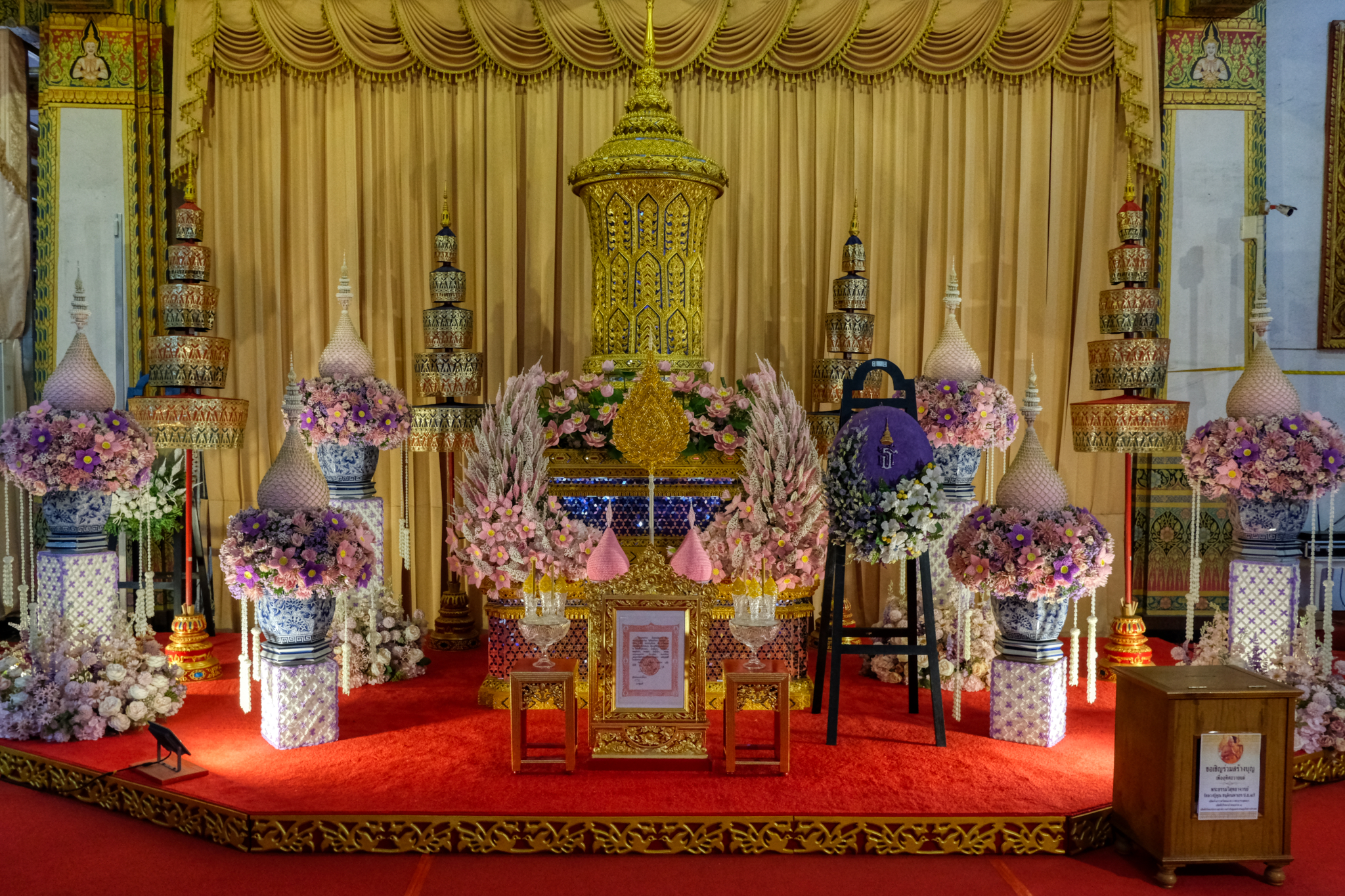 Such a pretty flower memorial altar.
Such a pretty flower memorial altar.
 This hyper-realistic wax monk was too realistic . . . and creepy.
This hyper-realistic wax monk was too realistic . . . and creepy.
 We paid our respects here and then chatted with a monk before leaving. We knew we haddn't spent enough time in Khon Kaen and vowed to return.
We paid our respects here and then chatted with a monk before leaving. We knew we haddn't spent enough time in Khon Kaen and vowed to return.
We left the next morning for a 7 hour drive home.
It had been a wonderful vacation in the middle of the COVID Pandemic!
USA Road Trip: Bull Bend Campground - Deschutes National Forest, Oregon
 Thursday, June 23, 2022 at 12:38PM
Thursday, June 23, 2022 at 12:38PM  At the start of a long road trip to the Grand Canyon, Zion and Bryce National Parks, my wonderful wife and I stopped off for a two days of camping along the Deschutes River on the eastern slopes of the Cascade Mountains of Central Oregon. Bull Bend Campground was lovely!
At the start of a long road trip to the Grand Canyon, Zion and Bryce National Parks, my wonderful wife and I stopped off for a two days of camping along the Deschutes River on the eastern slopes of the Cascade Mountains of Central Oregon. Bull Bend Campground was lovely!
 A 3 1/2 hour drive from our starting point in Keizer, Oregon to the Bull Bend Campground through the beautiful Santiam Pass . . .
A 3 1/2 hour drive from our starting point in Keizer, Oregon to the Bull Bend Campground through the beautiful Santiam Pass . . .
 There was a somewhat bumpy and dusty 2-3 mile drive off the paved road through the dry Ponderosa Pine forest to get to Bull Bend Campground.
There was a somewhat bumpy and dusty 2-3 mile drive off the paved road through the dry Ponderosa Pine forest to get to Bull Bend Campground.
 The campground was very nice with all the sites actually on the river. We found a nice one and went about setting up camp.
The campground was very nice with all the sites actually on the river. We found a nice one and went about setting up camp.
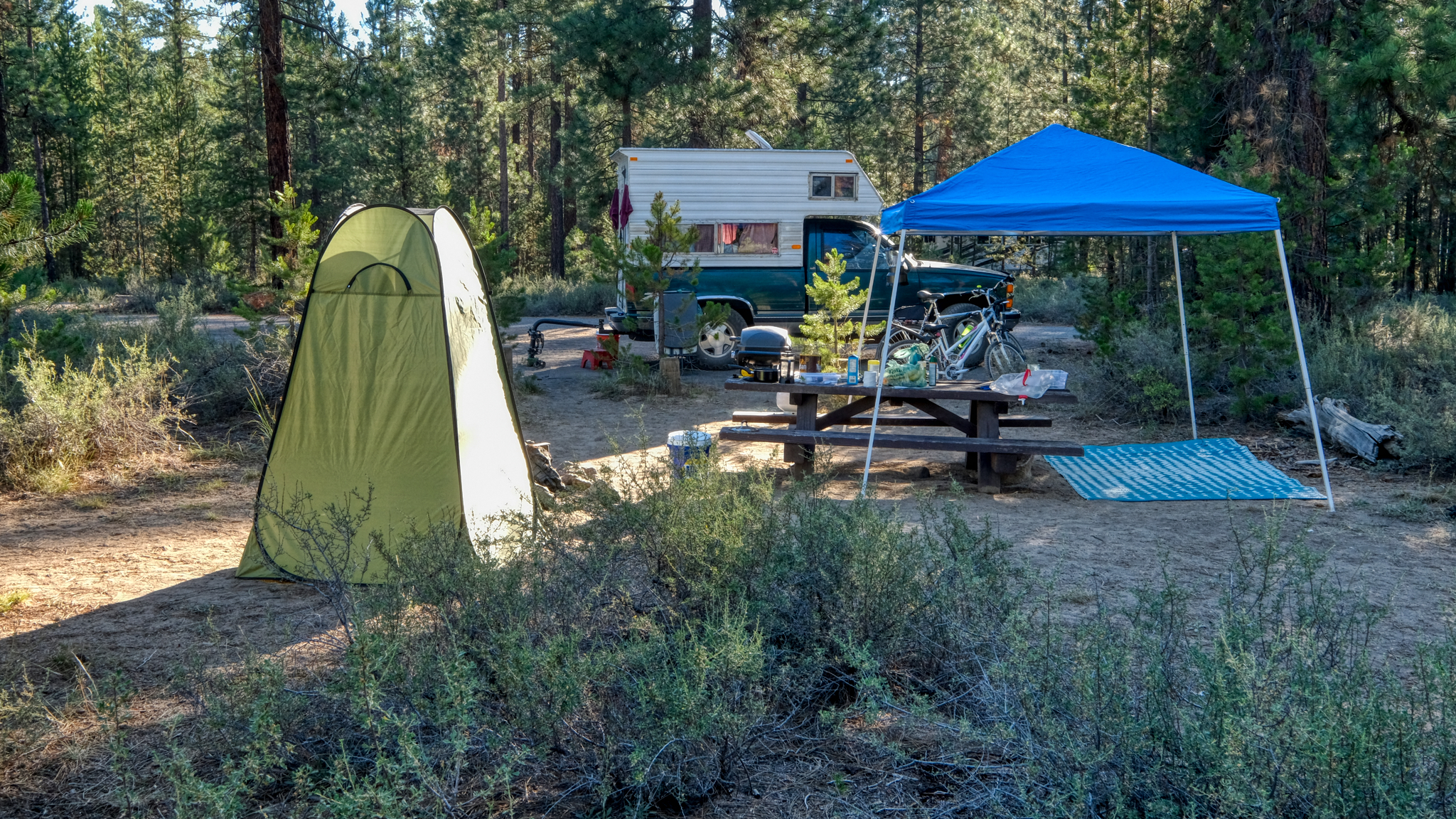 With our camp set up (complete with our "shower/toilet" tent), we took of for a quick look around.
With our camp set up (complete with our "shower/toilet" tent), we took of for a quick look around.
 We were situated in a beautiful forest on a perfect, clear 80f day.
We were situated in a beautiful forest on a perfect, clear 80f day.
 30 feet from our campsite we had the Deschutes River. Spectacular!
30 feet from our campsite we had the Deschutes River. Spectacular!
 There is a big 300 degree bend in the river which almost creates an island, where the campground is situated.
There is a big 300 degree bend in the river which almost creates an island, where the campground is situated.
 Incredible nature!
Incredible nature!
 I immediately went back to our camp site and grabbed my camping chair and took it down to the river banks. This is where I wanted to sit and enjoy life.
I immediately went back to our camp site and grabbed my camping chair and took it down to the river banks. This is where I wanted to sit and enjoy life.
 The view from my camp chair. Heaven.
The view from my camp chair. Heaven.
 Looking to my left from my camping chair the river bends out and around in a big arch which surrounds the campground.
Looking to my left from my camping chair the river bends out and around in a big arch which surrounds the campground.
 I took my bike out for a spin around the campground . . .
I took my bike out for a spin around the campground . . .
 Then I rode the road out of the campground . . . for some different views of the river.
Then I rode the road out of the campground . . . for some different views of the river.
 The Dechutes River floods at various times of the year eroding the banks. These sawed-off root snags can be found along the banks.
The Dechutes River floods at various times of the year eroding the banks. These sawed-off root snags can be found along the banks.
 The forest floor is a complex and beautiful environment . . .
The forest floor is a complex and beautiful environment . . .
 Various tree falls from fires and thinning.
Various tree falls from fires and thinning.
 On the next morning my wife and I took a walk out into the forest on a random trail leading away from the river.
On the next morning my wife and I took a walk out into the forest on a random trail leading away from the river.
 There was plenty of evidence that there had been a big burn in the not-too-distant past. Of course, these Ponderosa pines depend on fire to help their seeds propagate.
There was plenty of evidence that there had been a big burn in the not-too-distant past. Of course, these Ponderosa pines depend on fire to help their seeds propagate.
 Such an inviting forest trail . . . on such a gorgeous day!
Such an inviting forest trail . . . on such a gorgeous day!
 Our trail "away from the river" eventually lead us back to another bend in the meandering Dechutes River.
Our trail "away from the river" eventually lead us back to another bend in the meandering Dechutes River.
 I am not sure if I will ever get back to this wonderful place, but I will always remember these fantastic trees.
I am not sure if I will ever get back to this wonderful place, but I will always remember these fantastic trees.
 An absolutely gorgeous place to camp for a couple of days . . .
An absolutely gorgeous place to camp for a couple of days . . .
USA Road Trip: Black Rock Desert Camping - Nevada
 Saturday, April 9, 2022 at 5:31PM
Saturday, April 9, 2022 at 5:31PM  My big USA road trip took me on the small roads from Oregon south across the Nevada border and into the town of Winnemucca, where I washed clothes, showered, and cleaned out my camper at an RV park next to a casino.
My big USA road trip took me on the small roads from Oregon south across the Nevada border and into the town of Winnemucca, where I washed clothes, showered, and cleaned out my camper at an RV park next to a casino.
 Heading out on gravel and sand Nevada Highway 49 out of Winnemucca across dried lake beds and desolate desert landscapes. My kind of place.
Heading out on gravel and sand Nevada Highway 49 out of Winnemucca across dried lake beds and desolate desert landscapes. My kind of place.
 Ready for anything that comes my way in my brother's trusty 4X4 Chevy camper (now sold).
Ready for anything that comes my way in my brother's trusty 4X4 Chevy camper (now sold).
 Nevada Highway 49 swerves across several alkaloid flats on the way out to the Black Rock Desert.
Nevada Highway 49 swerves across several alkaloid flats on the way out to the Black Rock Desert.
 Wild country . . . with wild horses still running free.
Wild country . . . with wild horses still running free.
 The Allied Nevada Hycroft Gold Mine is along Nevada Highway 49 . . . a very large mining operation.
The Allied Nevada Hycroft Gold Mine is along Nevada Highway 49 . . . a very large mining operation.
 The gold mine moved a lot of dirt around . . . they stripped the face off of quite a few hills to be able to see the color of the rock and sand beneath. Huge scars.
The gold mine moved a lot of dirt around . . . they stripped the face off of quite a few hills to be able to see the color of the rock and sand beneath. Huge scars.
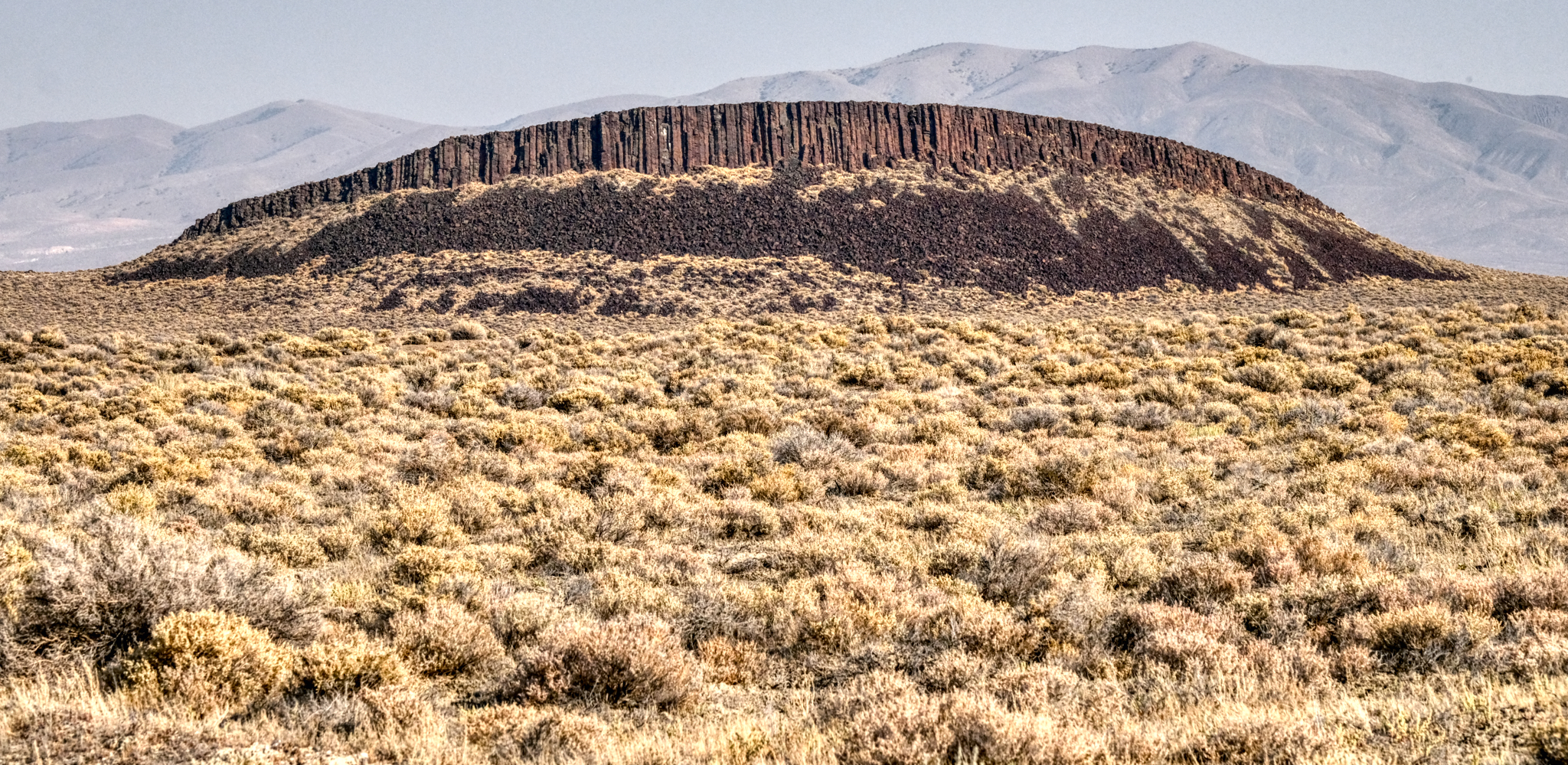 Highway 49 passes through some truly amazing desert. This volcanic spine was marvelous . . .
Highway 49 passes through some truly amazing desert. This volcanic spine was marvelous . . .
 Here and there along the road were rock outcroppings in fantastic shapes. Unfortunately, the sky was still full of smoke from the many wildfires out West that summer . . . making photography very difficult.
Here and there along the road were rock outcroppings in fantastic shapes. Unfortunately, the sky was still full of smoke from the many wildfires out West that summer . . . making photography very difficult.
 The desert.
The desert.
 Driving on these sand and gravel desert roads means you are always on the lookout for bumps and ditches . . . and occasionally scanning the horizon for something interesting . . . like an abandoned homestead. I spotted this one off in the distance and drove out to in on a two track trail. I always respect "Private Property" and "Keep Out" signs . . . but this place had no such signage. I went in.
Driving on these sand and gravel desert roads means you are always on the lookout for bumps and ditches . . . and occasionally scanning the horizon for something interesting . . . like an abandoned homestead. I spotted this one off in the distance and drove out to in on a two track trail. I always respect "Private Property" and "Keep Out" signs . . . but this place had no such signage. I went in.
 What was life like living out in this remote place?
What was life like living out in this remote place?
 These old abandoned desert homesteads offer great photo opportunities.
These old abandoned desert homesteads offer great photo opportunities.
 They used some very large wooden beams to construct these buildings. Looks like something salvaged out of old mines.
They used some very large wooden beams to construct these buildings. Looks like something salvaged out of old mines.
 The textures! WOW! One of my favorite photographic subjects: weathered wood.
The textures! WOW! One of my favorite photographic subjects: weathered wood.
 I spent quite a long time exploring this visually interesting place.
I spent quite a long time exploring this visually interesting place.
 Stunning arrangements everywhere . . . just waiting for printing and framing.
Stunning arrangements everywhere . . . just waiting for printing and framing.
 I guess they decided NOT to bring the good chair along with them when they left.
I guess they decided NOT to bring the good chair along with them when they left.
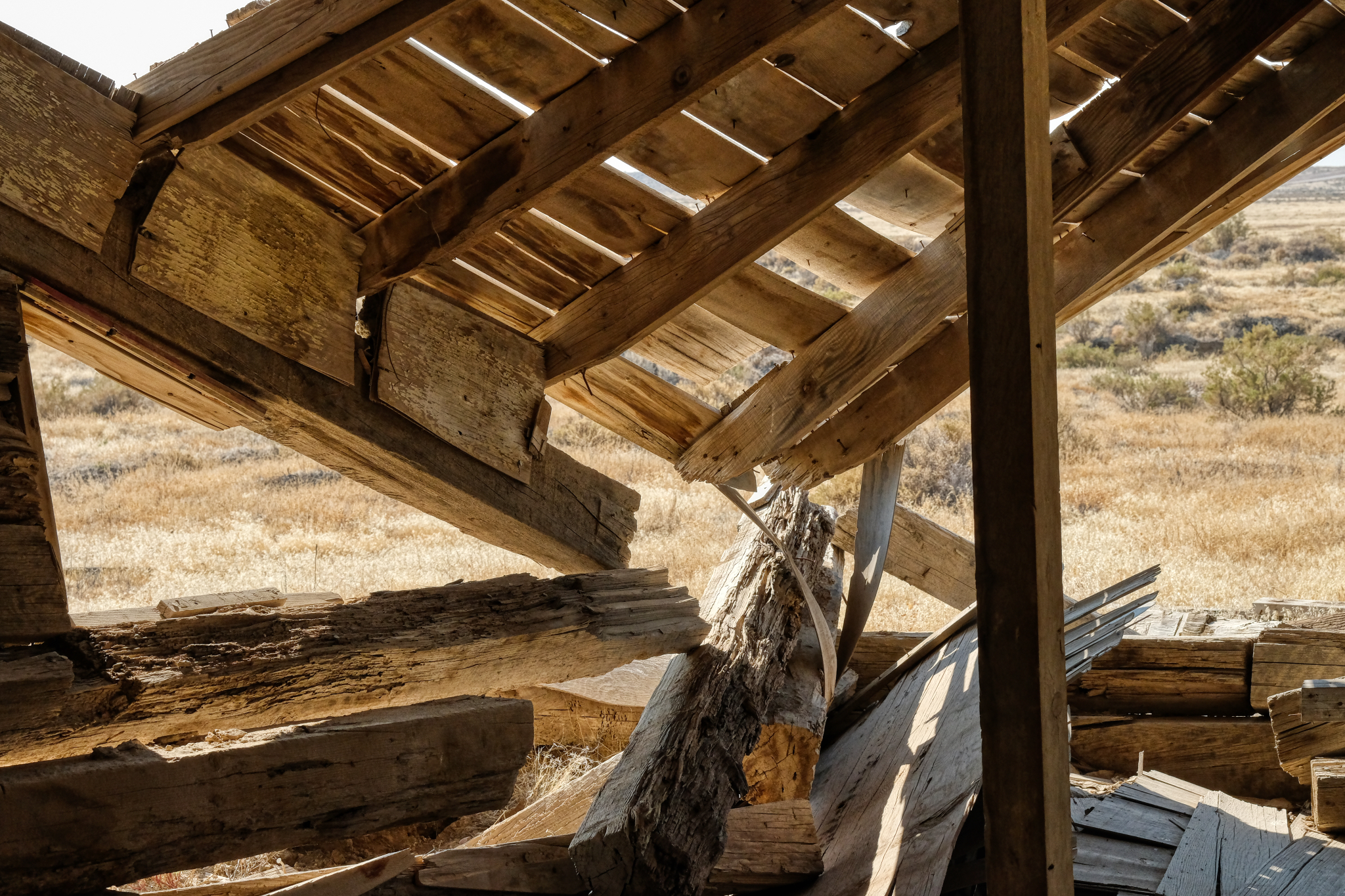 Lovely light, shadow, and shape.
Lovely light, shadow, and shape.
 There were several houses on this site. I imagined that there must have been a place name . . . a "town" name at one time, but I could find no mention of this site on any online maps I could find.
There were several houses on this site. I imagined that there must have been a place name . . . a "town" name at one time, but I could find no mention of this site on any online maps I could find.
 This house was larger than the rest of the cabins. There was a mine opening on the hill above.
This house was larger than the rest of the cabins. There was a mine opening on the hill above.
 A piece of rusting mining machinery. I do not know what this could have been used for . . . sorting and separating something, I suppose.
A piece of rusting mining machinery. I do not know what this could have been used for . . . sorting and separating something, I suppose.
 The 'Big House' . . . looks like it had fibreboard and tarpaper covering at one time.
The 'Big House' . . . looks like it had fibreboard and tarpaper covering at one time.
 I poked my nose into the Big House . . . .
I poked my nose into the Big House . . . .
 . . . and the view from the inside of the 'main house'. It was a mess . . . perhaps whoever had lived here left in a hurry . . . .
. . . and the view from the inside of the 'main house'. It was a mess . . . perhaps whoever had lived here left in a hurry . . . .
 I walked down the hill to another abandoned old wood cabin.
I walked down the hill to another abandoned old wood cabin.
 Another house made of these very large wooden timber beams.
Another house made of these very large wooden timber beams.
 Fantastic old, dry timbers . . . the textures and patterns!
Fantastic old, dry timbers . . . the textures and patterns!
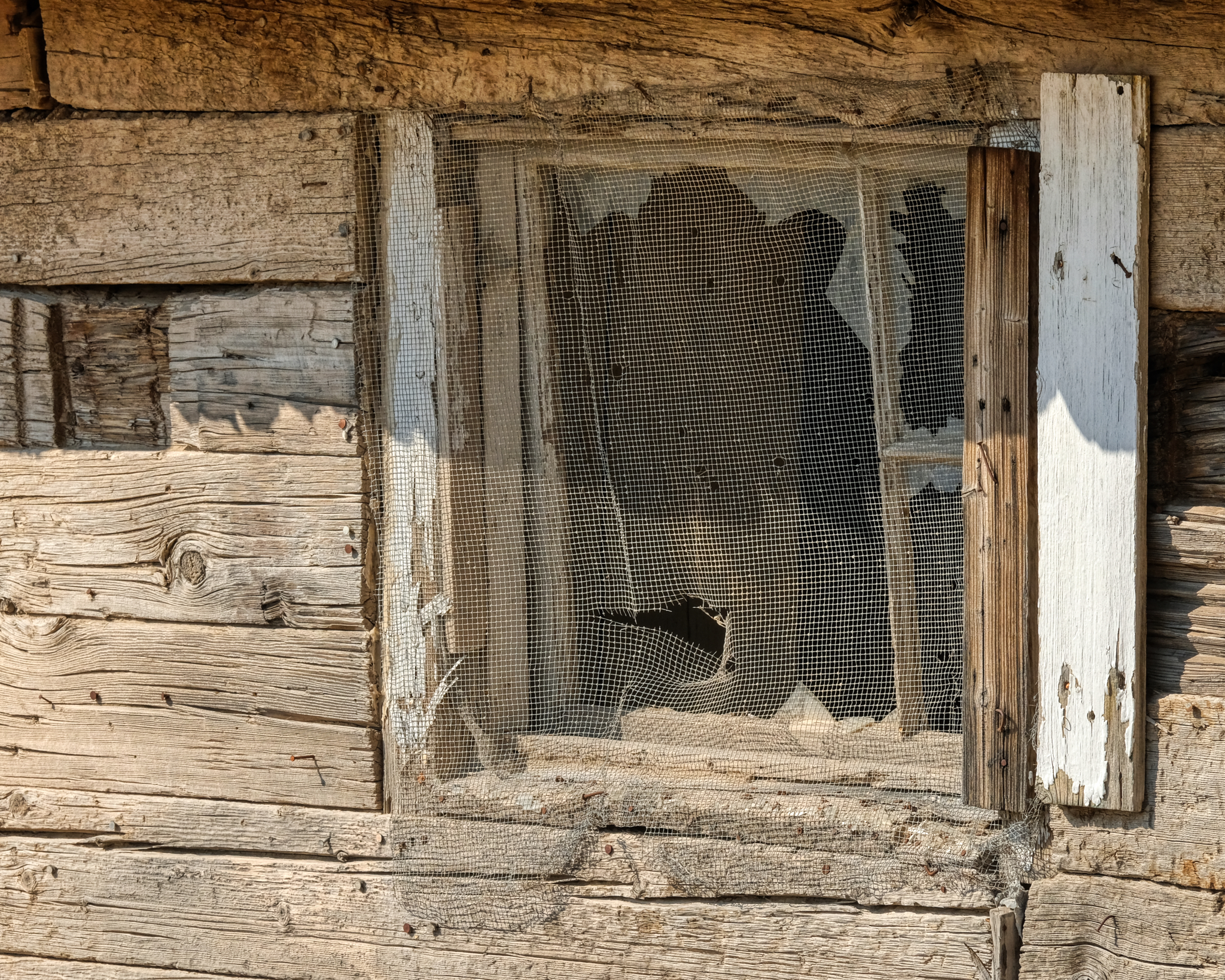 A picture tells a story . . .
A picture tells a story . . .
 I had apparently stumbled upon the site of the National Sweatshirt Testing Facility (NSTF).
I had apparently stumbled upon the site of the National Sweatshirt Testing Facility (NSTF).
 A perfect 'screen saver' photo . . .
A perfect 'screen saver' photo . . .
 All I could think was that the flying insects around here must have been pretty big.
All I could think was that the flying insects around here must have been pretty big.
 Yet another abandoned miners house from a bygone era . . . not all that long ago . . . .
Yet another abandoned miners house from a bygone era . . . not all that long ago . . . .
 It was early September when I was in northwest Nevada . . . and there is always some fauna that thrives at every time of the year on the desert.
It was early September when I was in northwest Nevada . . . and there is always some fauna that thrives at every time of the year on the desert.
 The desert floor around the old mining community was littered with this white quartz . . . I wonder what they were mining for here? I left the abandoned miner houses and drove back out on Highway 49 . . . to look for a place to set up camp.
The desert floor around the old mining community was littered with this white quartz . . . I wonder what they were mining for here? I left the abandoned miner houses and drove back out on Highway 49 . . . to look for a place to set up camp.
 This is what I was looking for: a track that led up and away from the road and into the wild desert. I drove about a mile up this track before I decided that this isn't what I wanted . . . and I do not know why. But I was tempted.
This is what I was looking for: a track that led up and away from the road and into the wild desert. I drove about a mile up this track before I decided that this isn't what I wanted . . . and I do not know why. But I was tempted.
 The view to my left as I drove toward the Black Rock Desert was always a sharp escarpment, with ever-changing geology and brush covering.
The view to my left as I drove toward the Black Rock Desert was always a sharp escarpment, with ever-changing geology and brush covering.
 I stopped here in wonderment! There seemed to be giant petroglyphs on this volcanic hillside. What language was this? Of course, I knew it was just bald spots on an old lava flow . . .
I stopped here in wonderment! There seemed to be giant petroglyphs on this volcanic hillside. What language was this? Of course, I knew it was just bald spots on an old lava flow . . .
 Such an amazing desert mountain landscape . . . but look closely . . .
Such an amazing desert mountain landscape . . . but look closely . . .
 . . . but look closer . . . and you see the remnants of an old mine entrance way up on the mountainside. Astounding!
. . . but look closer . . . and you see the remnants of an old mine entrance way up on the mountainside. Astounding!
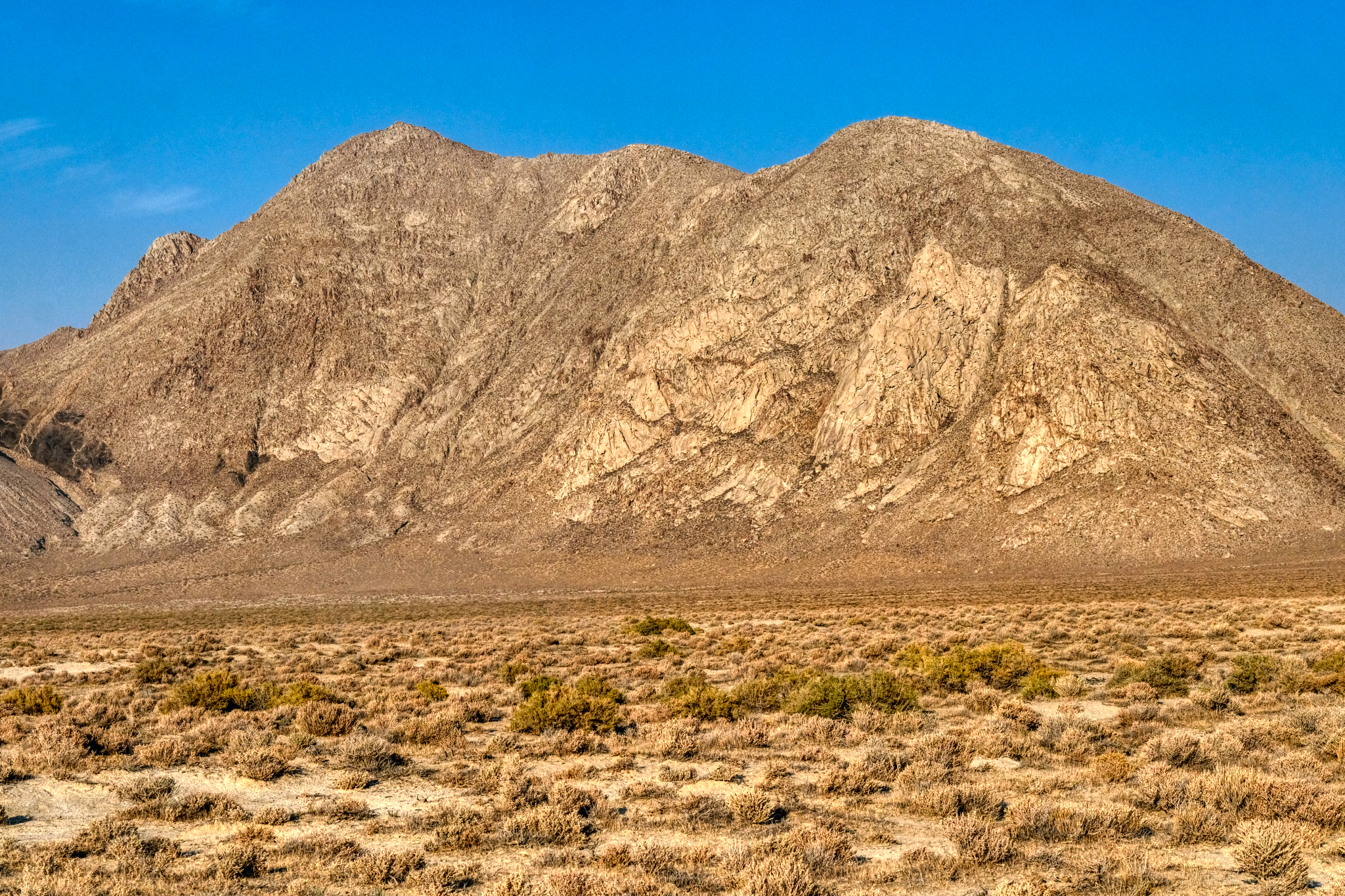 I drove for an hour alongside this rocky ridge . . . always scanning for something interesting . . .
I drove for an hour alongside this rocky ridge . . . always scanning for something interesting . . .
 I stopped and contemplated climbing up to this "dry waterfall ' . . . but it was much further away and much taller than I thought.
I stopped and contemplated climbing up to this "dry waterfall ' . . . but it was much further away and much taller than I thought.
 The shadows were getting longer and I felt the need to find my camping spot . . .
The shadows were getting longer and I felt the need to find my camping spot . . .
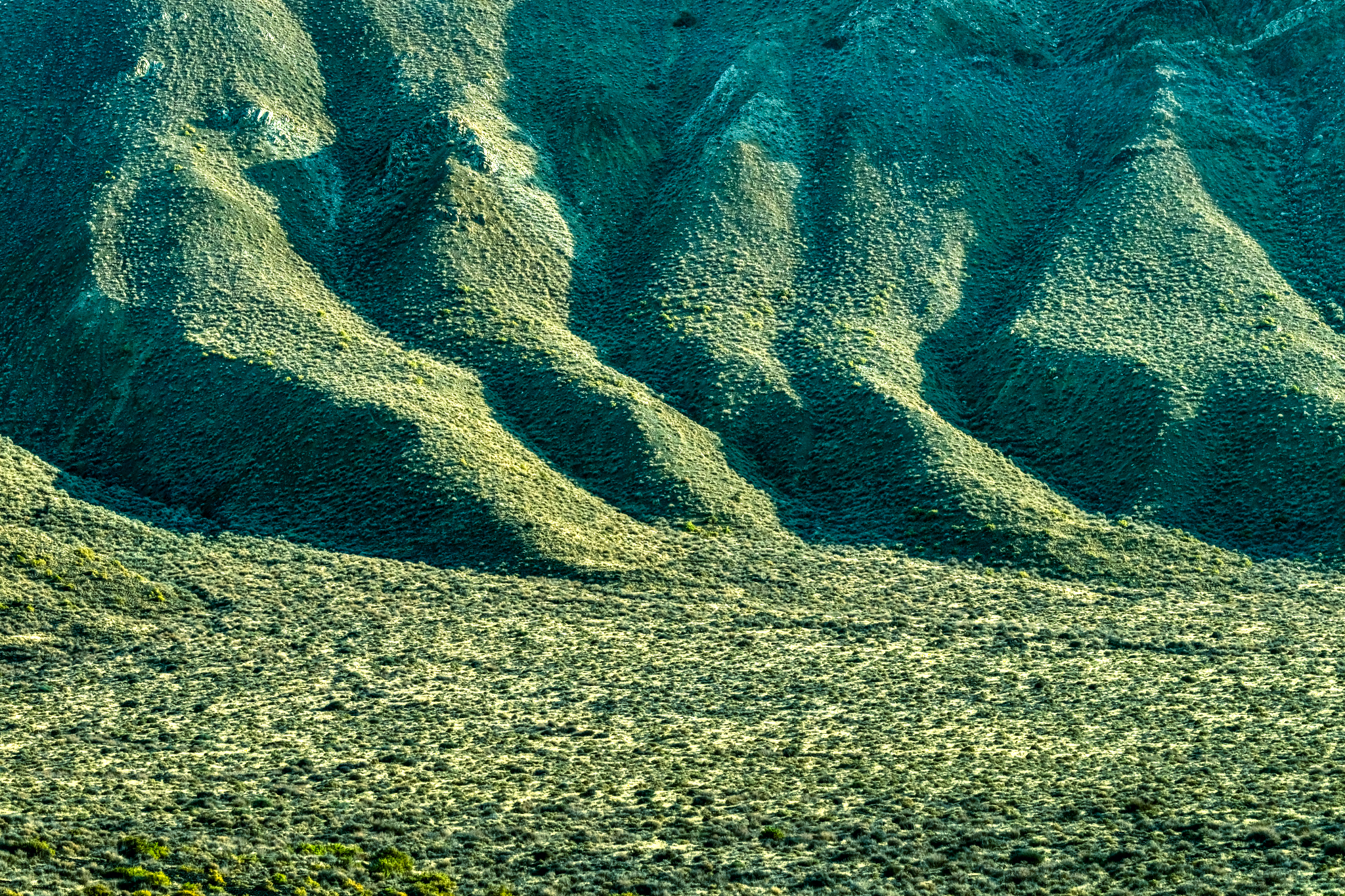 Long shadows on the desert hills.
Long shadows on the desert hills.
 In the five days I spent out of Winnemucca on the desert roads, I saw only two other cars . . . I caught up with this truck . . . but turned off before I got too close.
In the five days I spent out of Winnemucca on the desert roads, I saw only two other cars . . . I caught up with this truck . . . but turned off before I got too close.
 I eventually spotted this little track heading up into a gap in the rocky hills and thought it might be an interesting place to park my camper . . .
I eventually spotted this little track heading up into a gap in the rocky hills and thought it might be an interesting place to park my camper . . .
 GoogleMaps photo of my campsite . . . . a dream location for me!
GoogleMaps photo of my campsite . . . . a dream location for me!
 I drove up the sandy track and found a flat place to park . . . . the next morning I took this photo of the fine place I found . . . with a grand view of the Black Rock Desert.
I drove up the sandy track and found a flat place to park . . . . the next morning I took this photo of the fine place I found . . . with a grand view of the Black Rock Desert.

Looking away from the Black Rock Desert I had this view . . .
 My incredible desert canyon view . . . I wasn't sure which way to point my chair . . . the dry lake or the rocky canyon!!!
My incredible desert canyon view . . . I wasn't sure which way to point my chair . . . the dry lake or the rocky canyon!!!
 My view of the dry lake included an active train line . . . a couple times a day long freight trains would slowly pass below.
My view of the dry lake included an active train line . . . a couple times a day long freight trains would slowly pass below.
 My morning Grand View . . . I think I will go for a walk.
My morning Grand View . . . I think I will go for a walk.
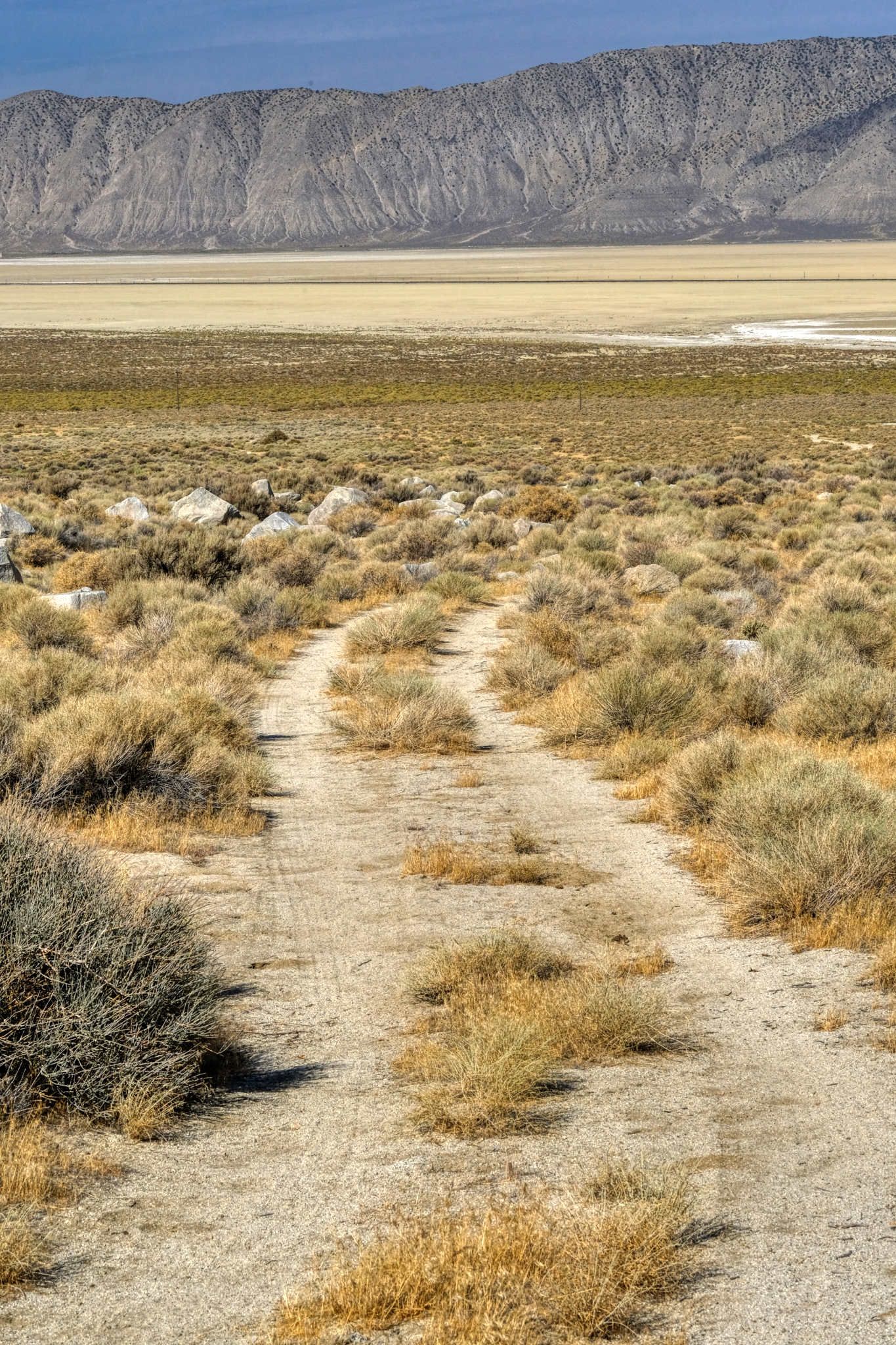 One morning I decided to walk down the sandy track and out onto the dry lake bed . . . for exercise . . . and curiosity.
One morning I decided to walk down the sandy track and out onto the dry lake bed . . . for exercise . . . and curiosity.
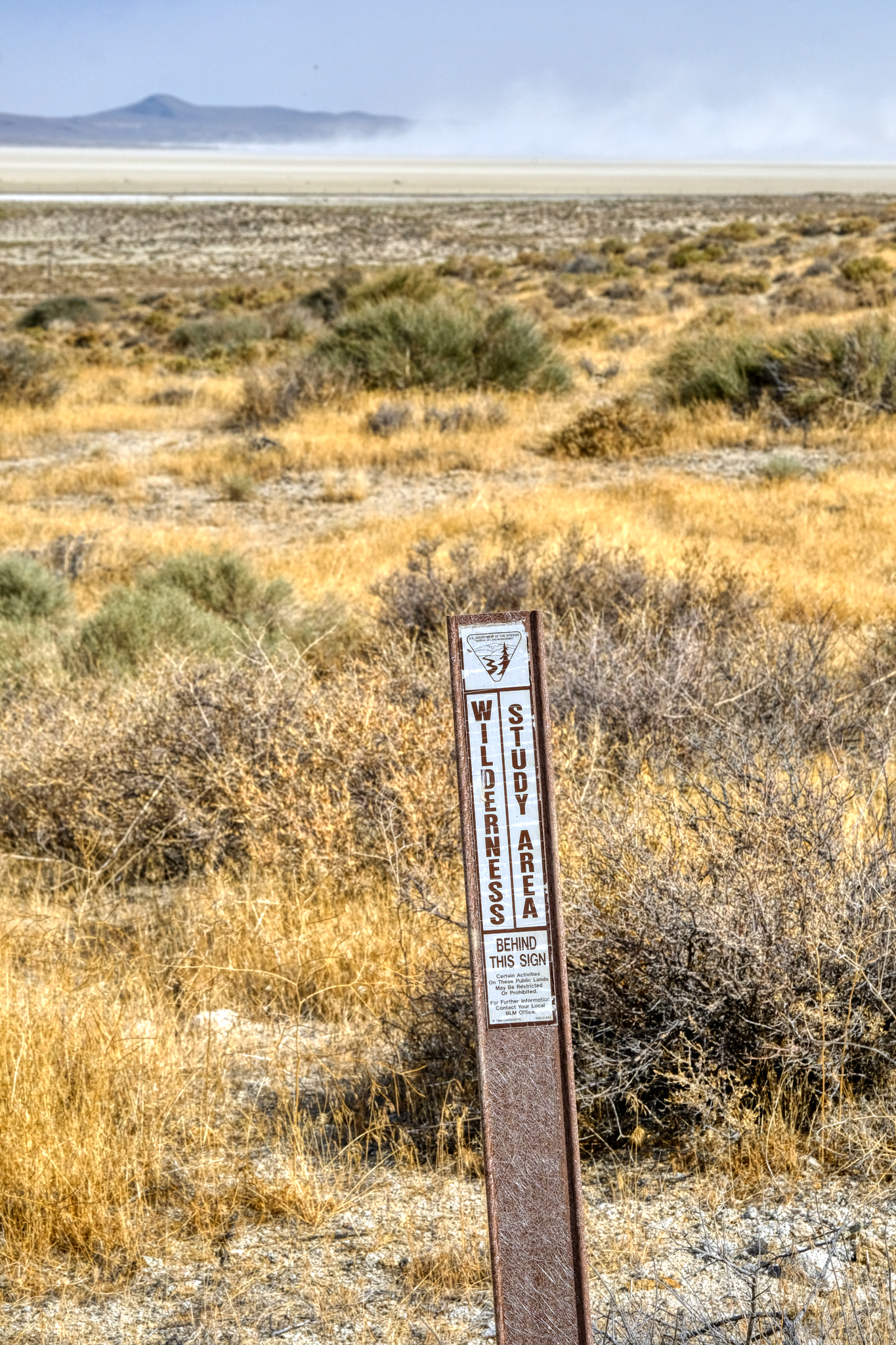 I was happy to see this sign . . . glad the area was being protected.
I was happy to see this sign . . . glad the area was being protected.
 At some point after I set up my camp, probably while I was staring at the mountainside, somebody rode a horse across my tire tracks on the sandy track. An interesting walk indeed!
At some point after I set up my camp, probably while I was staring at the mountainside, somebody rode a horse across my tire tracks on the sandy track. An interesting walk indeed!
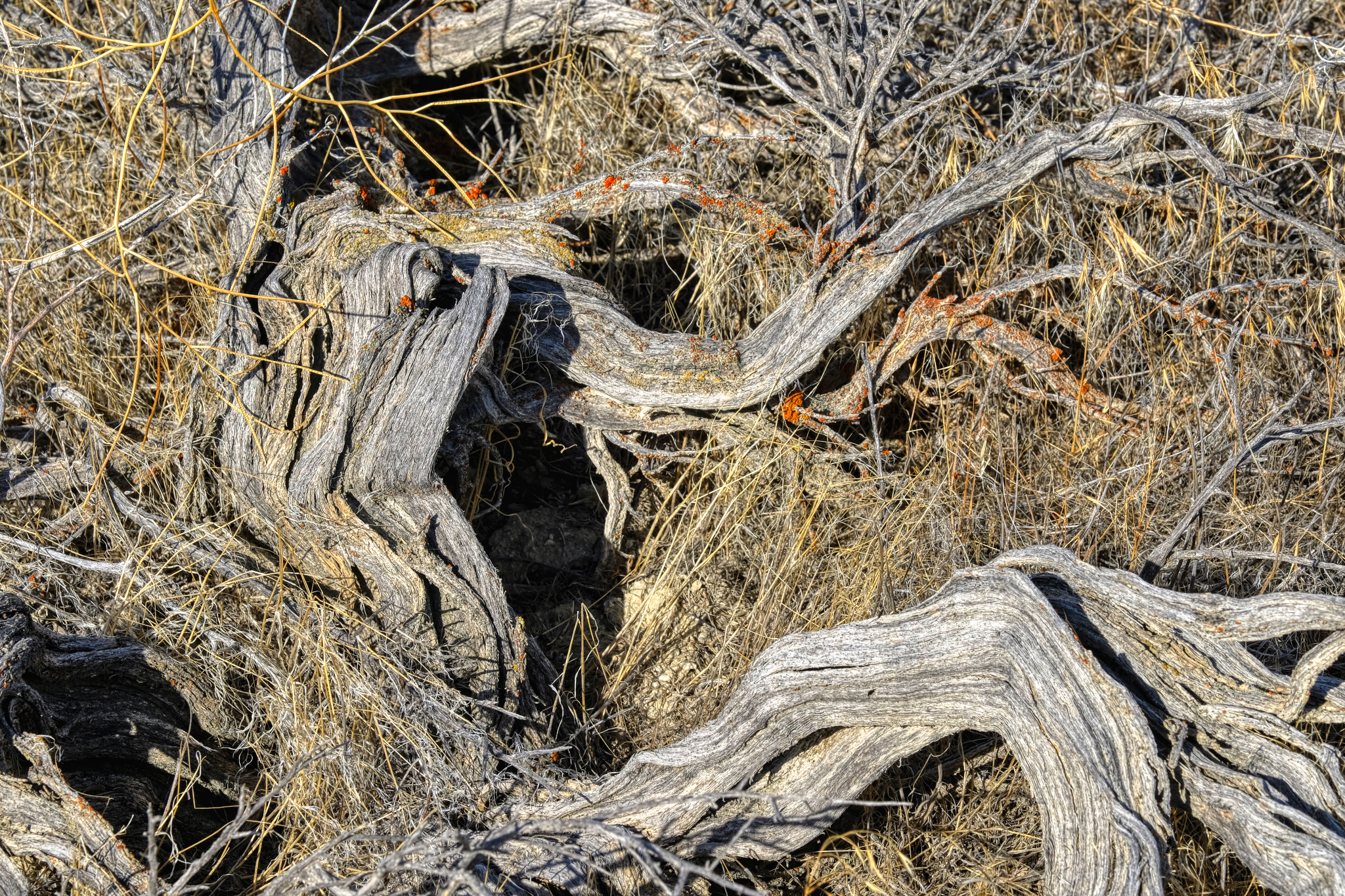 The marvelous morning light made for great photography of the desert flora.
The marvelous morning light made for great photography of the desert flora.
 These "desert reeds" was a complexity of beauty.
These "desert reeds" was a complexity of beauty.
 Wonderful complex patterns out here in "the middle of nowhere" . . .
Wonderful complex patterns out here in "the middle of nowhere" . . .
 Looking back up the track to my camper in the canyon.
Looking back up the track to my camper in the canyon.
 Walking further, I crossed Nevada State Highway 49 as I approached the wide dry lake bed.
Walking further, I crossed Nevada State Highway 49 as I approached the wide dry lake bed.
 A short stretch of scrub brush with phone poles leading to the little town of Gerlach, Nevada (pop. 107).
A short stretch of scrub brush with phone poles leading to the little town of Gerlach, Nevada (pop. 107).
 . . . and at last I stepped out onto the amazing surface of the Black Rock Desert.
. . . and at last I stepped out onto the amazing surface of the Black Rock Desert.
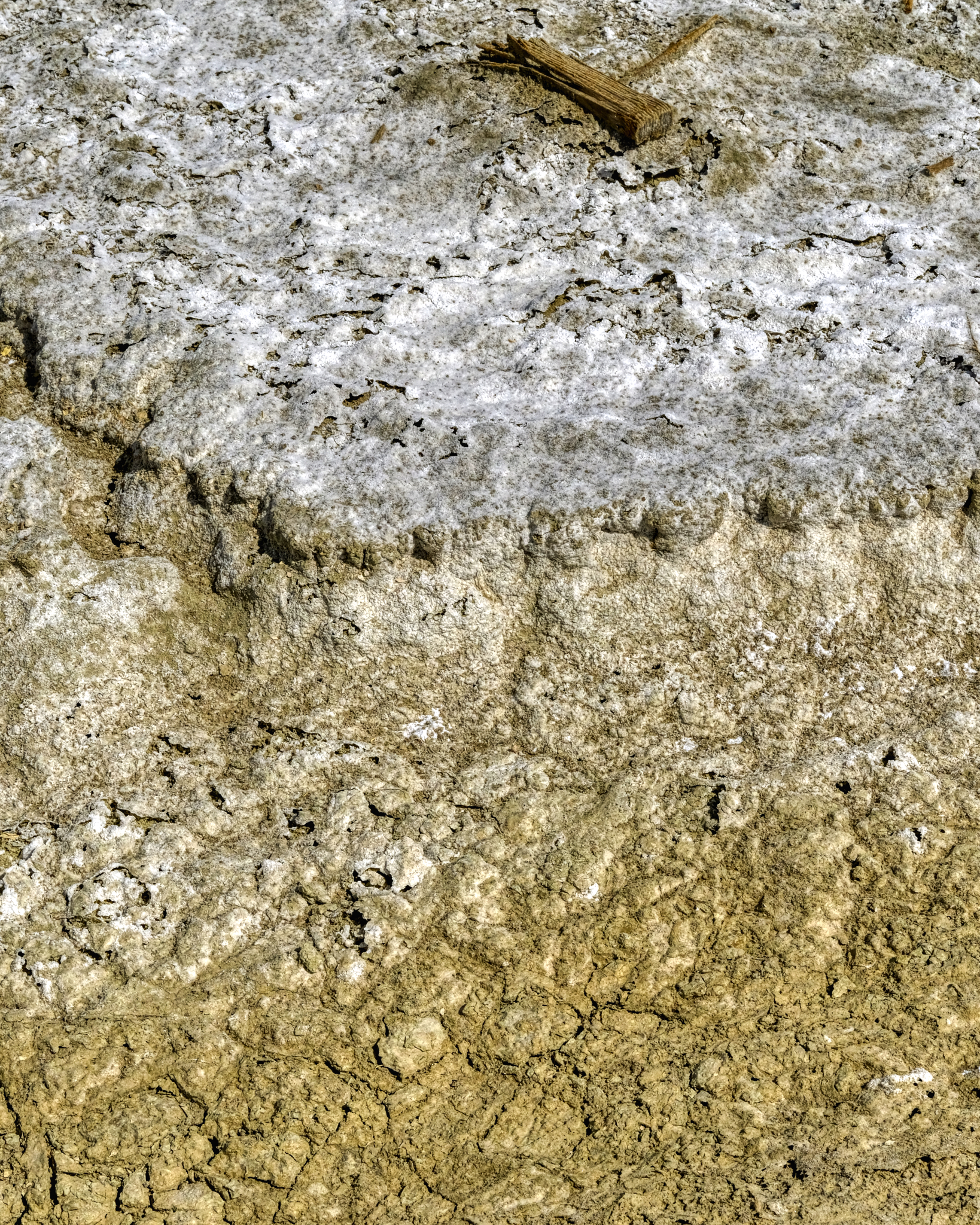 I love these desert/dry lake bed textures as photographic subjects. I was not disappointed here!
I love these desert/dry lake bed textures as photographic subjects. I was not disappointed here!
 Such delicately thin wafers of minerals spread out underfoot . . . I tried to avoid stepping on them.
Such delicately thin wafers of minerals spread out underfoot . . . I tried to avoid stepping on them.
 Salt or alkaline crusting . . . I do not know . . . I did not taste it.
Salt or alkaline crusting . . . I do not know . . . I did not taste it.
 Water had pooled here in the not too distant past.
Water had pooled here in the not too distant past.
 Much of this vast surface had this texture . . astonishing beauty!
Much of this vast surface had this texture . . astonishing beauty!
 Thin mineral wafers . . .
Thin mineral wafers . . .
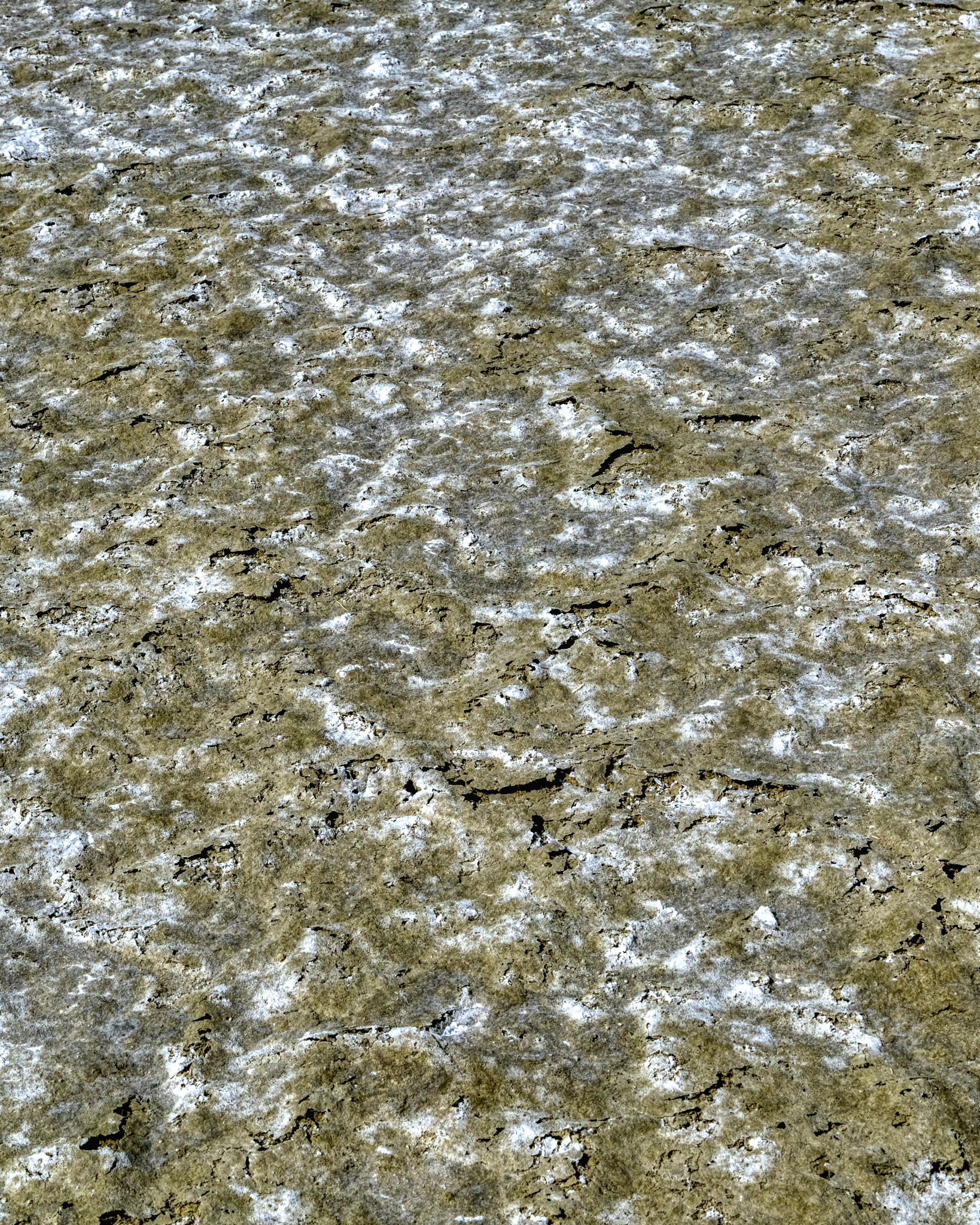 I crunched around on these amazing surfaces for quite awhile before turning back to my camper.
I crunched around on these amazing surfaces for quite awhile before turning back to my camper.
 I walked back to my camper by way of this little canyon . . .
I walked back to my camper by way of this little canyon . . .
 . . . the only wildlife I saw during my five days in the Black Rock Desert . . . one lone bird. There weren't even any insects.
. . . the only wildlife I saw during my five days in the Black Rock Desert . . . one lone bird. There weren't even any insects.
 What I did have in the place of wildlife was geology . . . lots of fascinating geology.
What I did have in the place of wildlife was geology . . . lots of fascinating geology.
 Back at my campsite, settled into my camp chair, I sat enjoying the rest of the day . . . reading, snacking, drinking lots of water . . . and, yes, checking my iPhone for messages . . . as there was very good (4 bars) Internet way out there!
Back at my campsite, settled into my camp chair, I sat enjoying the rest of the day . . . reading, snacking, drinking lots of water . . . and, yes, checking my iPhone for messages . . . as there was very good (4 bars) Internet way out there!
 A nice dust storm blew up mid afternoon . . .
A nice dust storm blew up mid afternoon . . .
 . . . and then a wonderful 'dust devil' blew across the dry lake bed. (Excuse the quality of this photo - a lot of dust in the air at this time).
. . . and then a wonderful 'dust devil' blew across the dry lake bed. (Excuse the quality of this photo - a lot of dust in the air at this time).
 The sunsets were magnificent!
The sunsets were magnificent!
 The colors!!!
The colors!!!
 "You are in the forest, but you are on the desert."
"You are in the forest, but you are on the desert."
 A morning view out over the dry lake bed of the Black Rock Desert.
A morning view out over the dry lake bed of the Black Rock Desert.
 As I discovered, my 'lucky' campsite had not been so lucky for a former visitor to the spot. There was the charred remains of a burned out motorhome not far away. I left this message for future visitors, "Amor Fati."
As I discovered, my 'lucky' campsite had not been so lucky for a former visitor to the spot. There was the charred remains of a burned out motorhome not far away. I left this message for future visitors, "Amor Fati."
 I diagnosed the motorhome's problem as an 'overheating problem in the engine.'
I diagnosed the motorhome's problem as an 'overheating problem in the engine.'
 After five days my camper batteries had gone down, so I folded up my sun shade and loaded the table, chairs, porta-potty, and BBQ back into the camper and headed back down the hill. I had had a wonderful and relaxed time just sitting, reading, thinking, wandering around the desert, and enjoying the view. Perfect.
After five days my camper batteries had gone down, so I folded up my sun shade and loaded the table, chairs, porta-potty, and BBQ back into the camper and headed back down the hill. I had had a wonderful and relaxed time just sitting, reading, thinking, wandering around the desert, and enjoying the view. Perfect.
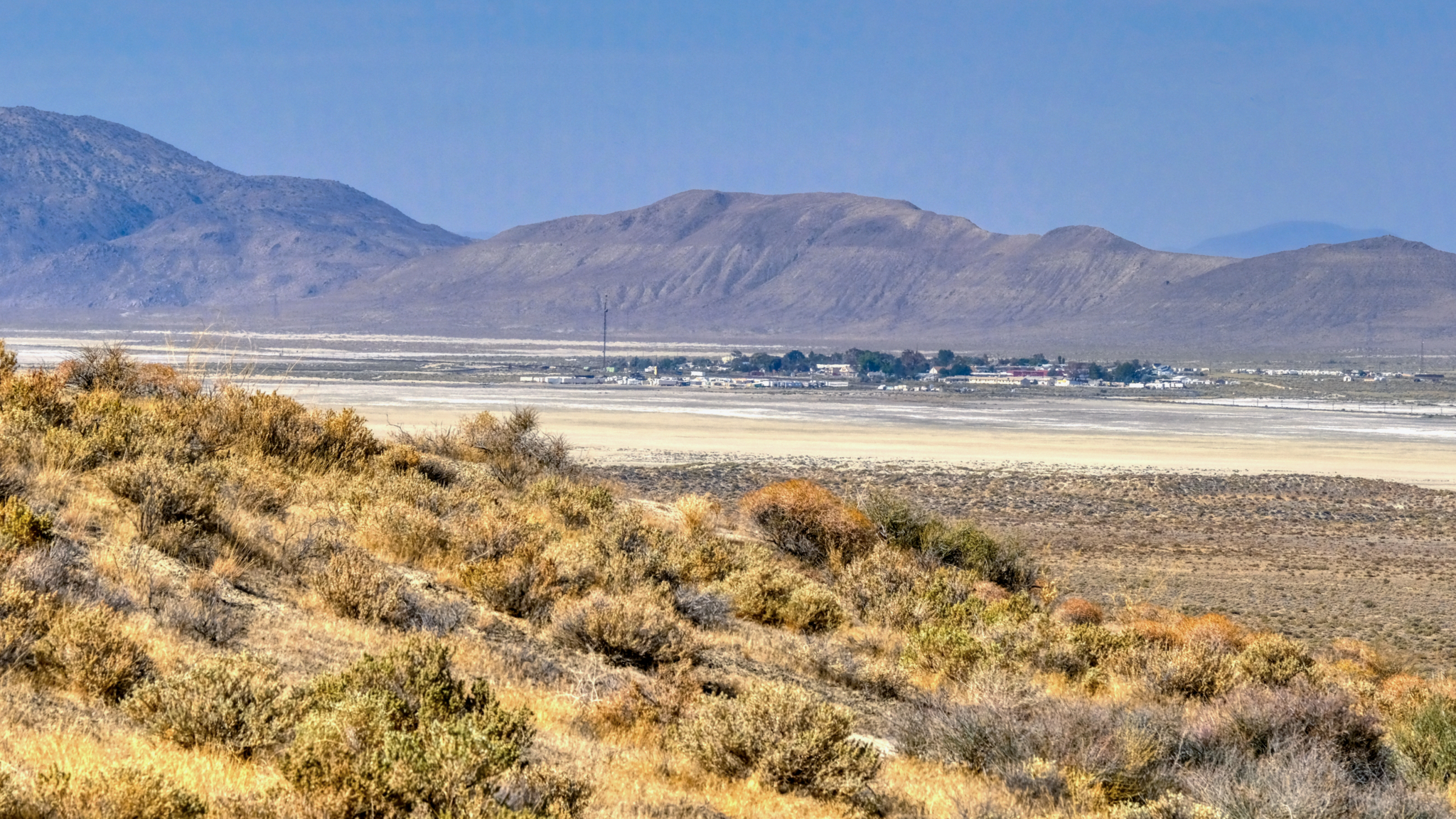 And then back out on Nevada Highway 49 into Gerlach (pop. 107) . . . and civilization! I stopped in at the only cafe and had a 'real' breakfast and good coffee. I also stopped in at the Burning Man Main Office to find a harried woman dealing with major complaints of some of the attendees . . . the Burning Man event was just two weeks before . . . I intervened and counseled peace and understanding. People calmed down. My work was done. I stopped at the little store and bought a large bag of Cheetos and a couple of Coke Zeros for the drive back to Winnemucca.
And then back out on Nevada Highway 49 into Gerlach (pop. 107) . . . and civilization! I stopped in at the only cafe and had a 'real' breakfast and good coffee. I also stopped in at the Burning Man Main Office to find a harried woman dealing with major complaints of some of the attendees . . . the Burning Man event was just two weeks before . . . I intervened and counseled peace and understanding. People calmed down. My work was done. I stopped at the little store and bought a large bag of Cheetos and a couple of Coke Zeros for the drive back to Winnemucca.
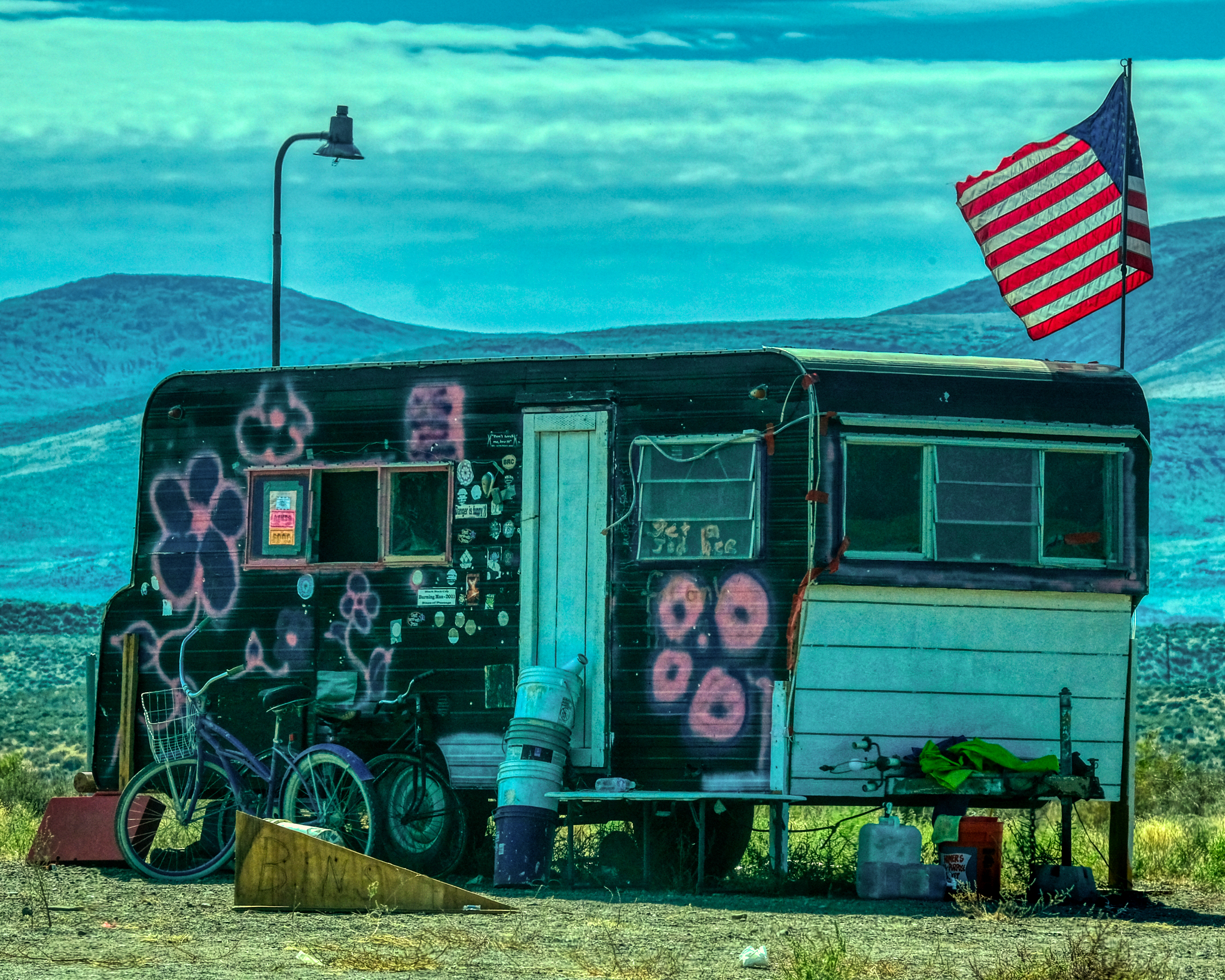 From Gerlach I headed south on Nevada Highway 447 toward Interstate 80 and then back to Winnemucca. But I could not resist stopping and getting this photo of REAL AMERICAN FREEDOM! "Turn on, tune in, and drop out" anyone?
From Gerlach I headed south on Nevada Highway 447 toward Interstate 80 and then back to Winnemucca. But I could not resist stopping and getting this photo of REAL AMERICAN FREEDOM! "Turn on, tune in, and drop out" anyone?
 Ancient Pyramid Lake and the town of Nixon was my last stop before I entered I-80. A shower, washing machine, and NFL games in the casino lounge were waiting for me.
Ancient Pyramid Lake and the town of Nixon was my last stop before I entered I-80. A shower, washing machine, and NFL games in the casino lounge were waiting for me.
 A great trip!
A great trip!
 Dr. Jeff Harper
Dr. Jeff Harper
Some of the photos of the abandoned miners' 'town' demanded black and white post-processing . . . here they are without comment:




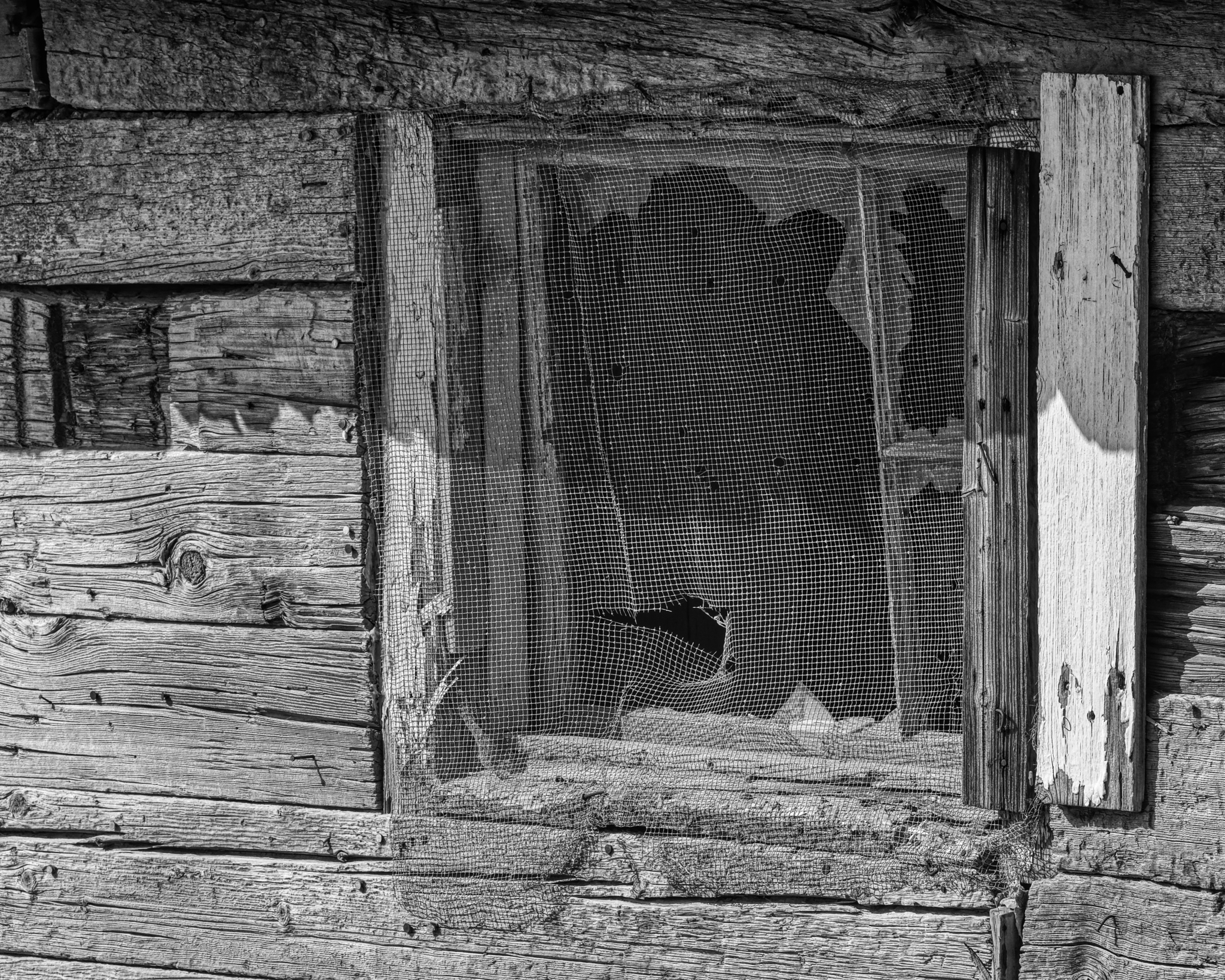


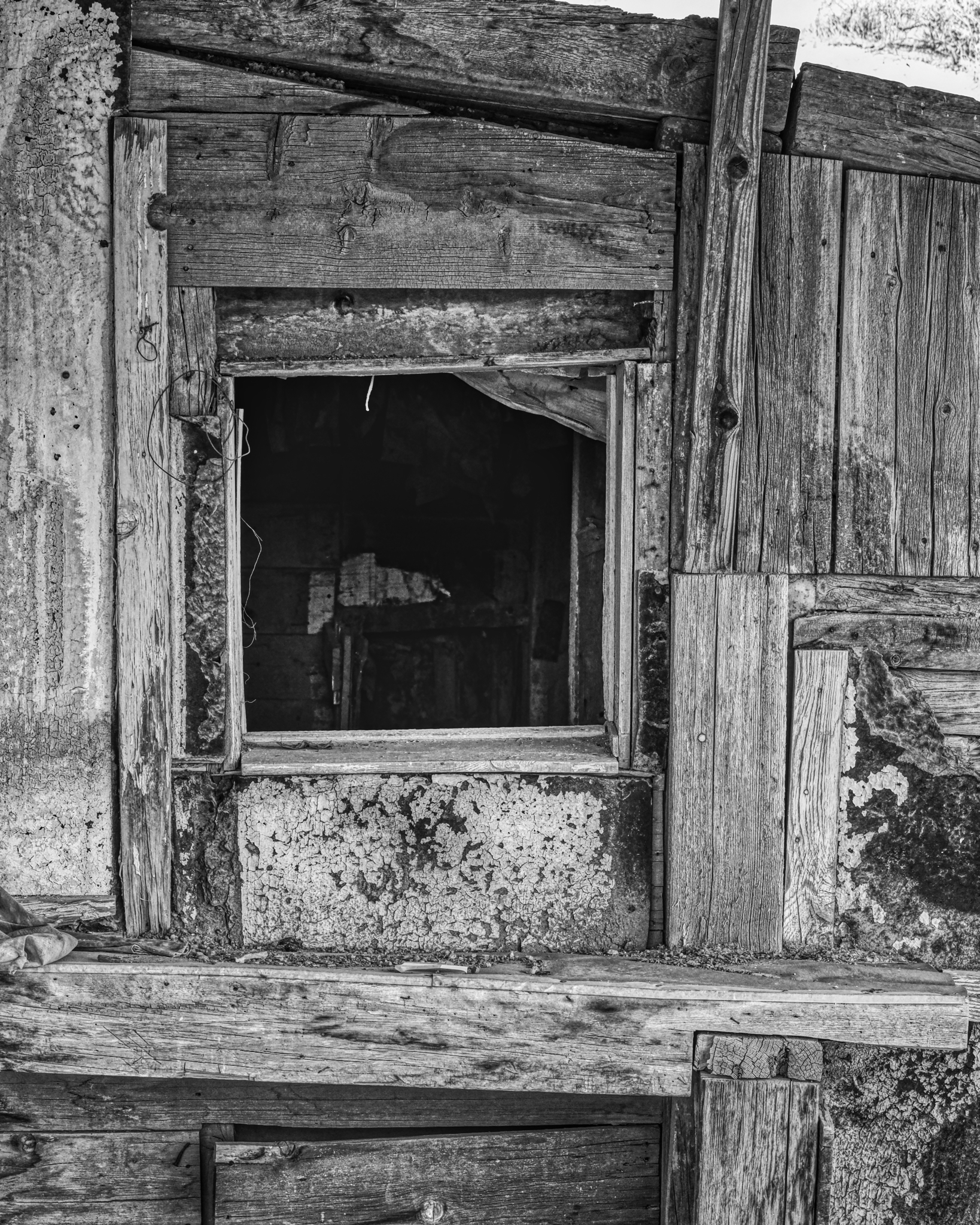



Ratchaburi Ramble
 Wednesday, April 6, 2022 at 5:36PM
Wednesday, April 6, 2022 at 5:36PM One of the benefits of having a wife who is a serious golfer is that I get to tag along when she goes on an out-of-Bangkok golf junket with her pals. We were on vacation in the seaside town of Hua Hin and made the short drive north to the Ratchaburi Royal Golf Club early one morning after a spactacular sunrise over the Gulf of Thailand . . . . and while she played a competitive round, I explored the nearby countryside, the old town market in Ratchaburi town, and the 10th century Wat Mahathat Worawihan.
 It's nice to sit on the balcony drinking the the first morning cup of coffee while the sun is rising over the Gulf of Thailand. The squid fishermen were returning with their catch after having been out to sea all night.
It's nice to sit on the balcony drinking the the first morning cup of coffee while the sun is rising over the Gulf of Thailand. The squid fishermen were returning with their catch after having been out to sea all night.
 Along the Ratchaburi highway . . . a giant Buddha statue . . . without a place name.
Along the Ratchaburi highway . . . a giant Buddha statue . . . without a place name.
 Only an hour and 45 minutes away . . . up and into the hilly Ratchaburi Province.
Only an hour and 45 minutes away . . . up and into the hilly Ratchaburi Province.
 Small provincial roads in Thailand always serve up some amazing sights.
Small provincial roads in Thailand always serve up some amazing sights.
 Yes, they have monkeys in Thailand. This one, and about 20 of his buddies kept me from leaving my car to walk up a trail to a large cave Buddha temple.
Yes, they have monkeys in Thailand. This one, and about 20 of his buddies kept me from leaving my car to walk up a trail to a large cave Buddha temple.
 As I was on a 'ramble', I had no particular place to go. I made my way to Ratchaburi, a town I had never visited. I arrived in Ratchaburi on small roads and on the outskirts of town I discovered this wonderful place: The Ratchaburi National Museum.
As I was on a 'ramble', I had no particular place to go. I made my way to Ratchaburi, a town I had never visited. I arrived in Ratchaburi on small roads and on the outskirts of town I discovered this wonderful place: The Ratchaburi National Museum.
 It was a gorgeous building . . . old Thai monumental style.
It was a gorgeous building . . . old Thai monumental style.
 There were two buildings on the museum property. I adored the patina, color, and style of this old gem.
There were two buildings on the museum property. I adored the patina, color, and style of this old gem.
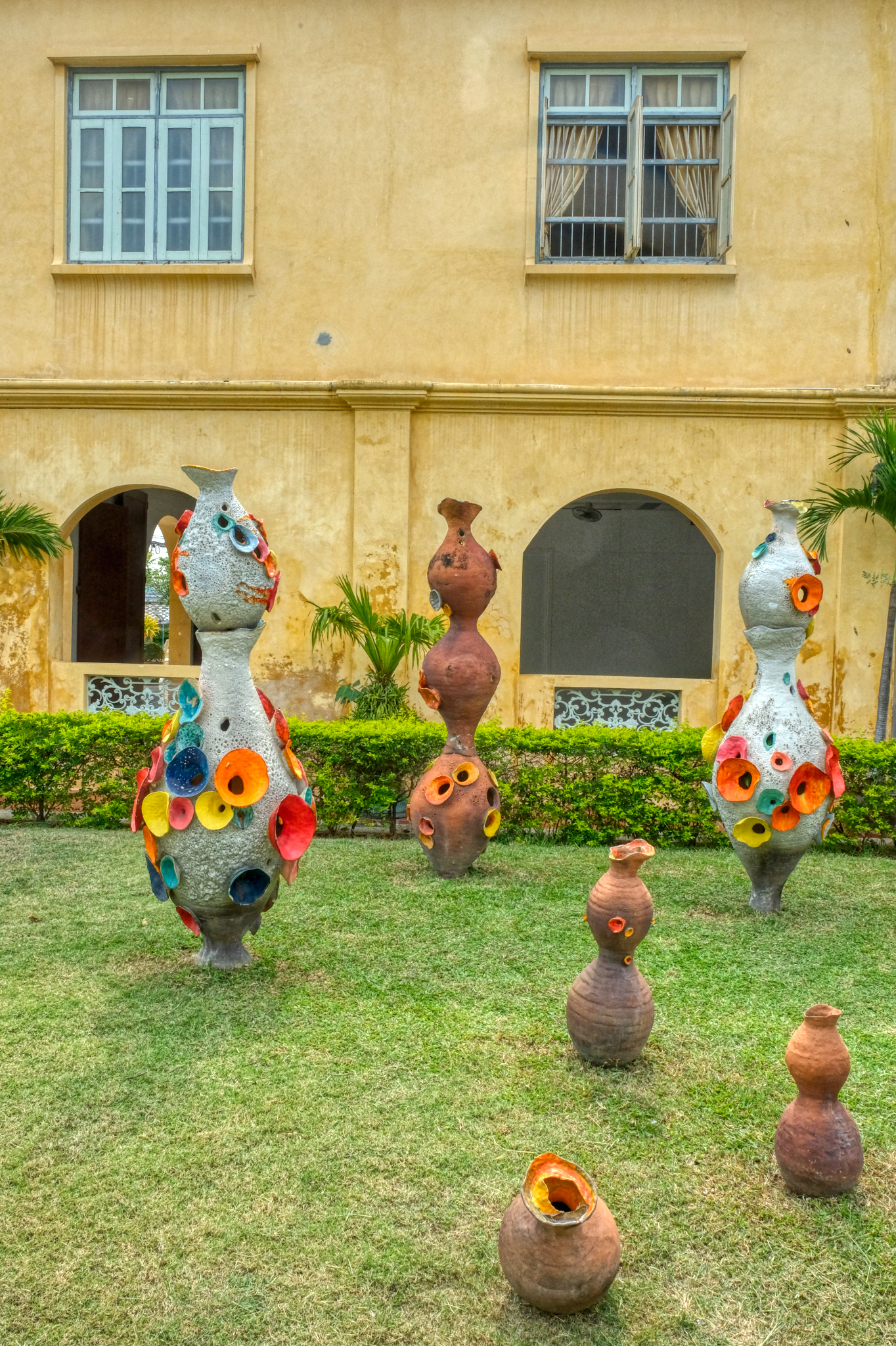 Being a museum, they had yard art too.
Being a museum, they had yard art too.
 This large metal sculpture was fantastic.
This large metal sculpture was fantastic.
 Made entirely of ordinary steel washers and small squares of steel. Amazing.
Made entirely of ordinary steel washers and small squares of steel. Amazing.
 The museum rules strictly prohibited photography of the exhibits . . . and they enforced this rule by having one of the museum staff follow me from room to room. They did, however, allow me to photograph the halls and courtyard when I asked.
The museum rules strictly prohibited photography of the exhibits . . . and they enforced this rule by having one of the museum staff follow me from room to room. They did, however, allow me to photograph the halls and courtyard when I asked.
 The museum collection was excellent and very well organized. The exhibits began in prehistory and ancient geology of the area and proceeded chronologically as you walked from room to room around the courtyard. It was one of the best, most informative provincial museums I have been to anywhere in the world.
The museum collection was excellent and very well organized. The exhibits began in prehistory and ancient geology of the area and proceeded chronologically as you walked from room to room around the courtyard. It was one of the best, most informative provincial museums I have been to anywhere in the world.
 I next drove into the town center and the old city center market. The market occupies the inside center alleyways of several blocks along the Mae Klong River.
I next drove into the town center and the old city center market. The market occupies the inside center alleyways of several blocks along the Mae Klong River.
 As I left the museum I looked on my GoogleMaps and spotted a river and "Old Town Market" . . . so I drove straight there. I love these old town, city center markets in Thailand's small cities. This market would have been in it's prime during the 1950s and 1960s.
As I left the museum I looked on my GoogleMaps and spotted a river and "Old Town Market" . . . so I drove straight there. I love these old town, city center markets in Thailand's small cities. This market would have been in it's prime during the 1950s and 1960s.
 The old markets are the remnants of the oldest parts of Thai cities and maintain an older way of doing business.
The old markets are the remnants of the oldest parts of Thai cities and maintain an older way of doing business.
 The city or local area government seems to have taken an interest in this old market. Many of the walls and old panel doors seem to have been painted recently. It looked very good.
The city or local area government seems to have taken an interest in this old market. Many of the walls and old panel doors seem to have been painted recently. It looked very good.
 A colorful advertisement on the panel doors.
A colorful advertisement on the panel doors.
 History in paint.
History in paint.
 Small business in the alleys, which are themselves lined with very old small shops.
Small business in the alleys, which are themselves lined with very old small shops.
 My first thought when seeing this shop was, 'supply and demand.' What kind of world is outside of this market can be deduced by what one sees for sale in it. There is an old pattern of consumption, imbedded in the cultural practices, the anthropology of food, that still demands these items.
My first thought when seeing this shop was, 'supply and demand.' What kind of world is outside of this market can be deduced by what one sees for sale in it. There is an old pattern of consumption, imbedded in the cultural practices, the anthropology of food, that still demands these items.
 Times change. There was a time, maybe 50 years ago, when this shop was at the center of the Ratchaburi commercial center. You came here, and here only, if you wanted to buy a pair of new shoes. But the city grew in a different direction: what was the busy hub of activity has now became the backwater of the old town 'wet market.' This old man seems to have been here as long as the furniture. He doesn't even bother to dust off the shoes any more.
Times change. There was a time, maybe 50 years ago, when this shop was at the center of the Ratchaburi commercial center. You came here, and here only, if you wanted to buy a pair of new shoes. But the city grew in a different direction: what was the busy hub of activity has now became the backwater of the old town 'wet market.' This old man seems to have been here as long as the furniture. He doesn't even bother to dust off the shoes any more.
 She is still hopeful and making an effort. These shops have suffered terribly during the pandemic: people do not like to congregate in the tight quarters of these narrow alleyways. I am sure she lives in the back of this shop.
She is still hopeful and making an effort. These shops have suffered terribly during the pandemic: people do not like to congregate in the tight quarters of these narrow alleyways. I am sure she lives in the back of this shop.
 Tucked away deep in the old market is the spirit house/spirit altar for the shopkeepers to leave their offerings in hopes of better luck. The flowers and other offerings were all fresh from this very morning.
Tucked away deep in the old market is the spirit house/spirit altar for the shopkeepers to leave their offerings in hopes of better luck. The flowers and other offerings were all fresh from this very morning.
 This dry goods shop in the old market seemed to be doing pretty good. You have to remember that less than a mile from this spot there are several multinational big box giant supermarkets. It is hard to understand how these small shops survive. I assume it survives by servicing those who work in the old market itself.
This dry goods shop in the old market seemed to be doing pretty good. You have to remember that less than a mile from this spot there are several multinational big box giant supermarkets. It is hard to understand how these small shops survive. I assume it survives by servicing those who work in the old market itself.
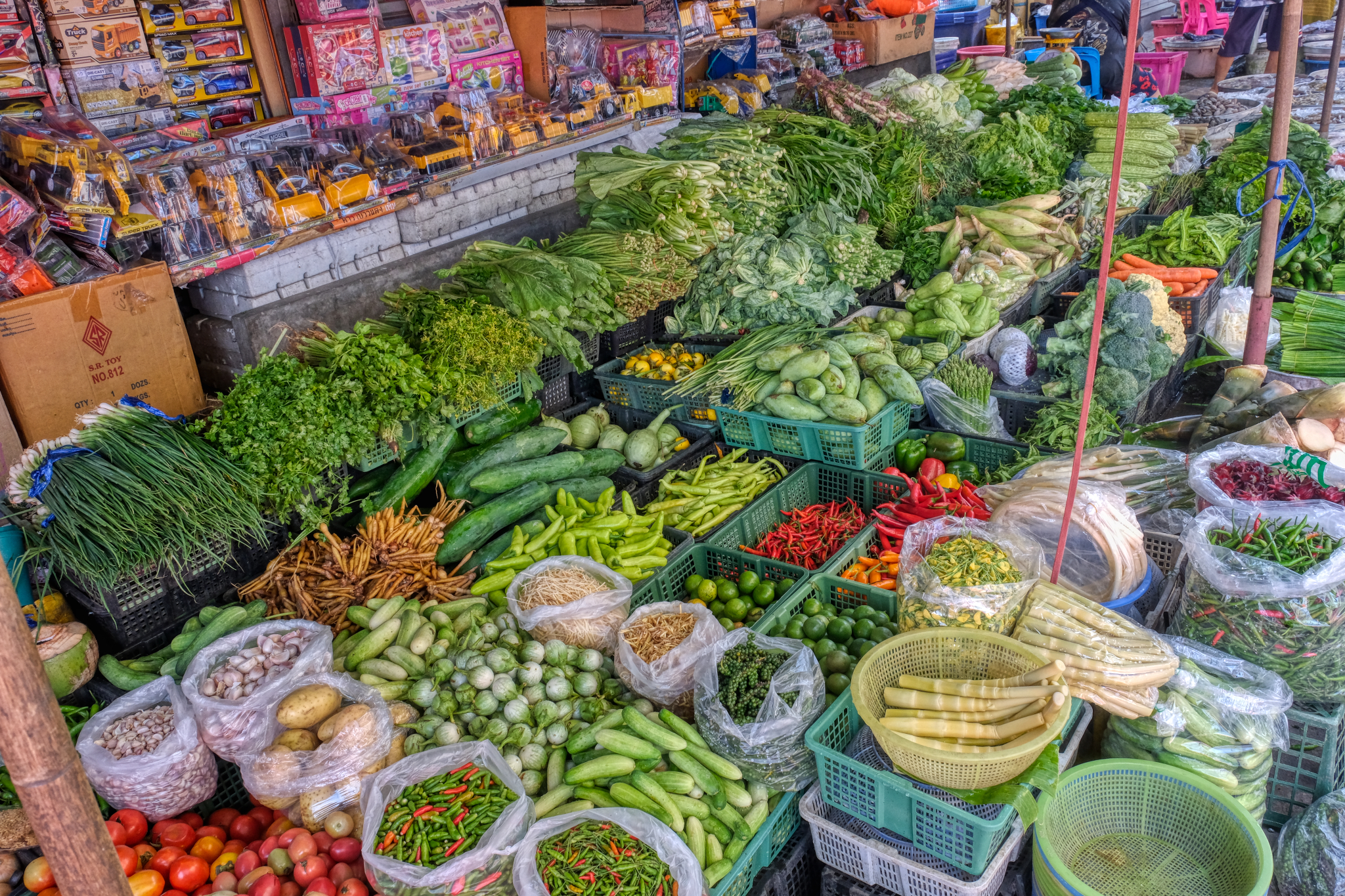 There were many sections of the old town market, and of course, one of them was for fresh fruits and vegetables. So delicious in Thailand.
There were many sections of the old town market, and of course, one of them was for fresh fruits and vegetables. So delicious in Thailand.
 Banana flower hearts . . . used in some Thai dishes.
Banana flower hearts . . . used in some Thai dishes.
 I had never seen this before . . . some kind of flower bud for use in one of the many thousands of Thai dishes.
I had never seen this before . . . some kind of flower bud for use in one of the many thousands of Thai dishes.
 Although most of the market I saw so far was clean, neat, and recently refurbished, I eventually found the oldest part of the market. It was partially abandoned and the commerce there seemed to be left to the poorest people.
Although most of the market I saw so far was clean, neat, and recently refurbished, I eventually found the oldest part of the market. It was partially abandoned and the commerce there seemed to be left to the poorest people.
 Old plastic rain flies over meagre offerings in the old, dead market. It is here we see the dilapidation caused by the corporate big box stores a couple of blocks away. I LOVE this photo.
Old plastic rain flies over meagre offerings in the old, dead market. It is here we see the dilapidation caused by the corporate big box stores a couple of blocks away. I LOVE this photo.
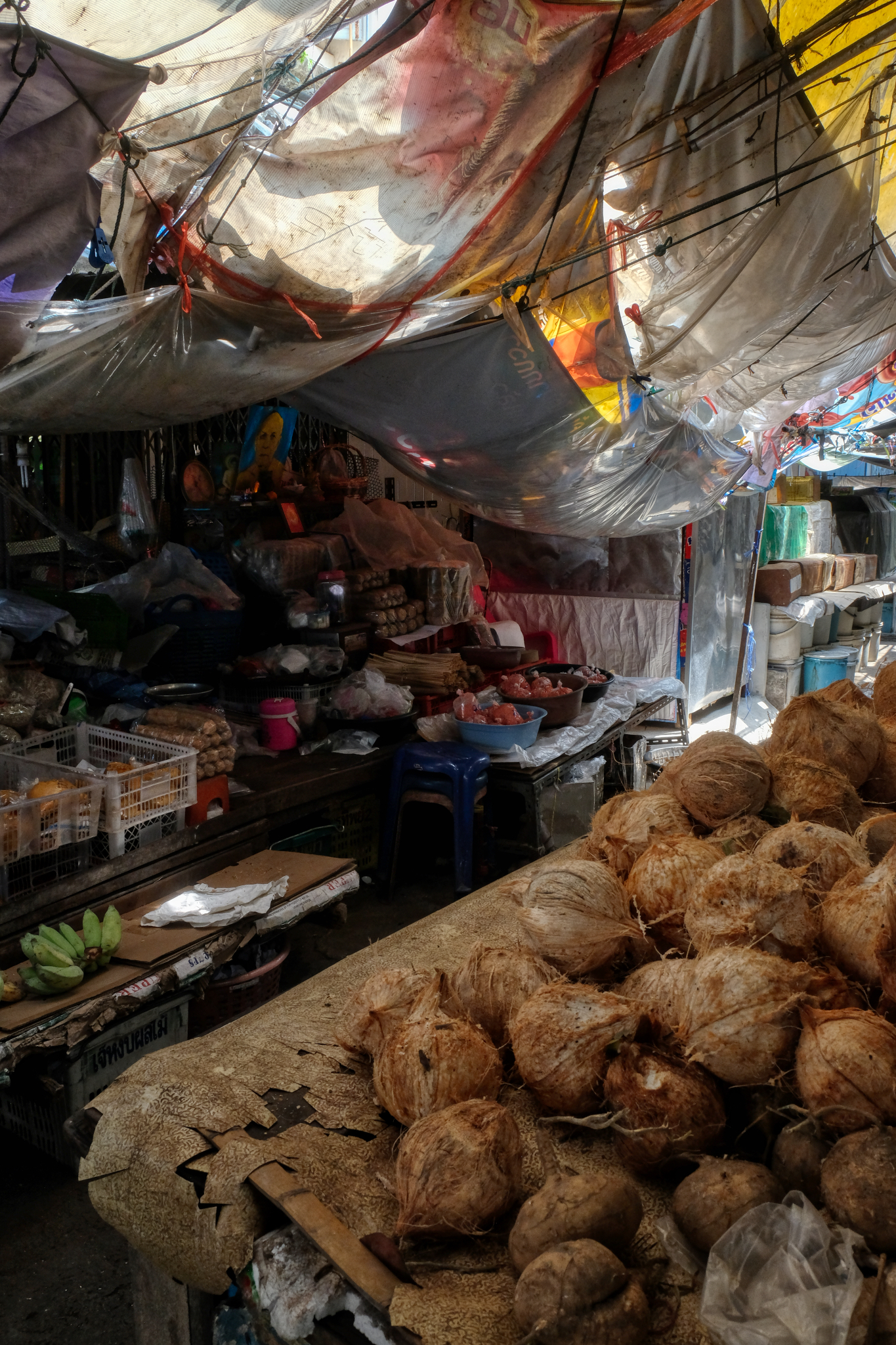 Old coconuts for sale.
Old coconuts for sale.
 I was the ONLY person in this part of the market. Nobody was here, not even the merchants . . . at 10:00 in the morning.
I was the ONLY person in this part of the market. Nobody was here, not even the merchants . . . at 10:00 in the morning.
 I tried to imagine what this 'business' was . . . but came up short.
I tried to imagine what this 'business' was . . . but came up short.

Outside of the inner alleyways of the old market, along the city streets, are more businesses. Here ,a hardware store.
 Shops that have everything a local resident would want and need.
Shops that have everything a local resident would want and need.
 If it can be made out of straw, bamboo, or wicker . . . . they have it here.
If it can be made out of straw, bamboo, or wicker . . . . they have it here.
 Of course, if it can be made out of straw, bamboo, or wicker . . . it can also be made out of plastic.
Of course, if it can be made out of straw, bamboo, or wicker . . . it can also be made out of plastic.
 The owner of this shop told me it was restored to how it was when her family started it 100 years ago. A beautiful look into the past times in Thailand.
The owner of this shop told me it was restored to how it was when her family started it 100 years ago. A beautiful look into the past times in Thailand.
 When I came to live in Thailand 26 years ago these samlors were ubiquitous. There would always be 20-30 of these 'pedal cabs' lied up next to the wet markets ready to take the customers home. Now it is rare to see them anywhere any more.
When I came to live in Thailand 26 years ago these samlors were ubiquitous. There would always be 20-30 of these 'pedal cabs' lied up next to the wet markets ready to take the customers home. Now it is rare to see them anywhere any more.
 The "modern" Ratchiburi commercial center, dating from the 1970s and 1980s. Of course the true 'modern' Ratchiburi commercial zone is now located in the multinational Big Box stores and shopping malls that dot the major roads leading in and out of the town . . . and the Thais drive there in their pick-up trucks.
The "modern" Ratchiburi commercial center, dating from the 1970s and 1980s. Of course the true 'modern' Ratchiburi commercial zone is now located in the multinational Big Box stores and shopping malls that dot the major roads leading in and out of the town . . . and the Thais drive there in their pick-up trucks.
 My last stop was at the amazing 10th century Wat Mahathat Worawihan.
My last stop was at the amazing 10th century Wat Mahathat Worawihan.
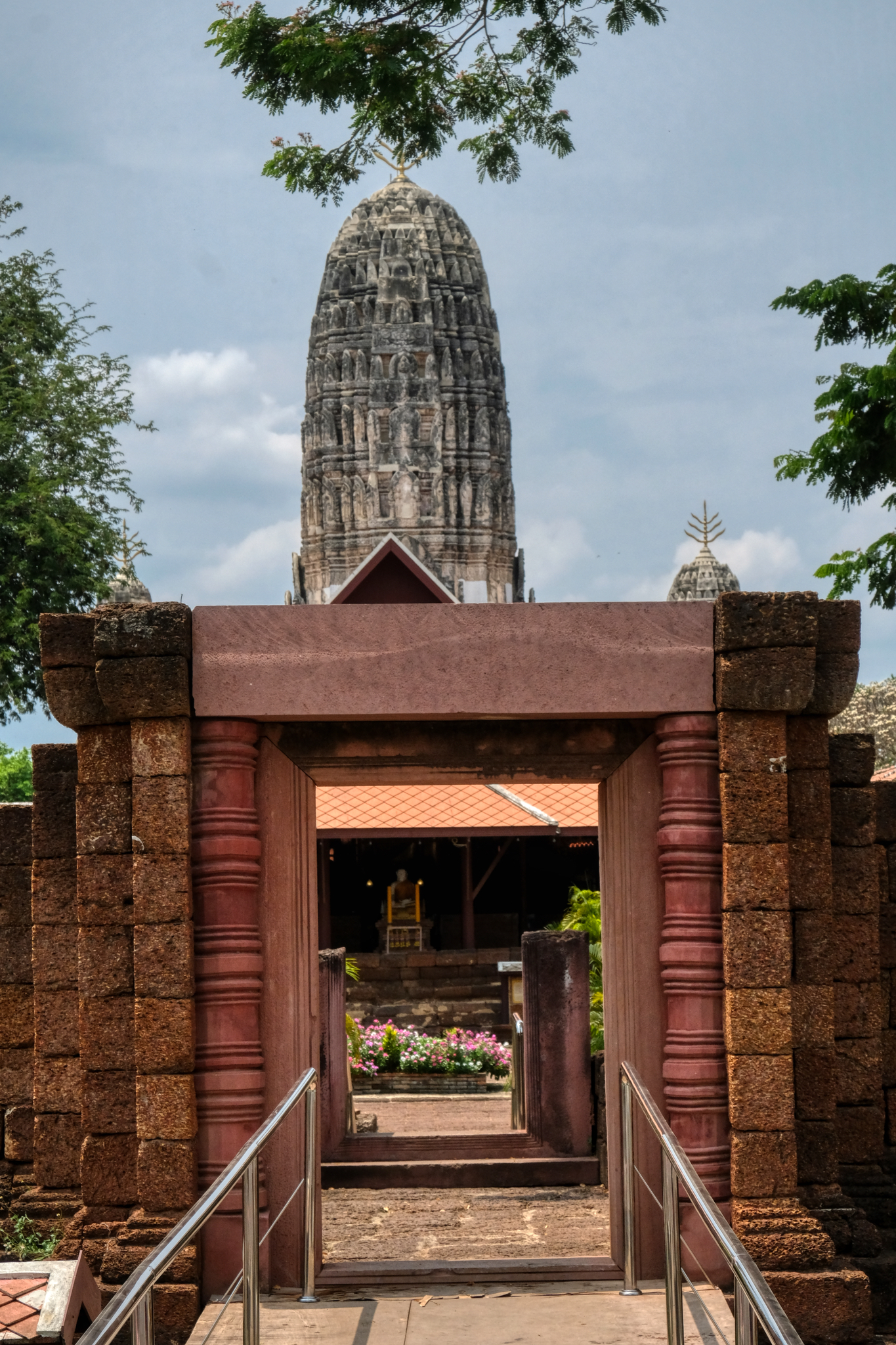 The front gate of Wat Mahathat Worawihan did not impress. But what was within astonished me.
The front gate of Wat Mahathat Worawihan did not impress. But what was within astonished me.
 My first inkling about the beauty within this was was when I looked through a small building's window and saw this.
My first inkling about the beauty within this was was when I looked through a small building's window and saw this.
 The sala/temple straight ahead looked inviting. I could see a large Buddha image within.
The sala/temple straight ahead looked inviting. I could see a large Buddha image within.
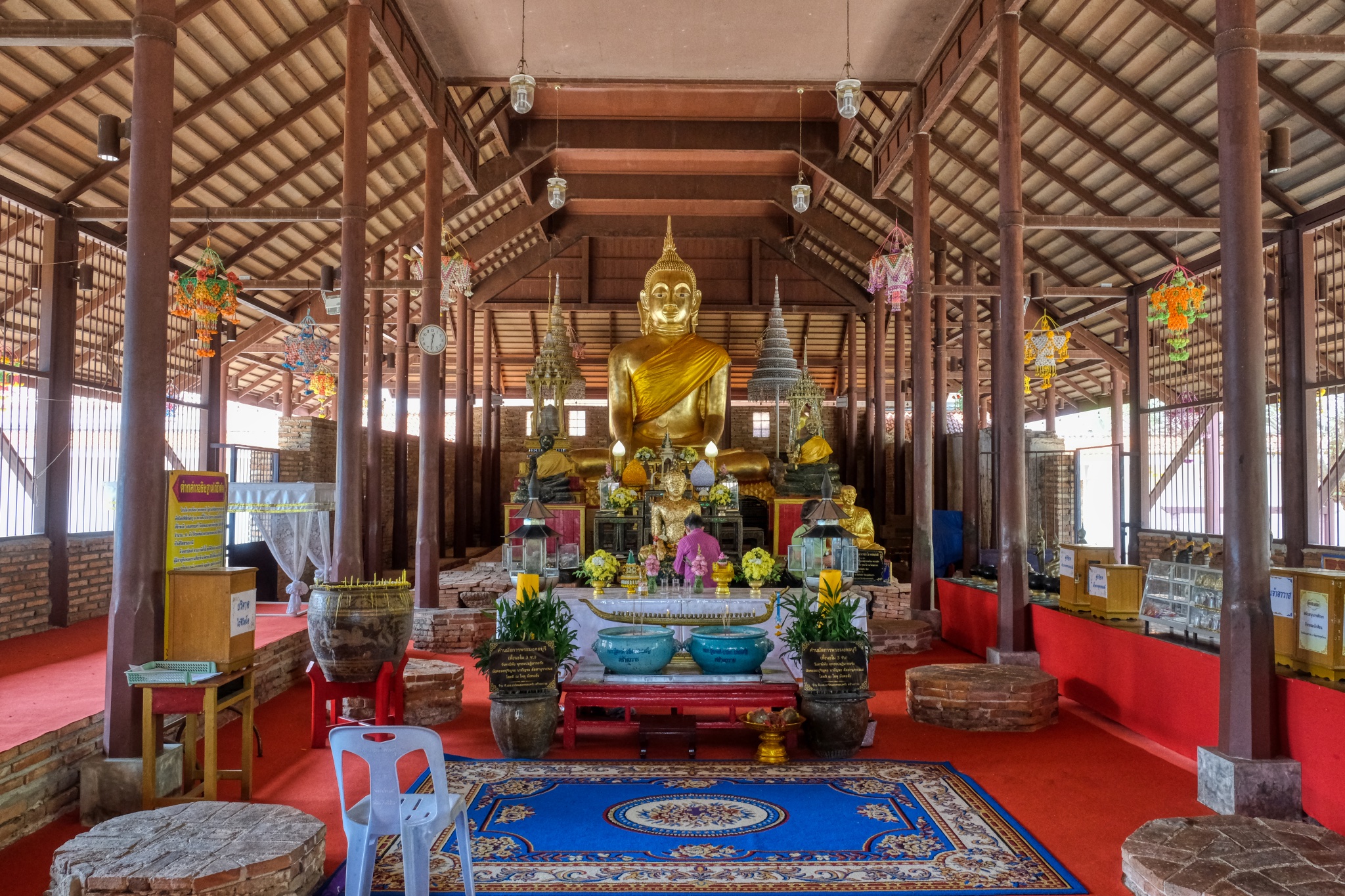 I took my shoes off and went in and discovered this remarkable spiritual space. If you look closely you can see the bases of the pillars that held up an earlier temple in the same location. "It is believed that this temple was built in the Dvaravati Period, around the 10th-11th Century, nearly the same time as when the old city of Ratchaburi was built. Later, a Khmer or Lop Buri sanctuary was built over the temple around the 13th Century to be the centre of the town according to the Khmer belief regarding the universe."
I took my shoes off and went in and discovered this remarkable spiritual space. If you look closely you can see the bases of the pillars that held up an earlier temple in the same location. "It is believed that this temple was built in the Dvaravati Period, around the 10th-11th Century, nearly the same time as when the old city of Ratchaburi was built. Later, a Khmer or Lop Buri sanctuary was built over the temple around the 13th Century to be the centre of the town according to the Khmer belief regarding the universe."
 Exquisite Buddha images and a fine altar.
Exquisite Buddha images and a fine altar.
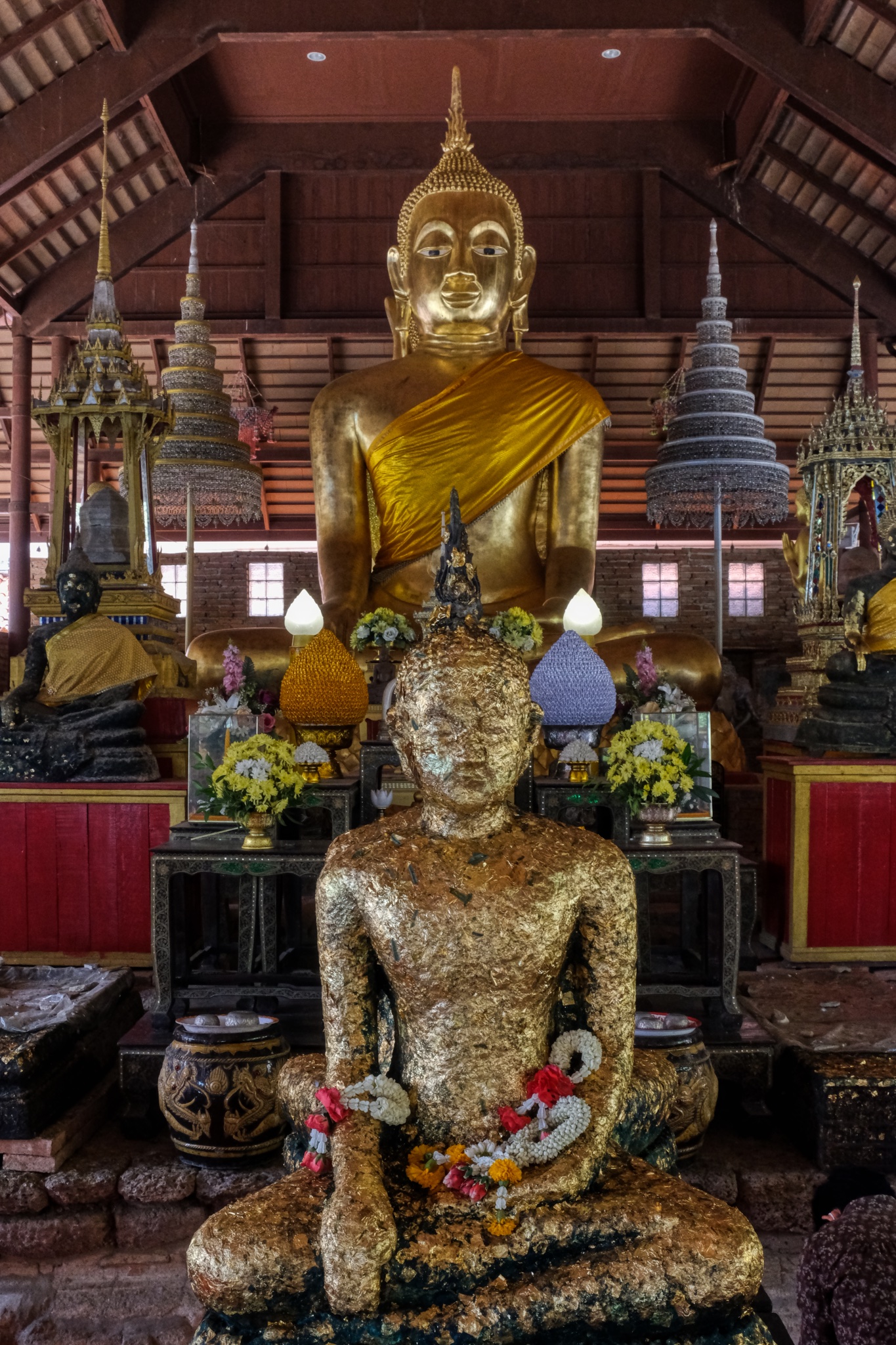 Buddha.
Buddha.
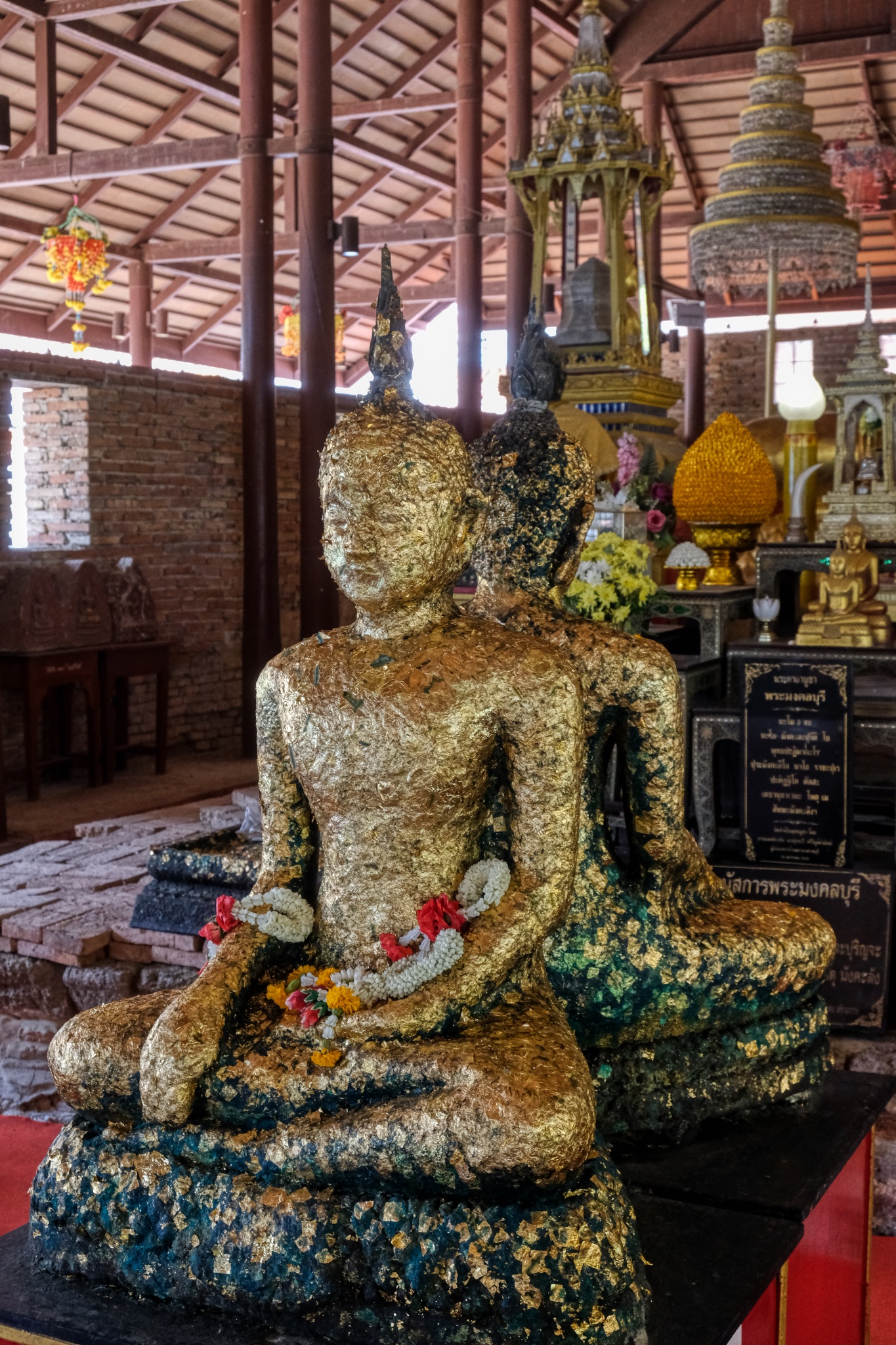 Devotees adorn Buddha images with gold leaf as a part of respectful practices. I was intrigued by these two Buddhas sitting back-to-back.
Devotees adorn Buddha images with gold leaf as a part of respectful practices. I was intrigued by these two Buddhas sitting back-to-back.
 When I looked up at the main, large Buddha image I noticed that it was also a double Buddha. It is very unusual to see two Buddhas sitting back-to-back.
When I looked up at the main, large Buddha image I noticed that it was also a double Buddha. It is very unusual to see two Buddhas sitting back-to-back.
 Normally only one Buddha sits in a Wat, and normally facing East.
Normally only one Buddha sits in a Wat, and normally facing East.
 They were extraordinarily beautiful Buddhas. My research turned this up:"It is a stucco Buddha image in the gesture of subduing Mara, which has a lap width of 8 Sok 1 Khuep. Its characteristic is of the Pre-Ayutthaya art, with a Sukhothai style face. It has a long body but short knees. He turns his face to the east, and there is another Buddha image behind his back, turning its face to the opposite side or the west. This means we ask the Buddha’s blessing to prevent danger from the front as well as the back." (citation)
They were extraordinarily beautiful Buddhas. My research turned this up:"It is a stucco Buddha image in the gesture of subduing Mara, which has a lap width of 8 Sok 1 Khuep. Its characteristic is of the Pre-Ayutthaya art, with a Sukhothai style face. It has a long body but short knees. He turns his face to the east, and there is another Buddha image behind his back, turning its face to the opposite side or the west. This means we ask the Buddha’s blessing to prevent danger from the front as well as the back." (citation)
 I left the Buddha hall to wander around the wat grounds.
I left the Buddha hall to wander around the wat grounds.
 Like many Thai wats, there are covered halls lined with Buddha images, often as markers for the cremated remains of former monks and doners, as is the case here.
Like many Thai wats, there are covered halls lined with Buddha images, often as markers for the cremated remains of former monks and doners, as is the case here.
 Such a beautiful sight.
Such a beautiful sight.
 In fact, there are several rows of these grave marking Buddha statues.
In fact, there are several rows of these grave marking Buddha statues.
 The Five Prangs. At the center of th Wat is a large courtyard enclosed by a cloister. At the center of the courtyard stand five massive parangs, known as "Phra Prang Ha Yod", or five peak prang. The Khmer/Lopburi style towers were constructed during the Sukhothai era.
The Five Prangs. At the center of th Wat is a large courtyard enclosed by a cloister. At the center of the courtyard stand five massive parangs, known as "Phra Prang Ha Yod", or five peak prang. The Khmer/Lopburi style towers were constructed during the Sukhothai era.

"Surrounded by four smaller ones, the tallest central prang rising over forty meters enshrines Buddha relics. Enshrined in large niches on all of its four faces are standing golden images of the Buddha. The brick plastered prangs, decorated with fine stucco work are topped with a trishula, a three pointed spear, the weapon of the Hindu God Shiva. Sheltering them is a small multi tiered ceremonial umbrella" (citation)
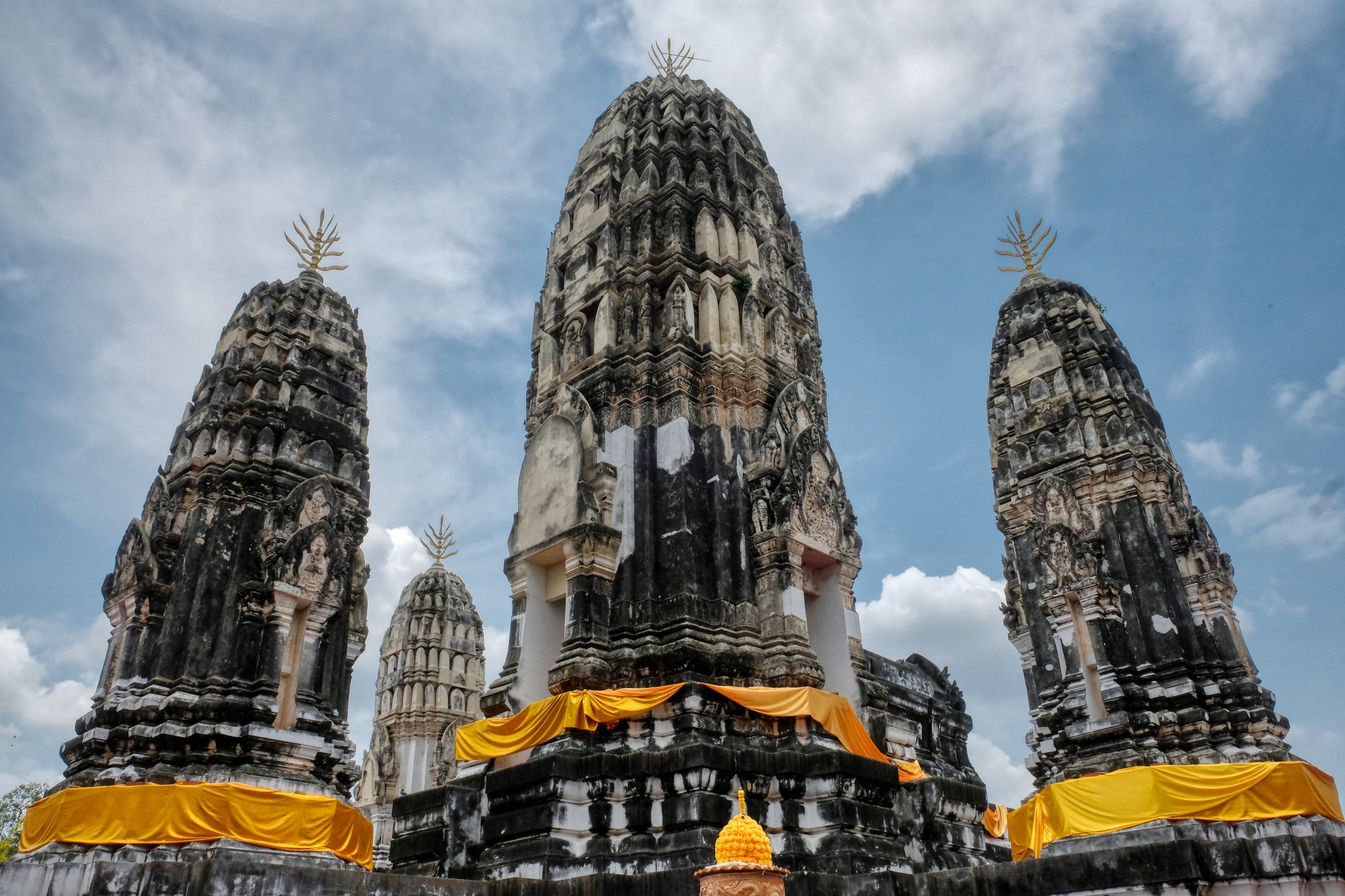 Extraordinary.
Extraordinary.
 Ah! A phone message from my wife: she is on the 16th hole. Time for me to leave this amazing place. I headed back out along the Buddha colonnades.
Ah! A phone message from my wife: she is on the 16th hole. Time for me to leave this amazing place. I headed back out along the Buddha colonnades.
 A wide variety of Buddha images present.
A wide variety of Buddha images present.
 A fine reminder about my mortality and a questioning about what I am doing with my conscieness.
A fine reminder about my mortality and a questioning about what I am doing with my conscieness.
 One last grotto . . . to visit a reclining Buddha.
One last grotto . . . to visit a reclining Buddha.
 Such a beautiful display. An old 'nun' altar keeper offered me a bottle of water here, which I took. It was a hot day!
Such a beautiful display. An old 'nun' altar keeper offered me a bottle of water here, which I took. It was a hot day!
 I lingered in this space to pay my respect to the Buddha. I also left my donation here.
I lingered in this space to pay my respect to the Buddha. I also left my donation here.
 My last stop. Then the 25 minute drive to pick up my wife at the golf course and the 1 hour 45 minute drive back to Hua Hin. A wonderful day . . . .
My last stop. Then the 25 minute drive to pick up my wife at the golf course and the 1 hour 45 minute drive back to Hua Hin. A wonderful day . . . .
 Back on the balcony for a gin & tonic and this strange blue sea . . .
Back on the balcony for a gin & tonic and this strange blue sea . . .